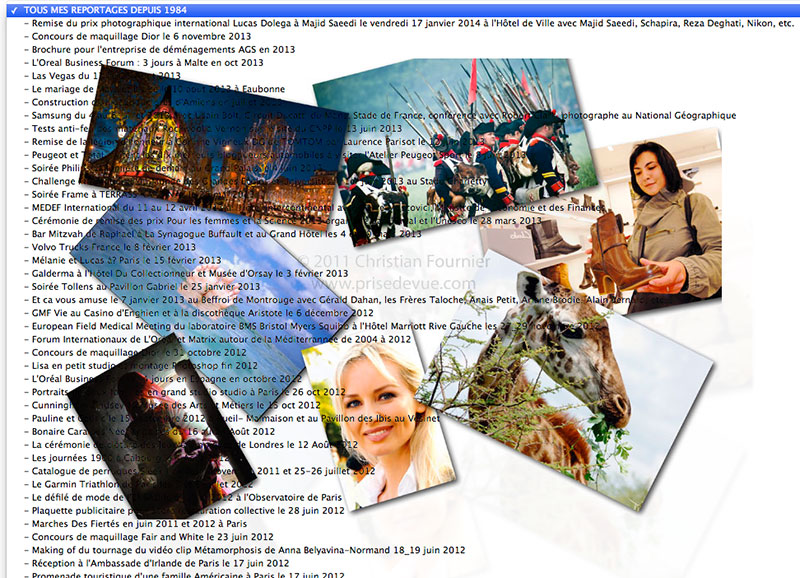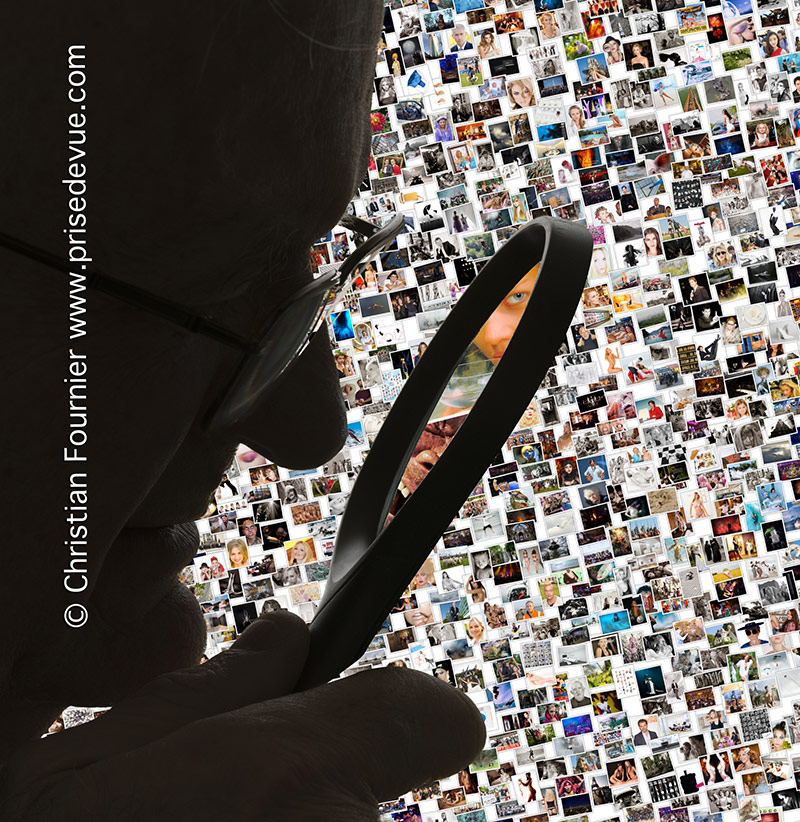Page 26: I go glacier climbing in Alaska.
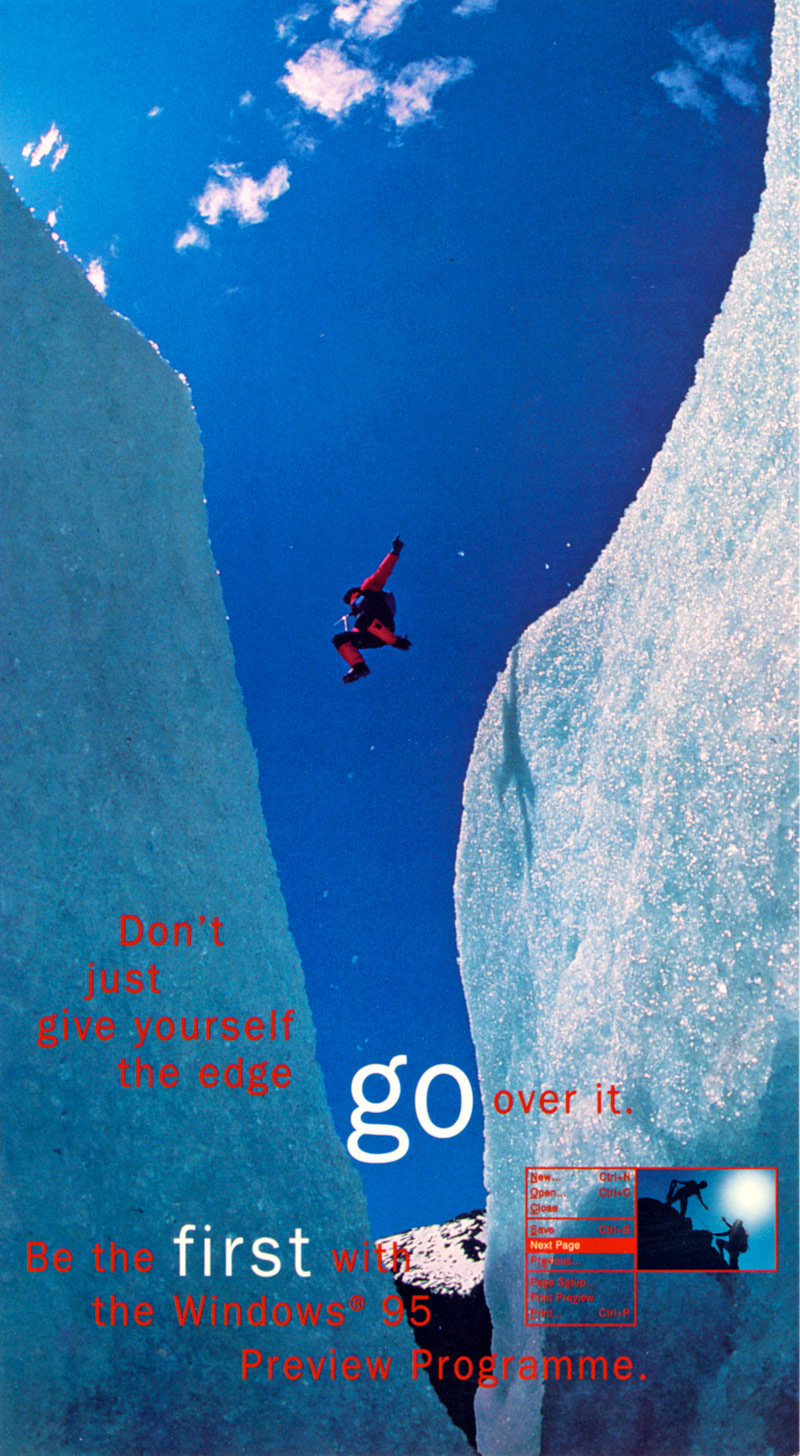
I go glacier climbing in Alaska. Thanks to Barrie Moss for the introduction to this sport. Barrie managed to make me overcome my vertigo. Most of the photos where I appear are taken by Barrie. I spent 4 summers in Alaska: 1983, 1984, 1985, 1987. Juneau, Mendenhall Glacier, Skagway, Ketchikan, Glacier Bay, Tracy Arms, Whittier, Arctic 1984 from Bettles, population 12, near the North Pole, Encounter with a bear, polybagging, swimming across a frozen lake without clothes, are sounds that still make me vibrate. With Jim Ackers (R.I.P.), Jamie Harrison, Allen Jollen, Dr Nicole Bordes, Shannon Templeton, Doug Plews, Dede Tabor, Laurie Young, Nick Llellelyn, Monique Quevillon, Charlie Dawson (R.I.P.). Blue glaciers in black and white, it was long before Sebastião Salgado.
|
| During all my childhood (1953-1980), I suffered from severe asthma, which runs in my family, so I was not allowed to do any sports, not even run on the school playground. So I have no idea, even now, what pommel horse, still rings, vault, parallel bars, and the high bar are all about, or even kicking a ball, etc. … Very sad. But later, as I got to the USA, got my revenge and went scuba diving, glacier climbing, horse riding, sailing, parachuting, water skiing all over the world. |
One of my photos was used to support the ad campaign for the launch of Windows 95. I’m more of a Mac-user, but the “client is king”, the customer is always right.
|
Color photos are below, along with captions and many more photos.
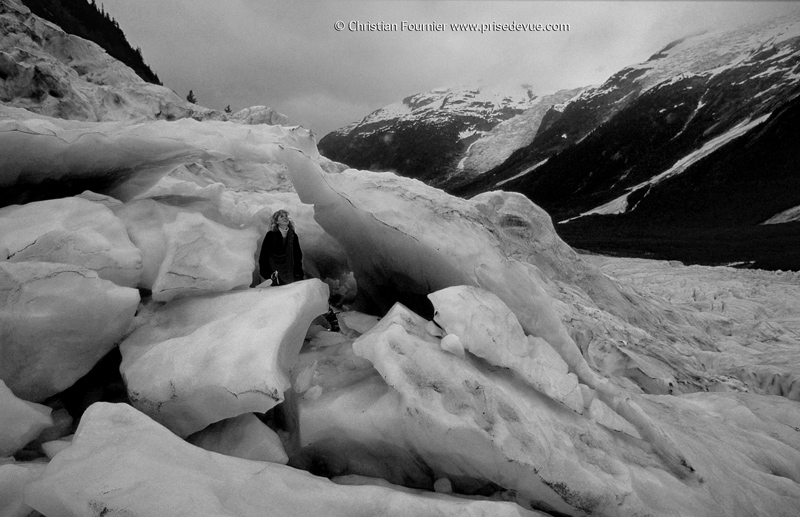
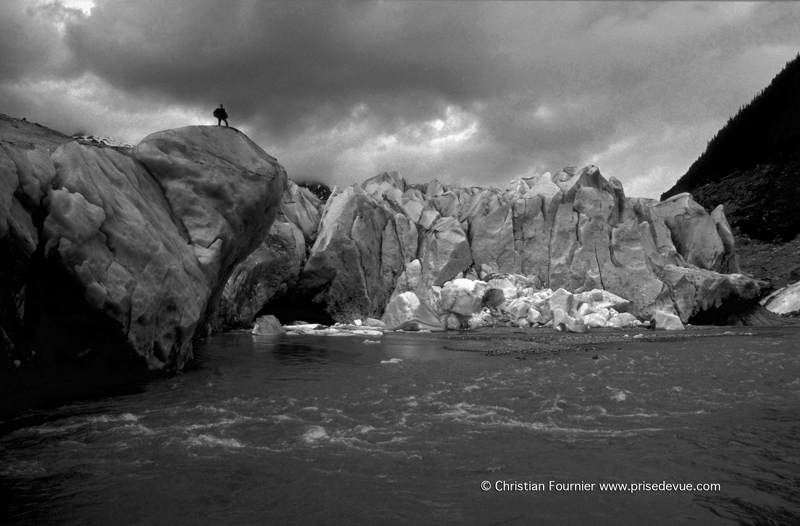
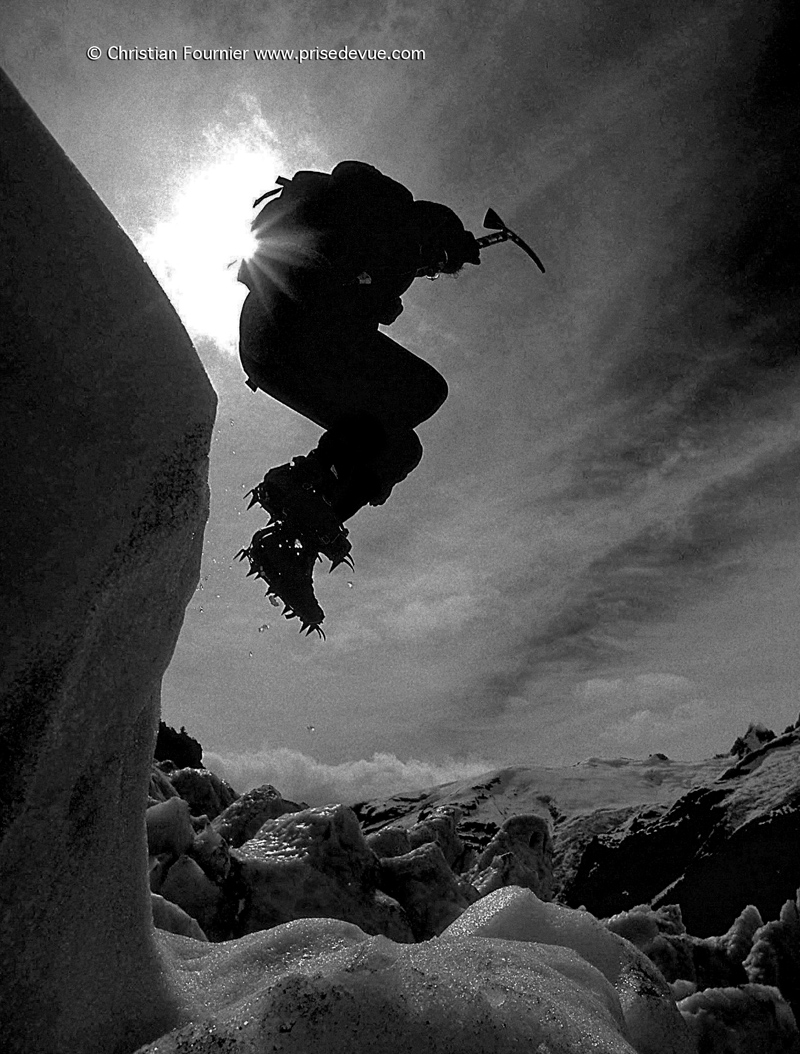

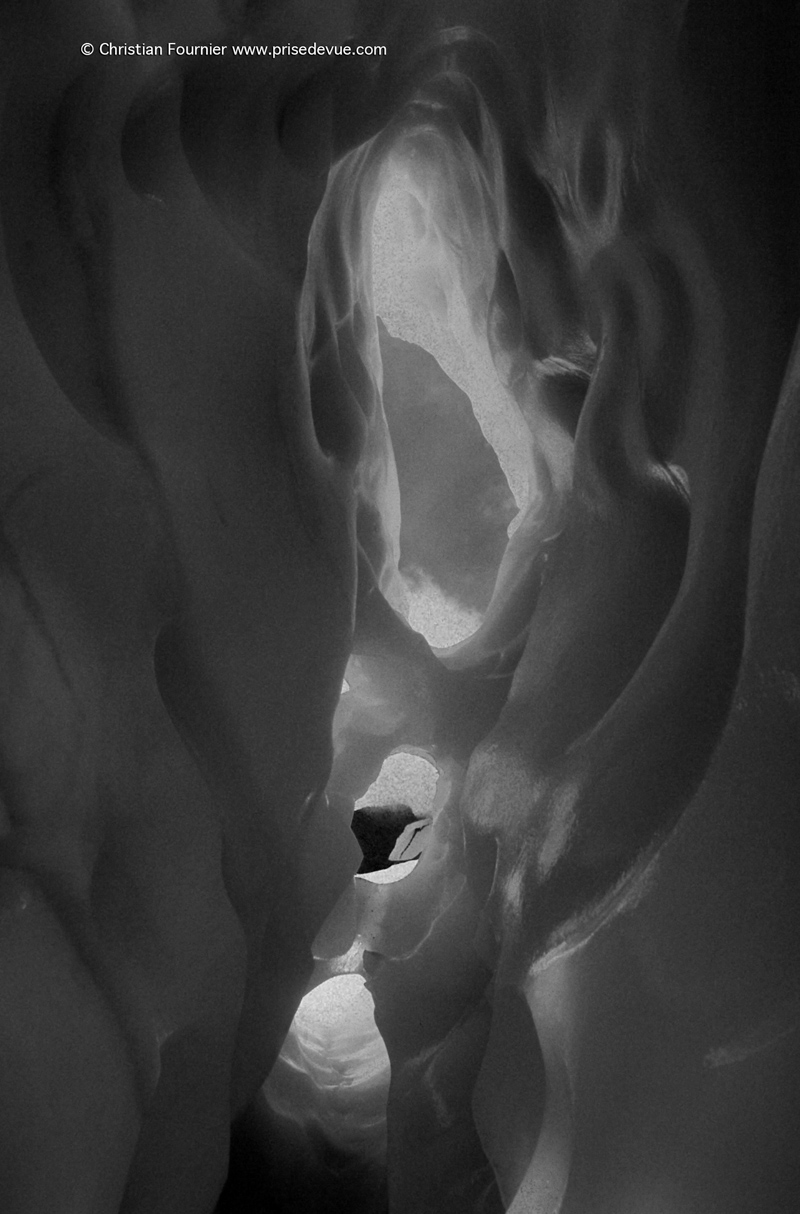
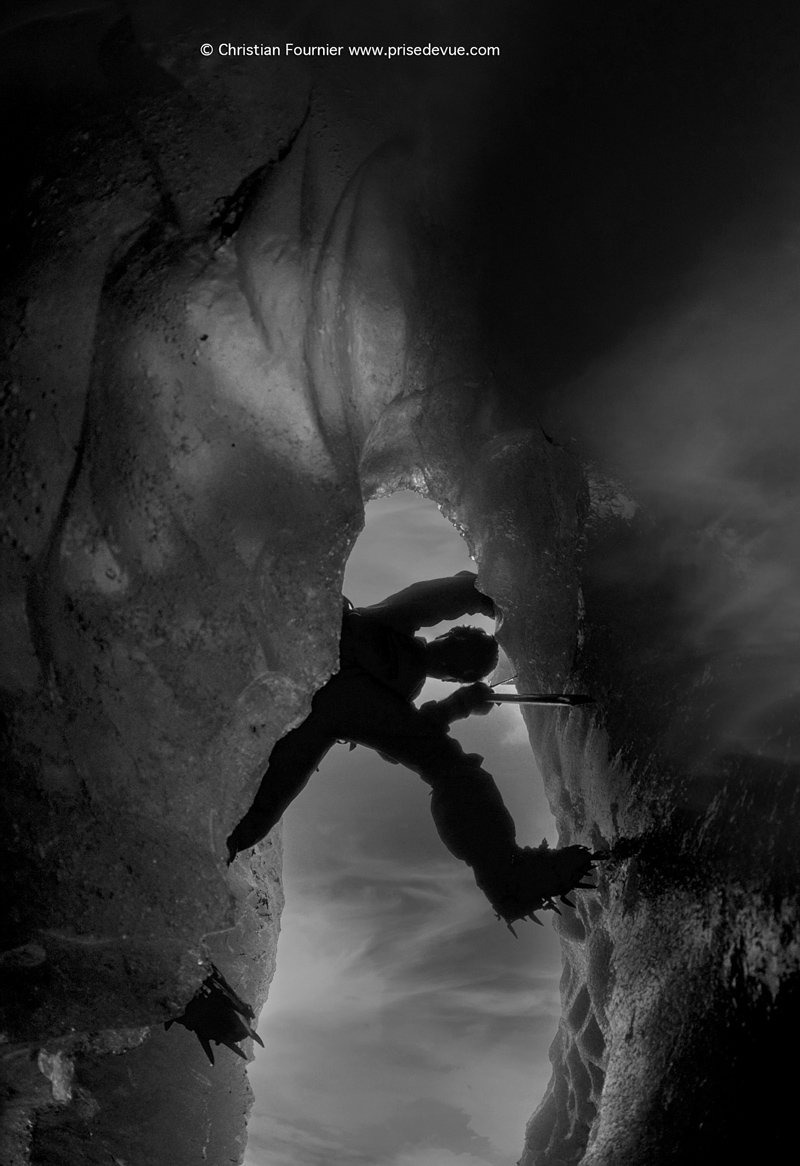

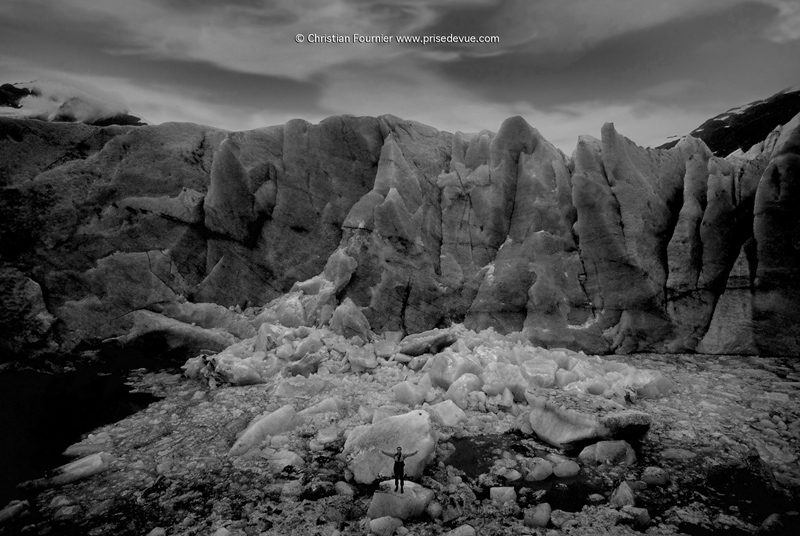
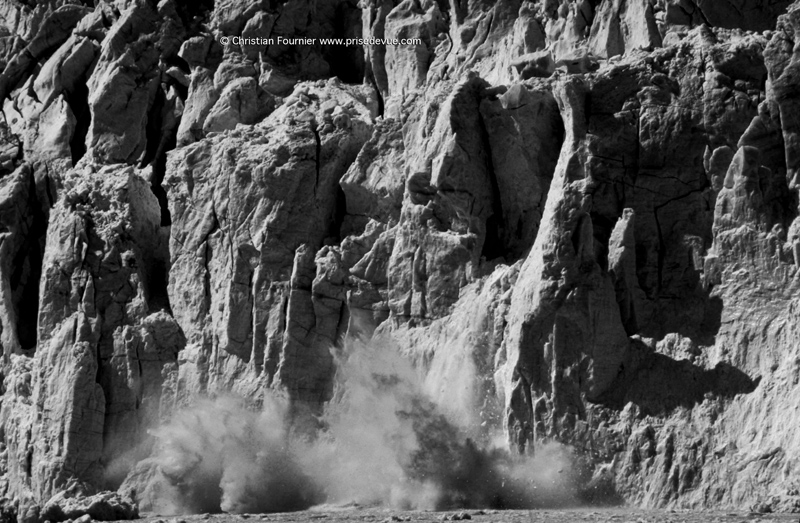
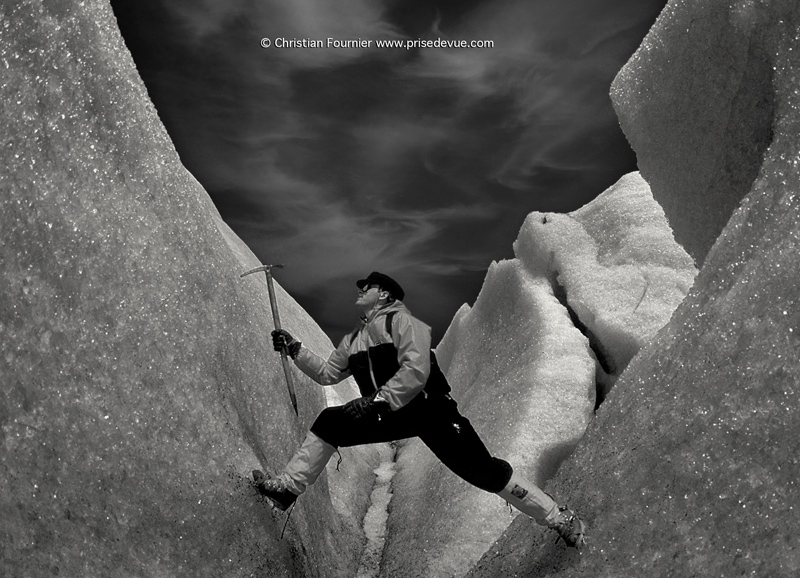
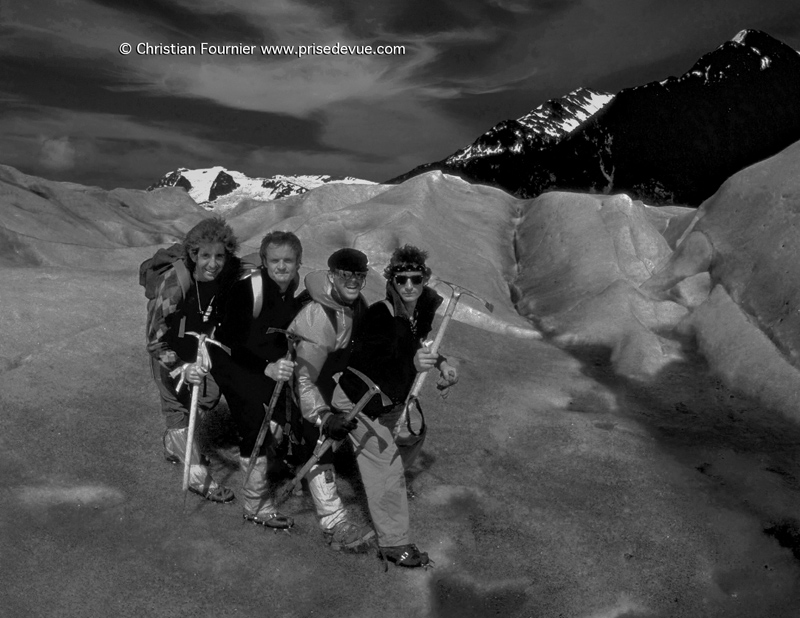


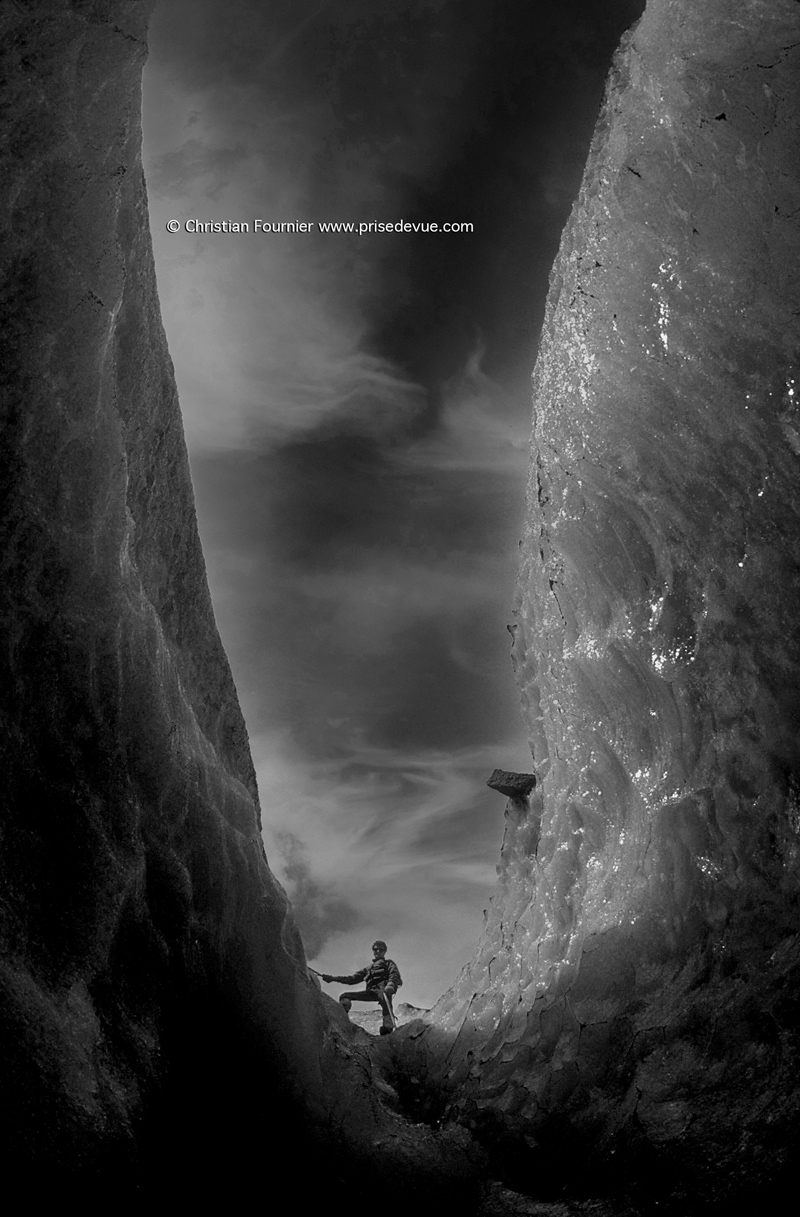
Barrie
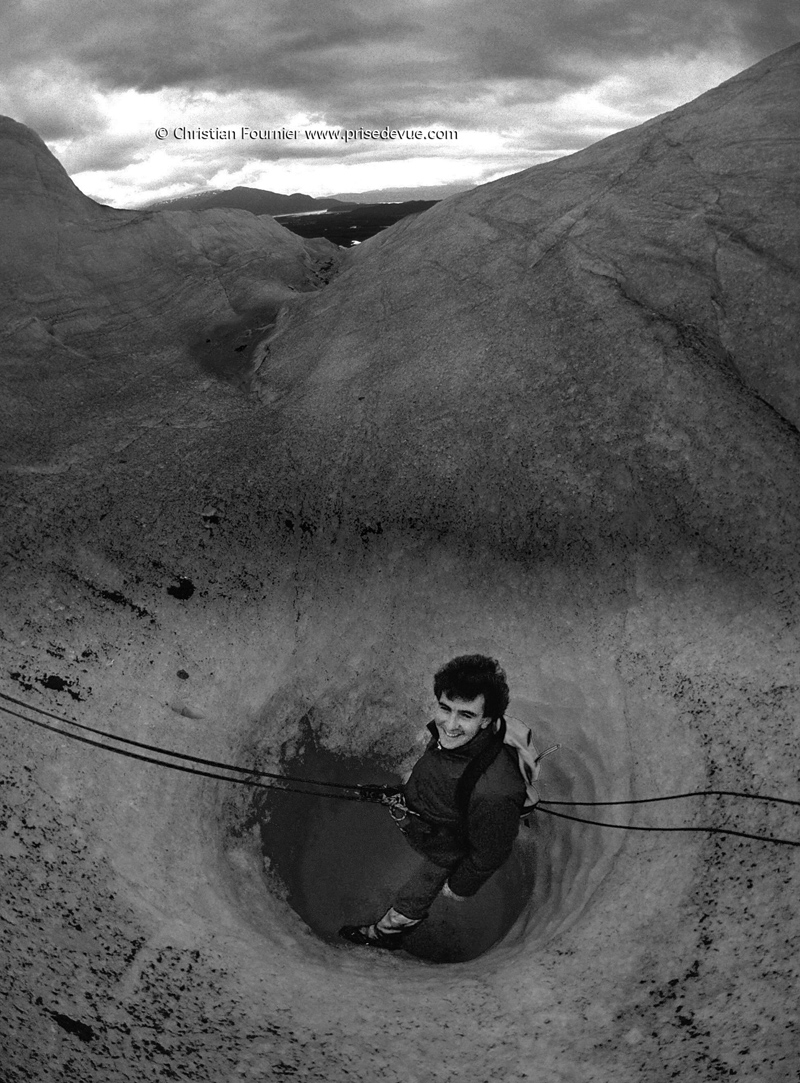
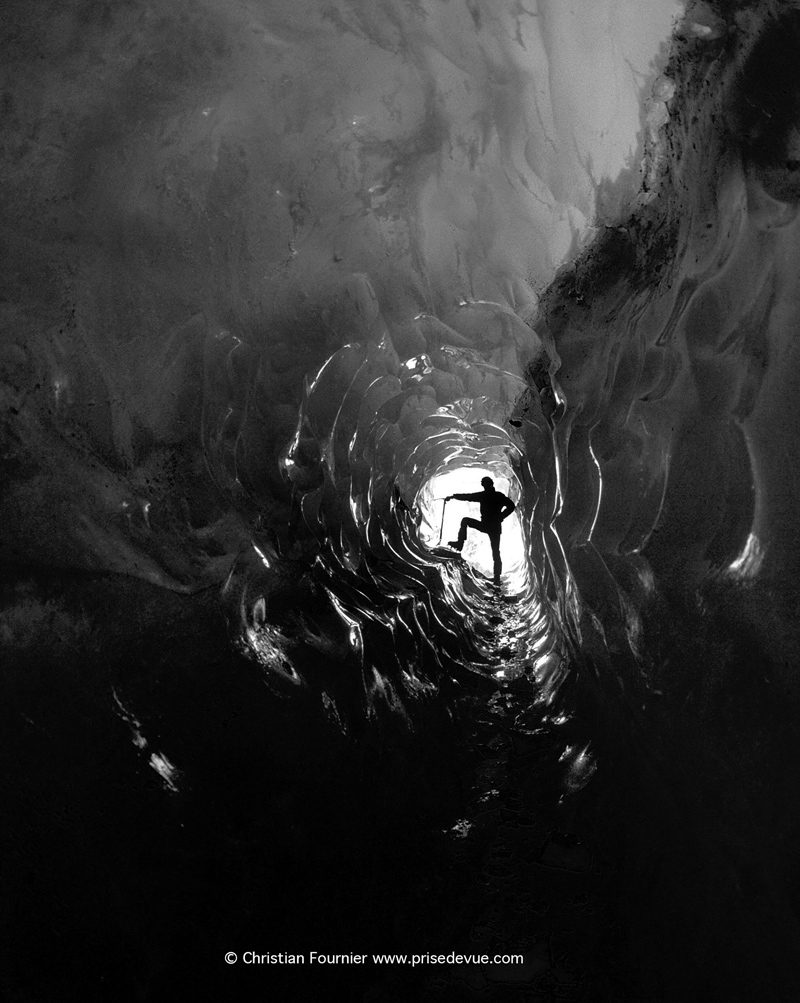
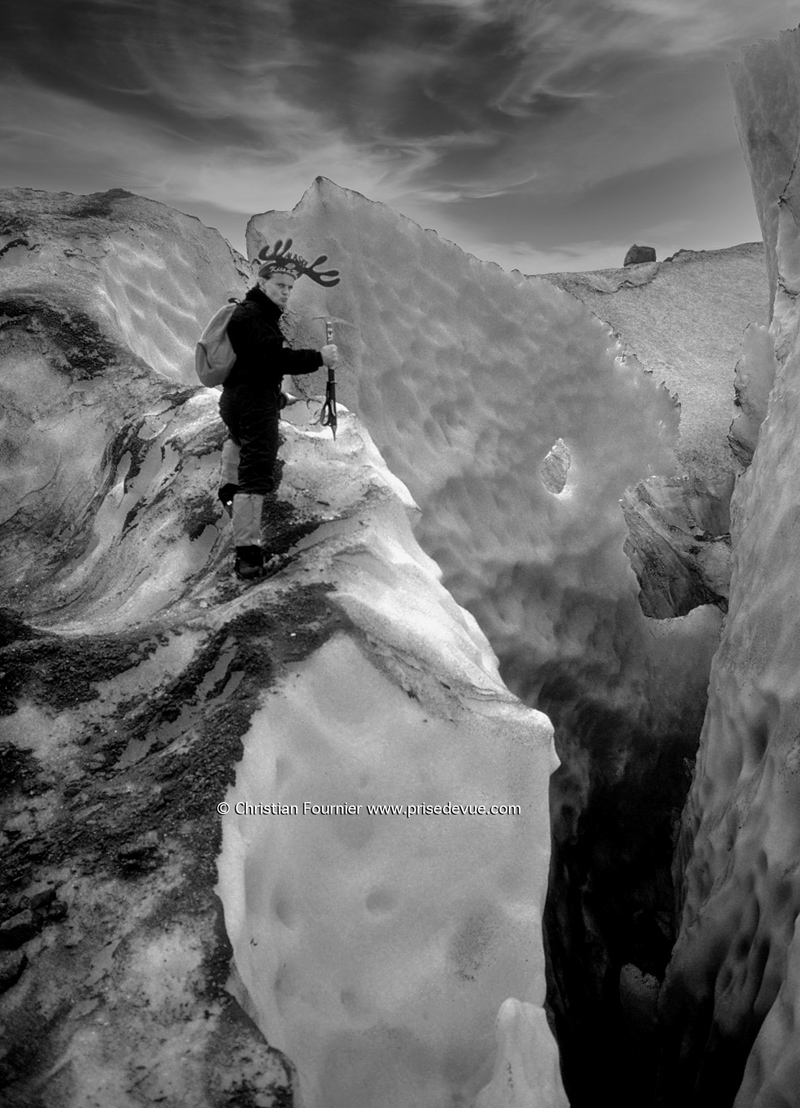

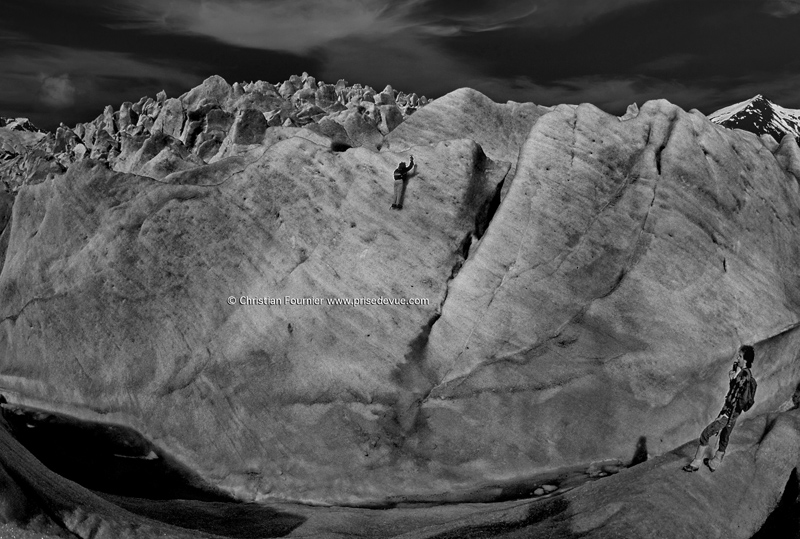
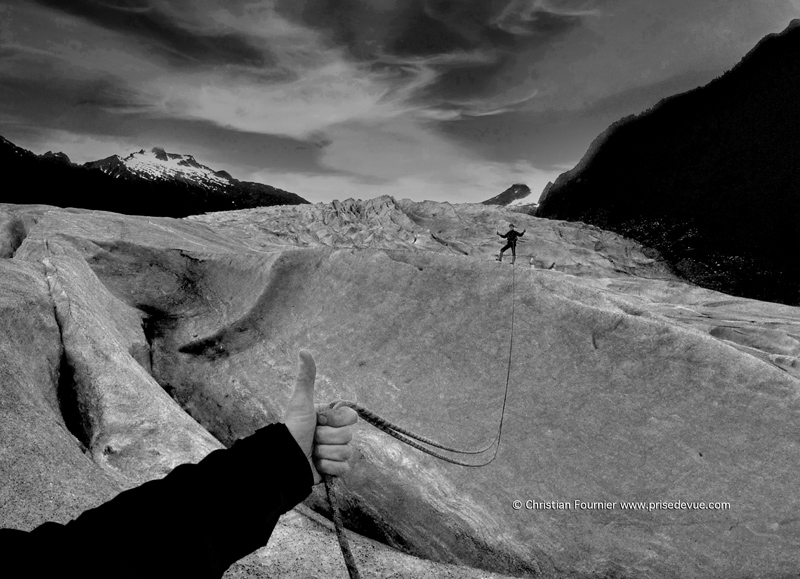
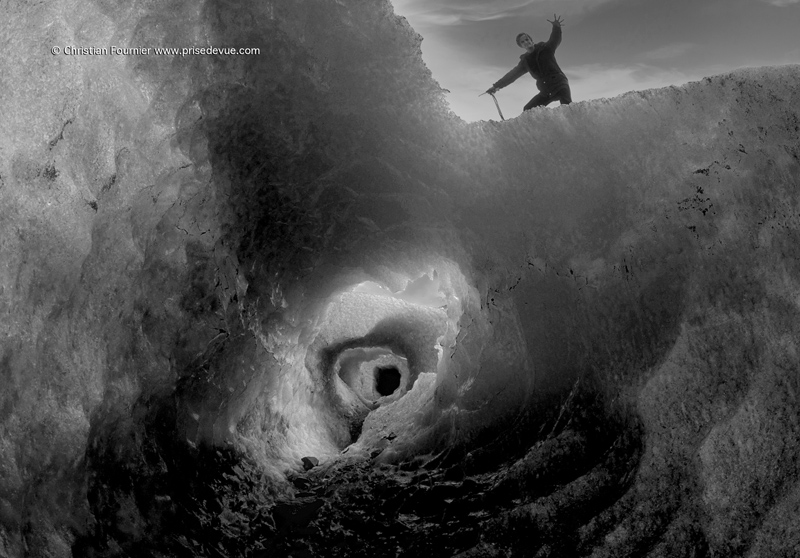
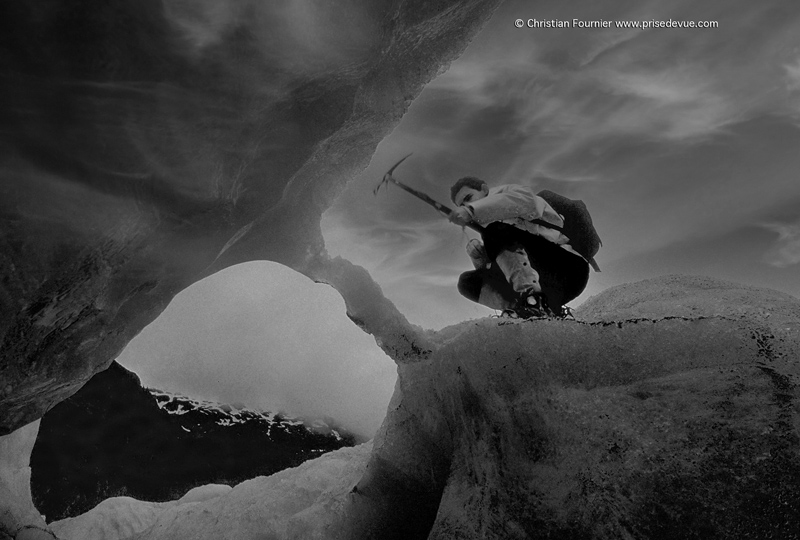

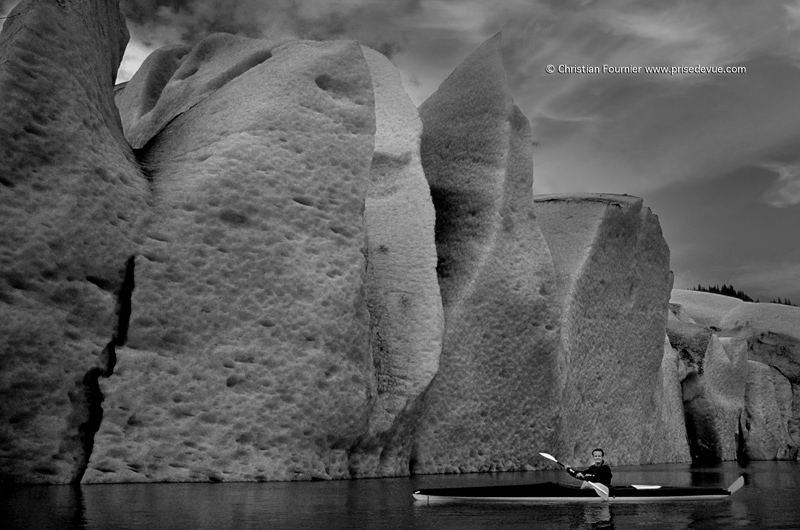
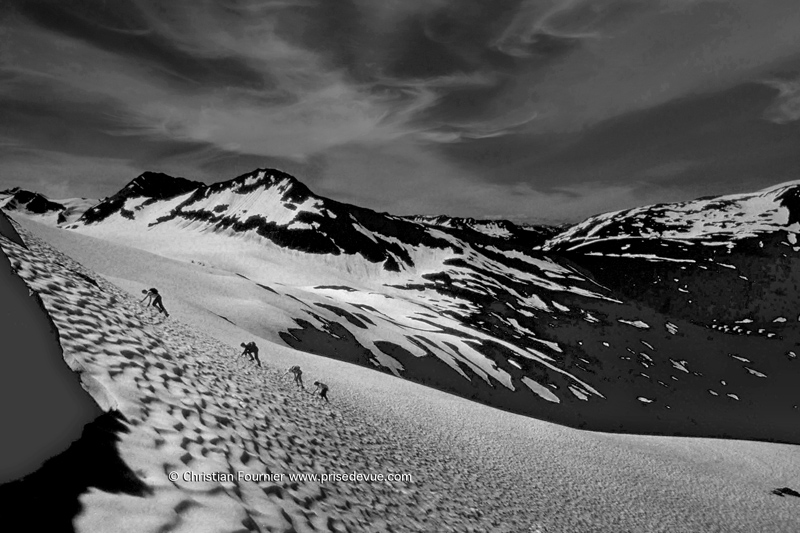
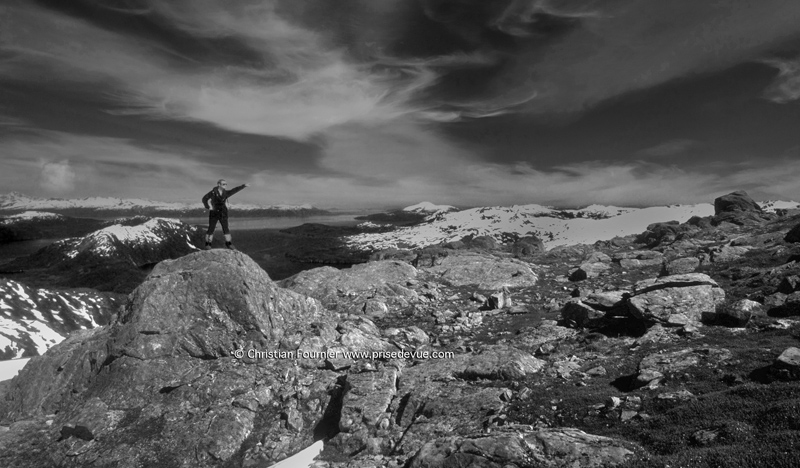
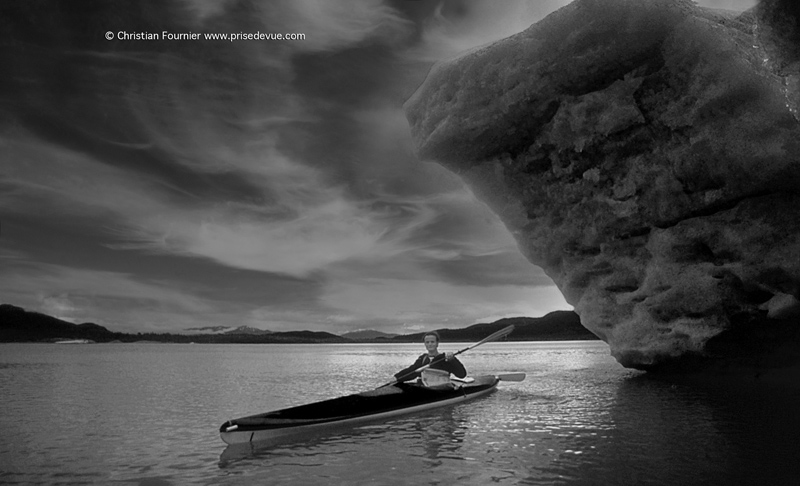
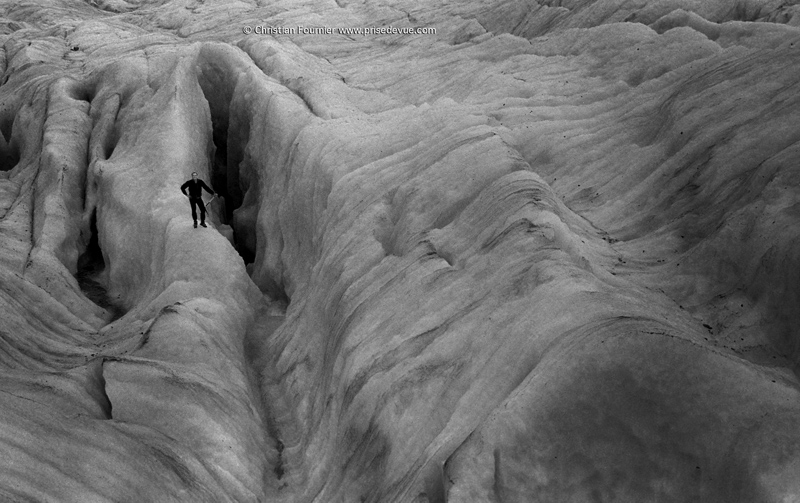
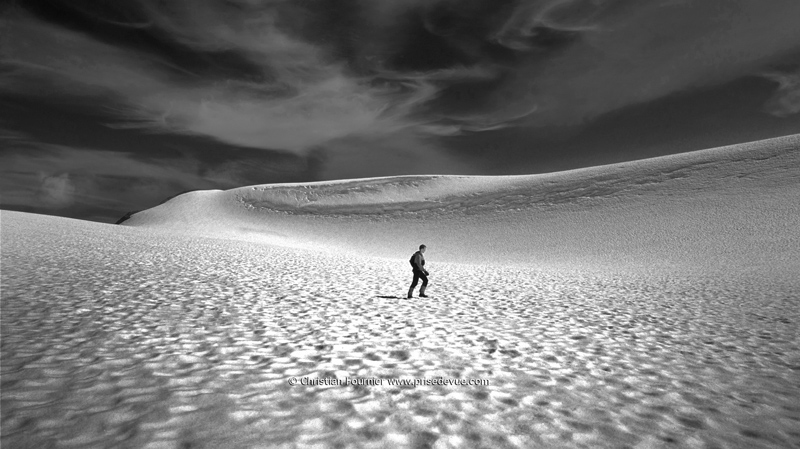
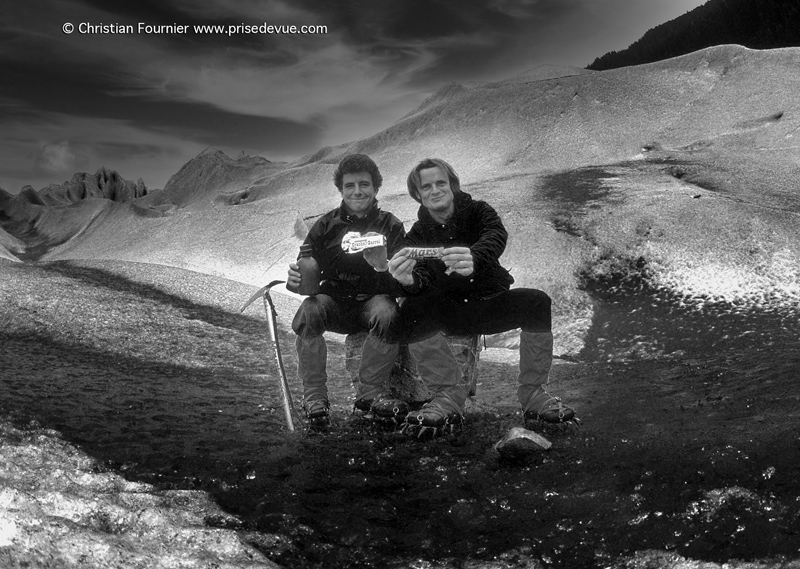
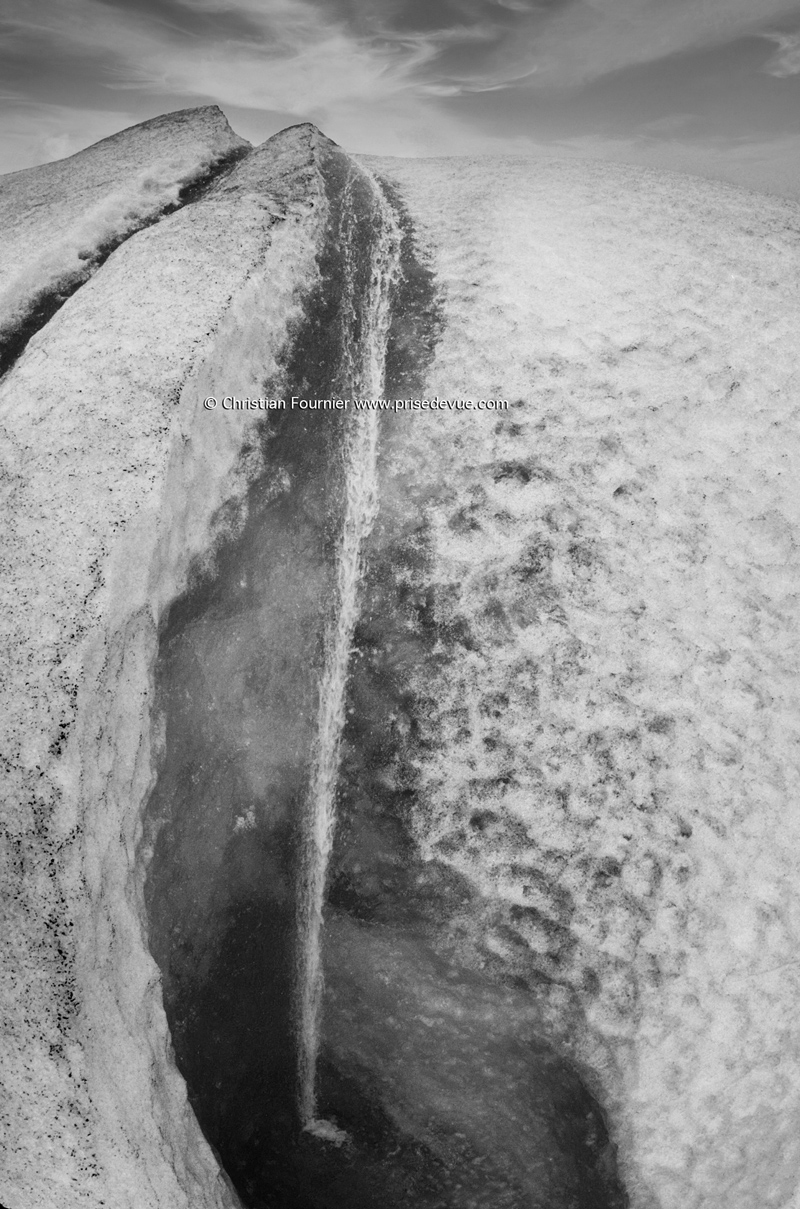

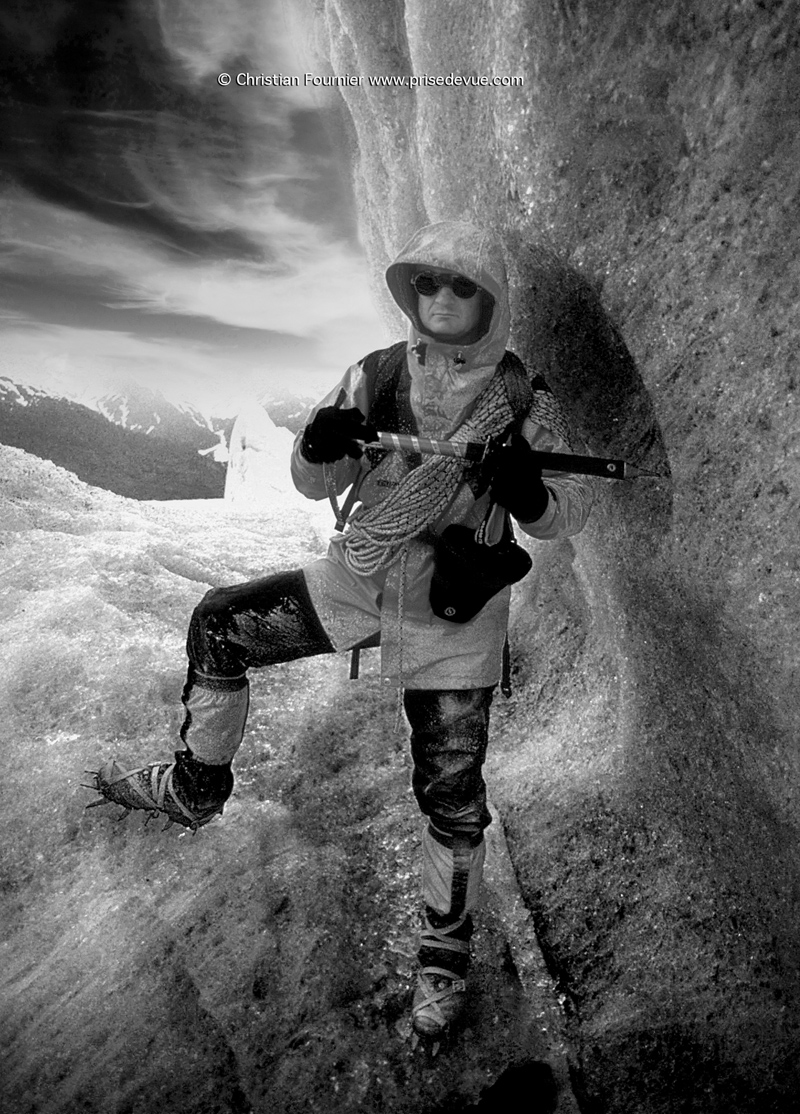


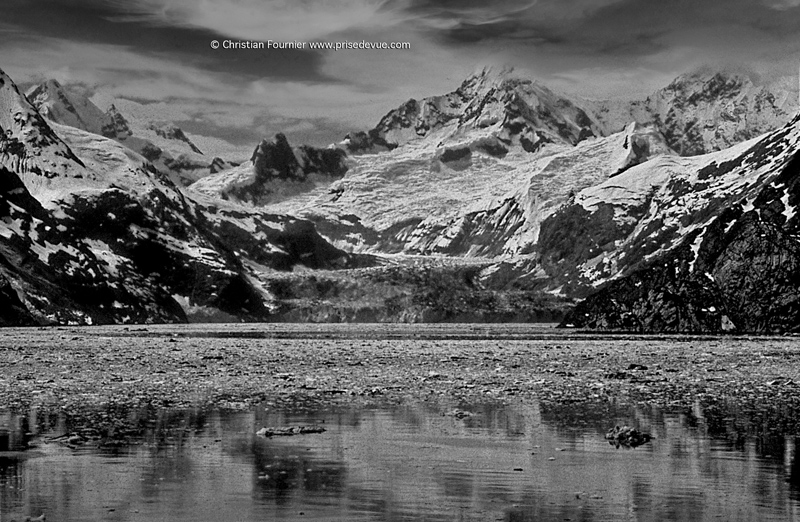

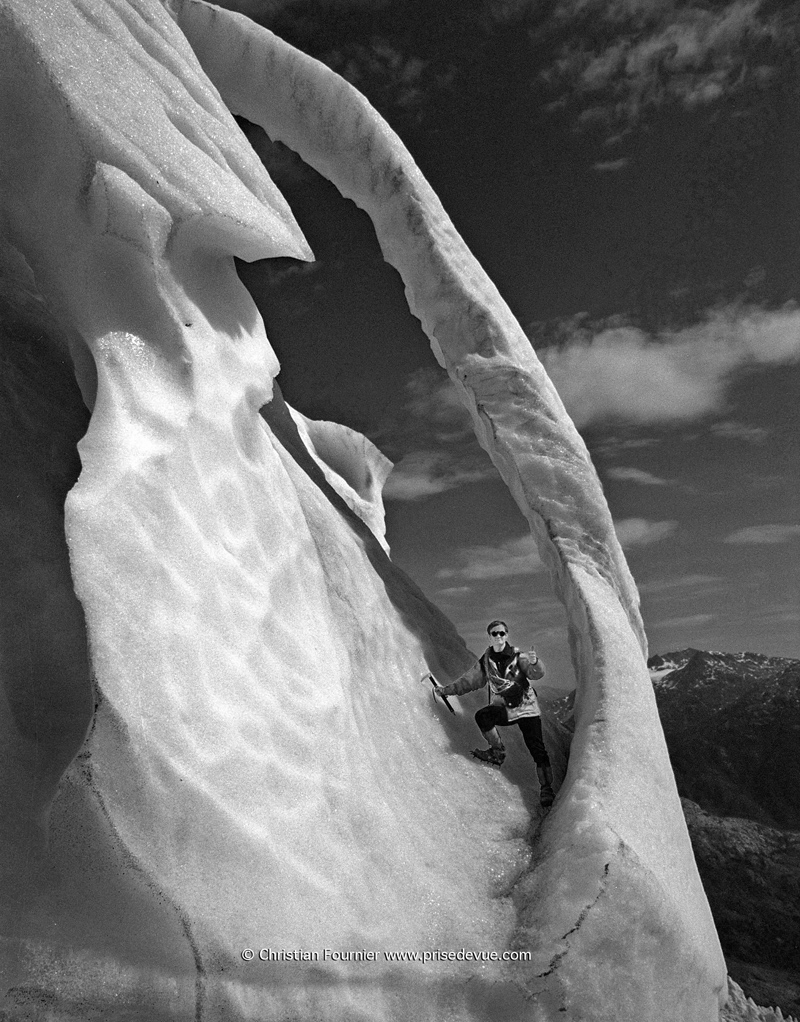
|
Now in color with more photos and the captions.. |
Thanks again, Barry. In fact most of the photos where I appear were taken by Barry, so thank you once again.
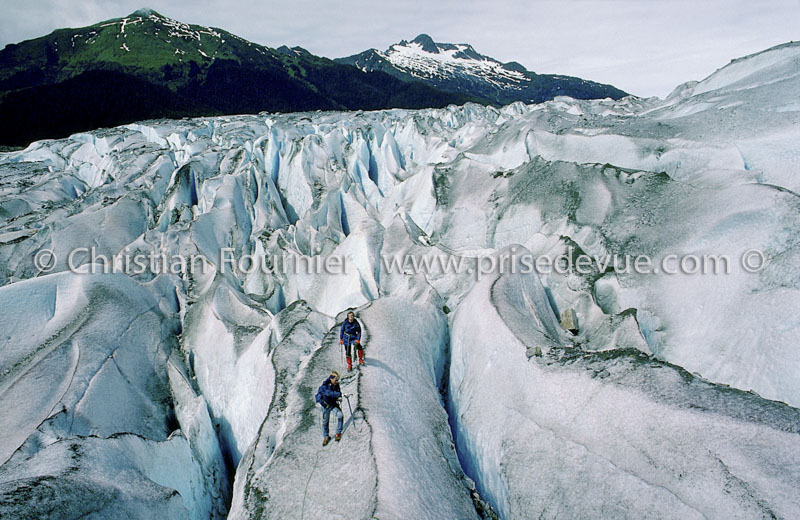
Mendenhall Glacier. Jim Ackers and me. Jim siad : "If I die, my mother will be pissed off."
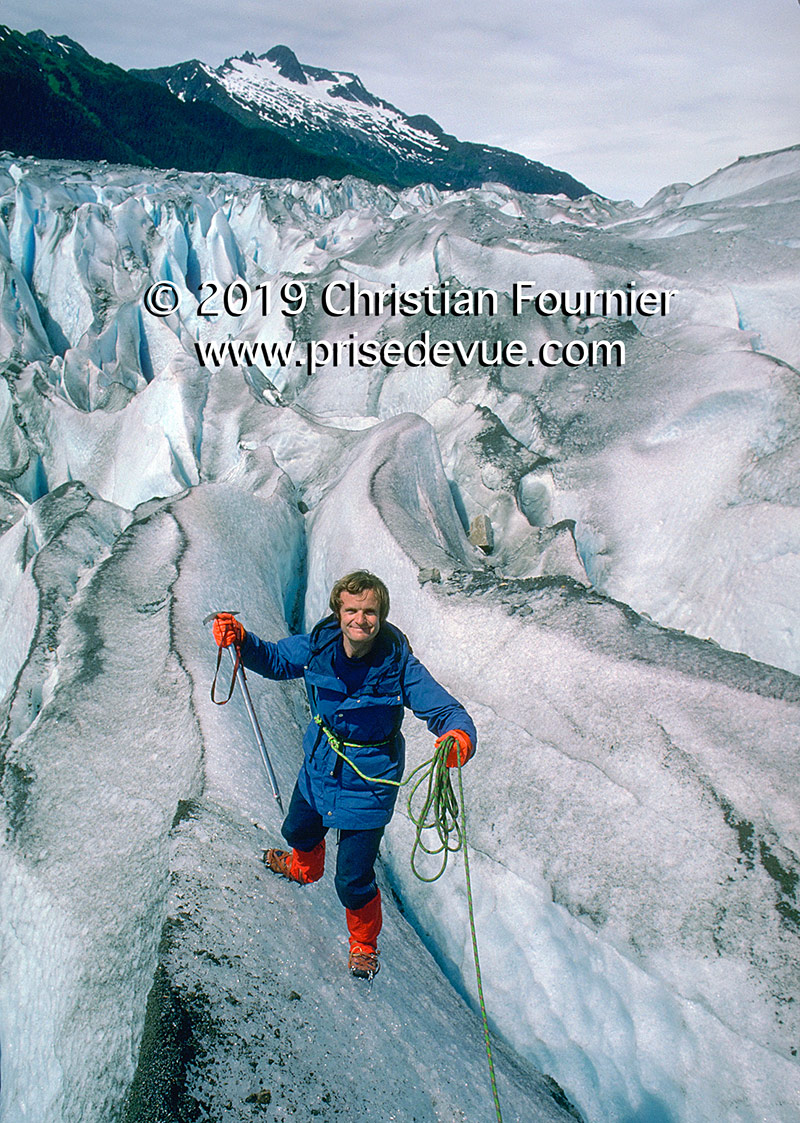
|
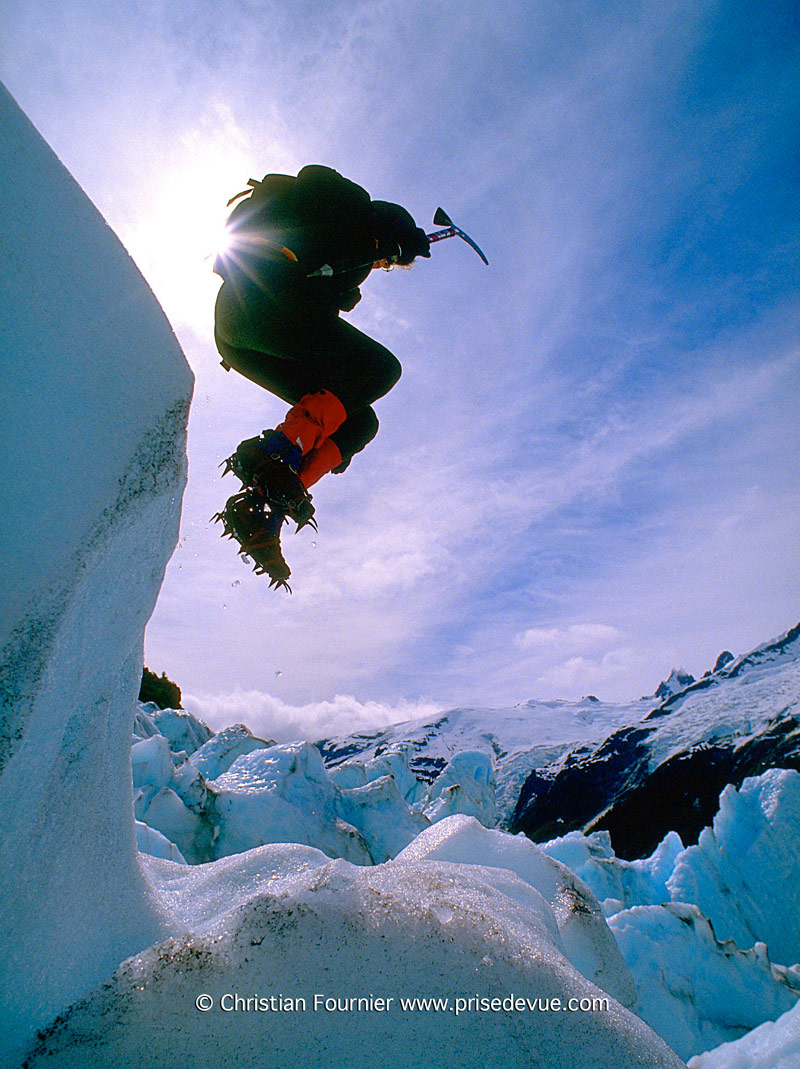
Jamie Harrison: « Alaska was awesome. I used
to go ice climbing on glaciers, rafting on the Yukon, gold
digging. Did something every week - thanks to Christian
Fournier. Best place I ever went! »
|
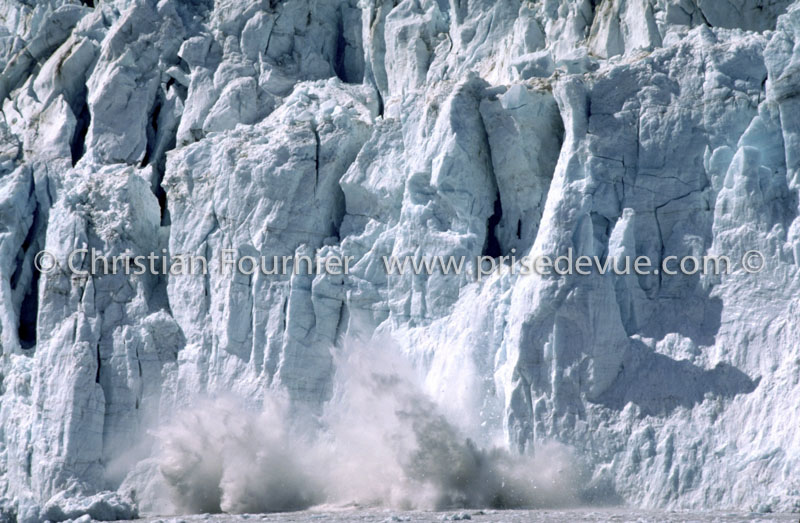
Glacier Bay
|
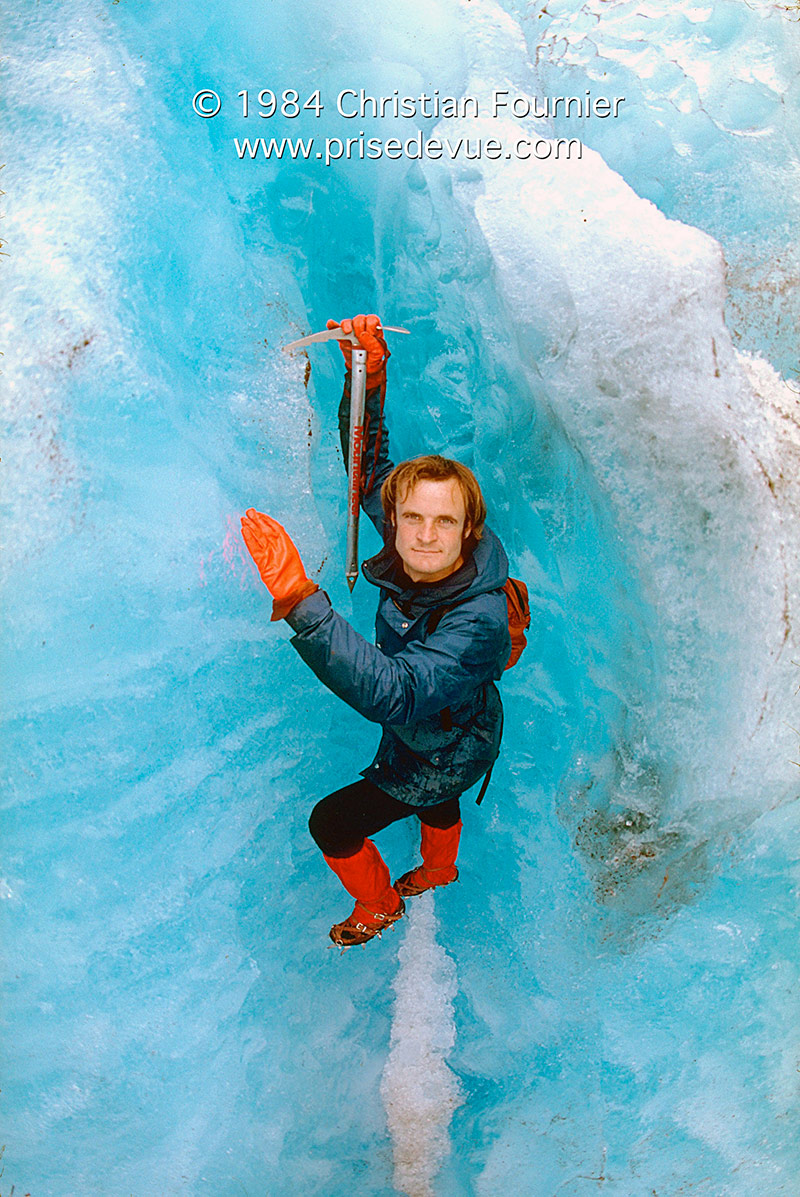
Your humble photographer and narrator. |
Glacier climbing in Alaska:
thank you Barry Moss for introducing me to this sport. He
managed to make me overcome my vertigo. I spend 4 summers in
Alaska. Here is Mendenhall Glacier, near Juneau. The friend in
the middle is Tony.
Shannon Templeton: "And thank you for taking me on my
first glacier experience! Those are memories I will never
forget."
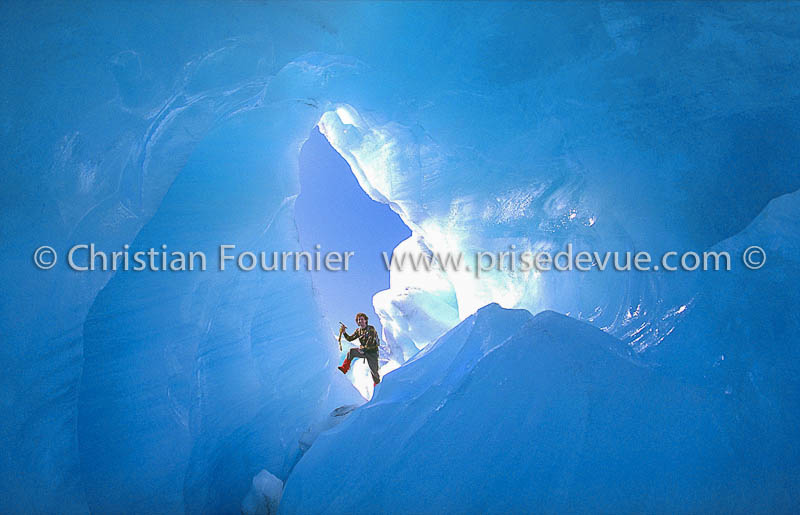 |
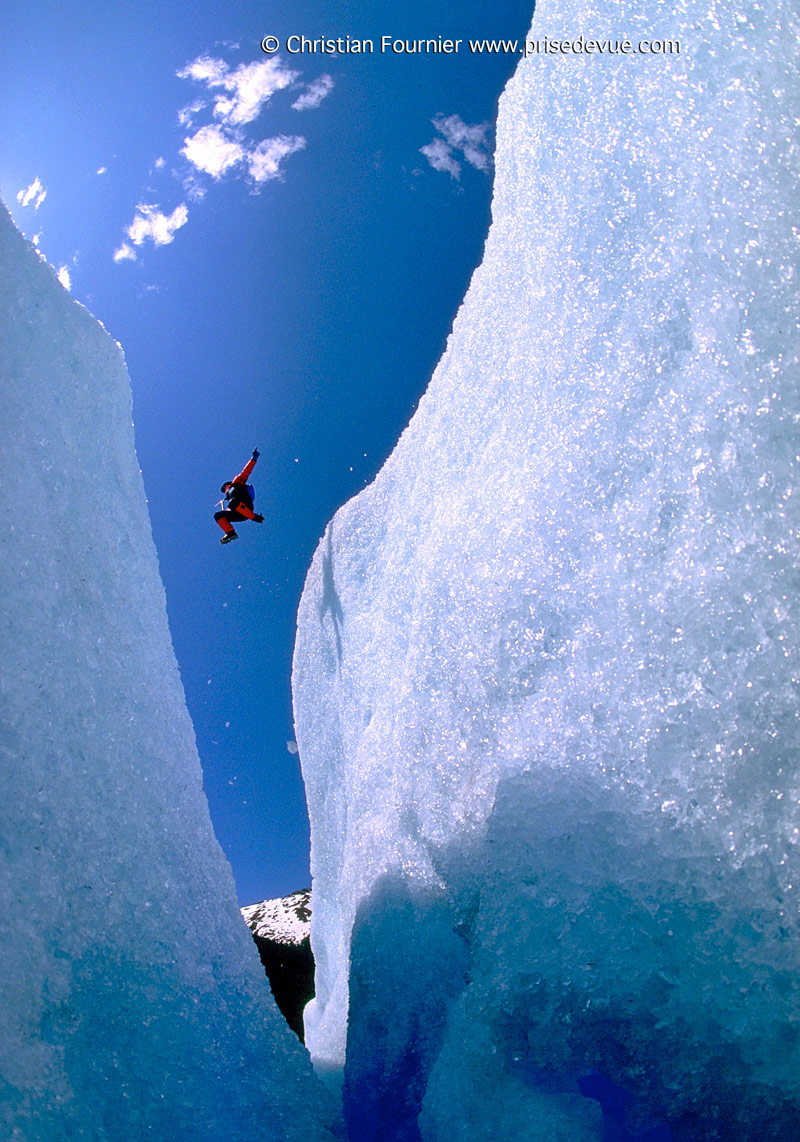
Allen Jollen’s infamous leap
|
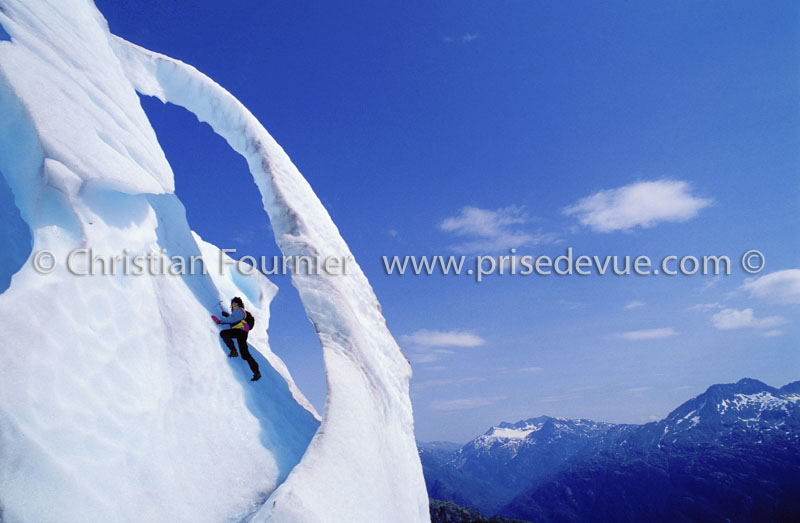
Dr Nicole Bordes
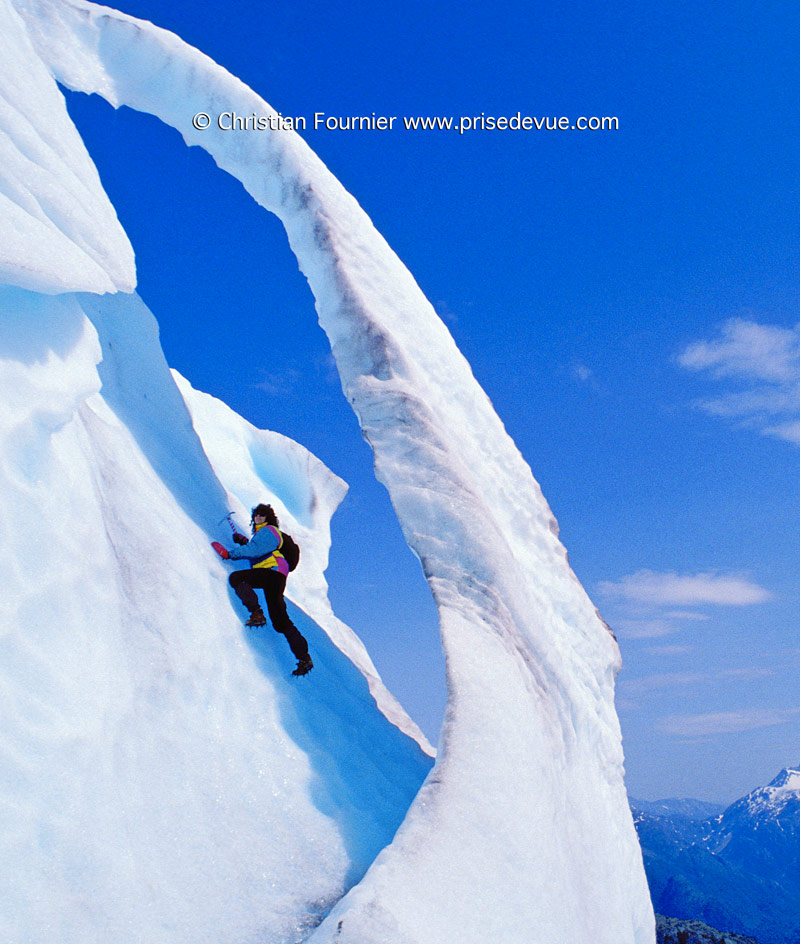 |
Shannon Templeton: "And
thank you for taking me on my first glacier experience! Those
are memories I will never forget."
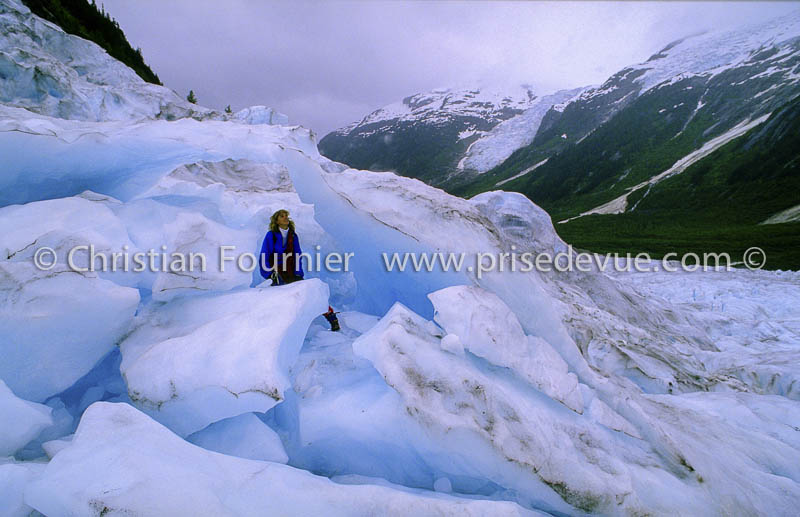
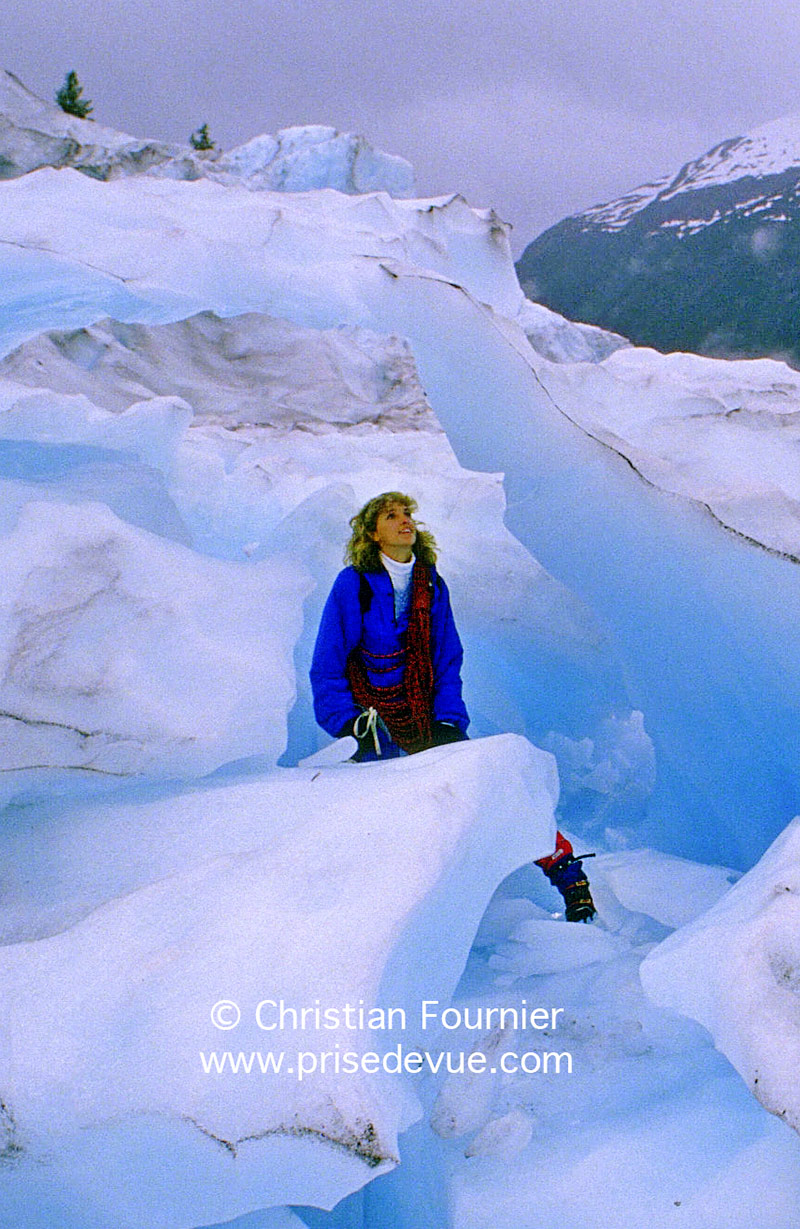 |
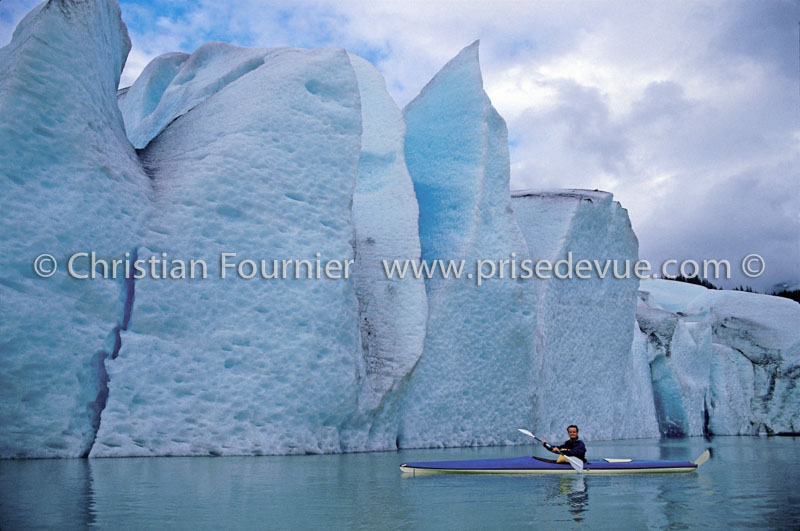
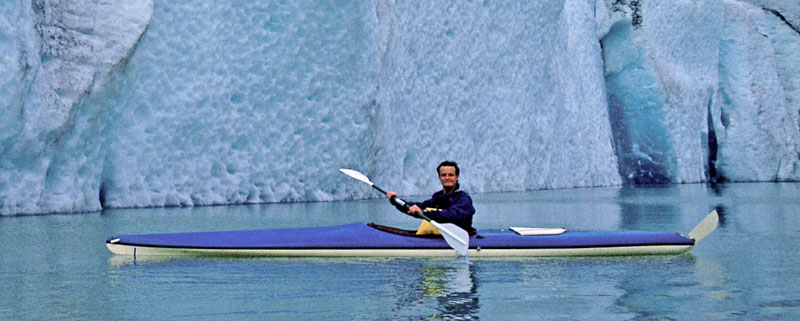
Your humble photographer and narrator, Christian Fournier
|

|

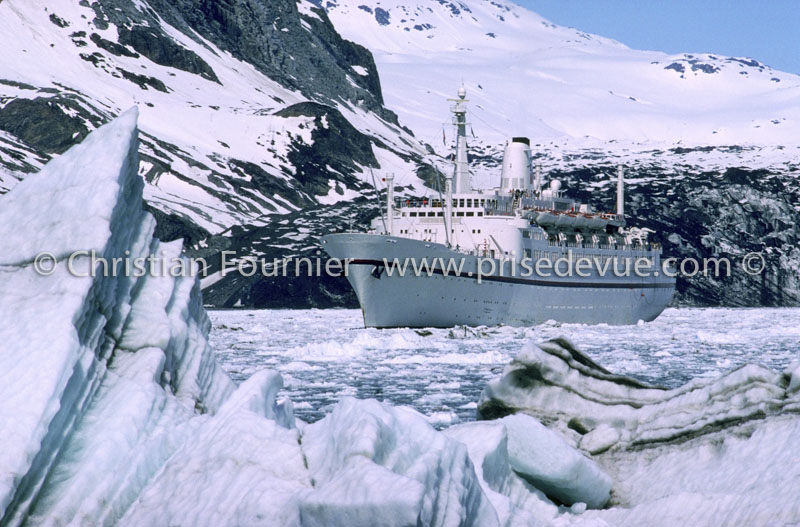
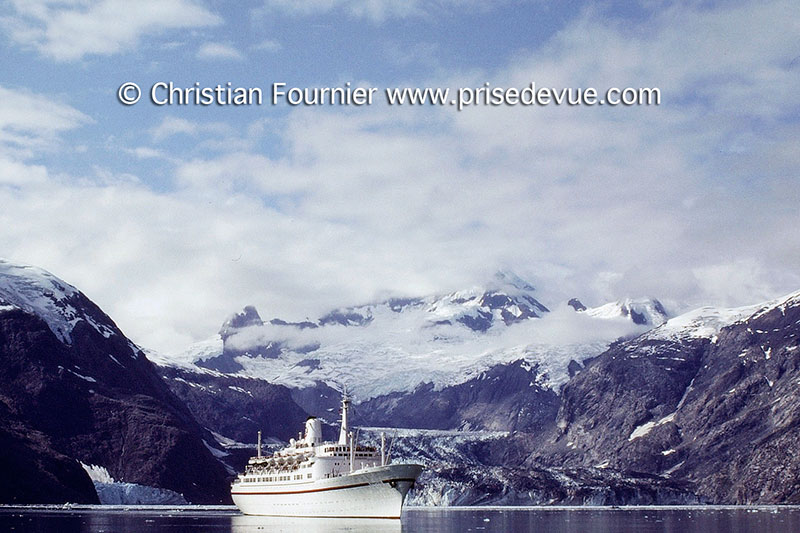
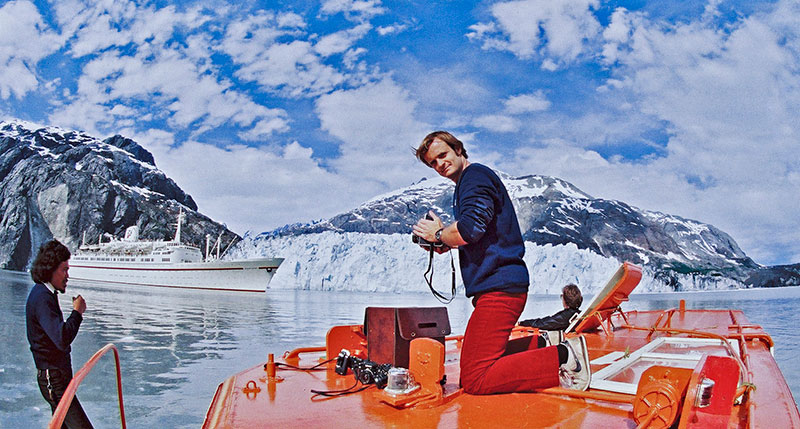
Tell me what other profession would have allowed me to command
a captain to position his 24000 ton ship in the best spot for a
photo?
|
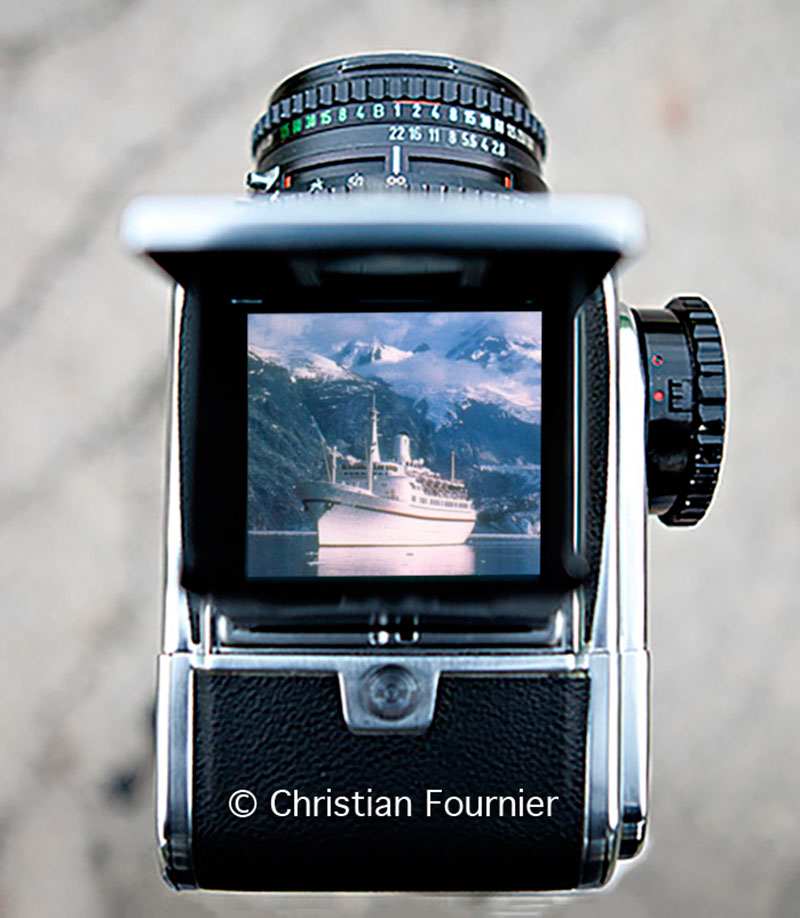
The image in the viewfinder (here the waist level hood) of the
Hasselblad 500cm is inverted horizontally.
|
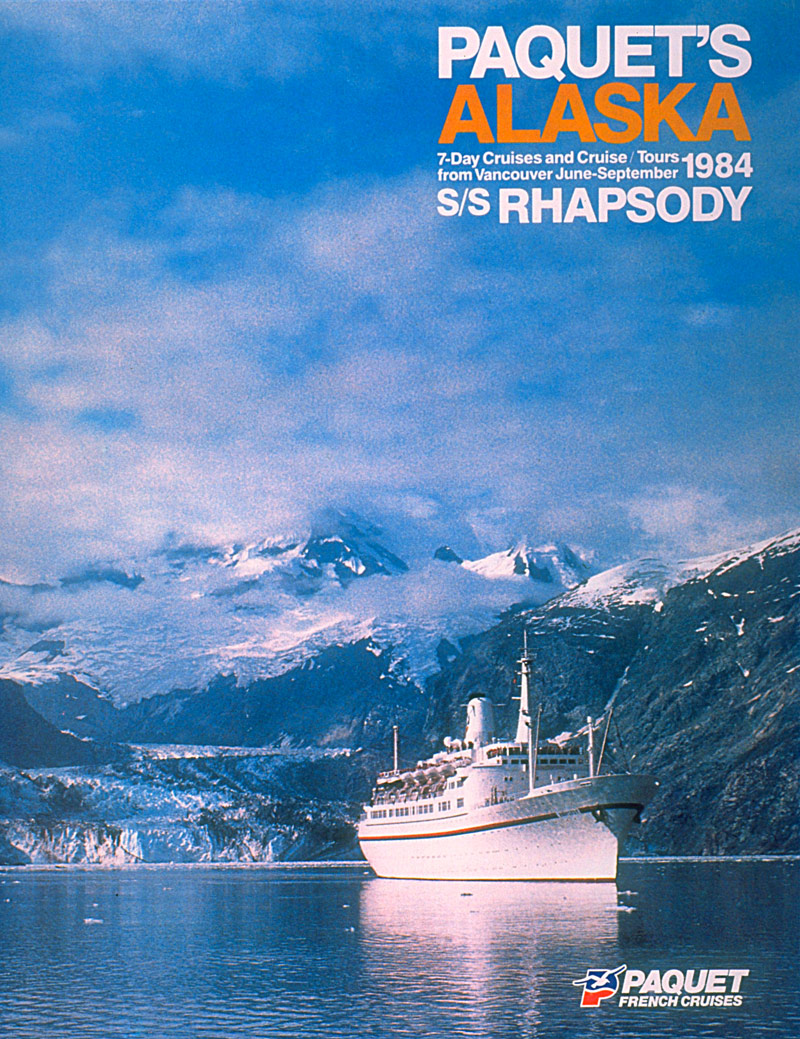 |
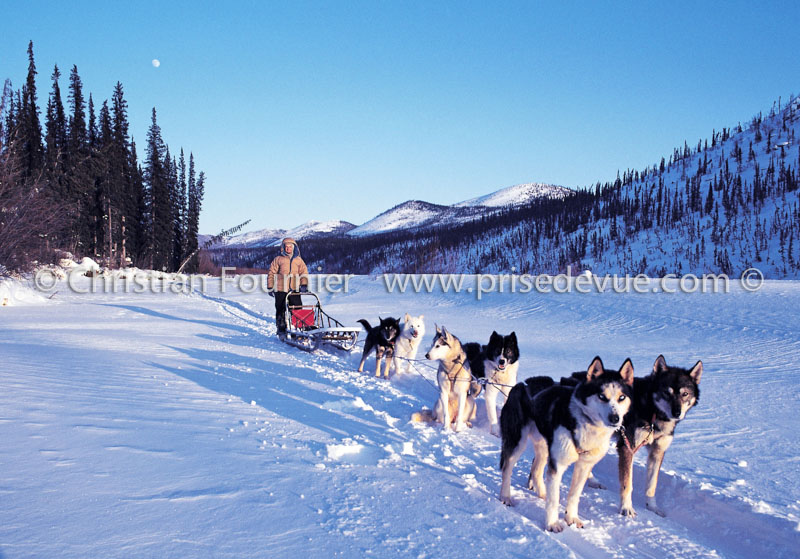
|
Arctic, 1984 : leaving from Bettles, Alaska, population 12, close to the North Pole, with the intrepid Barry Moss who now lives in Seffner, Florida.
It was Barry who initiated me, earlier, to ice-climbing on the glaciers. We left together from Florida and we took planes which became smaller and smaller, and it became colder and colder.
Coming straight from Florida, it took me a week to start feeling well at - 40° (interestingly, this is where the Celsius and Fahrenheit scales meet up, -40° C = - 40° F)
At 40 degrees Celsius below zero, photography becomes very difficult : the films become brittle, the batteries stop working, the cold metal rips off your eyebrows, the frost created by your breath obstructs the viewfinder, you have 20 seconds max without gloves to change the film roll by pulling off your external glove (there is another, thinner polyprolene glove underneath).
|
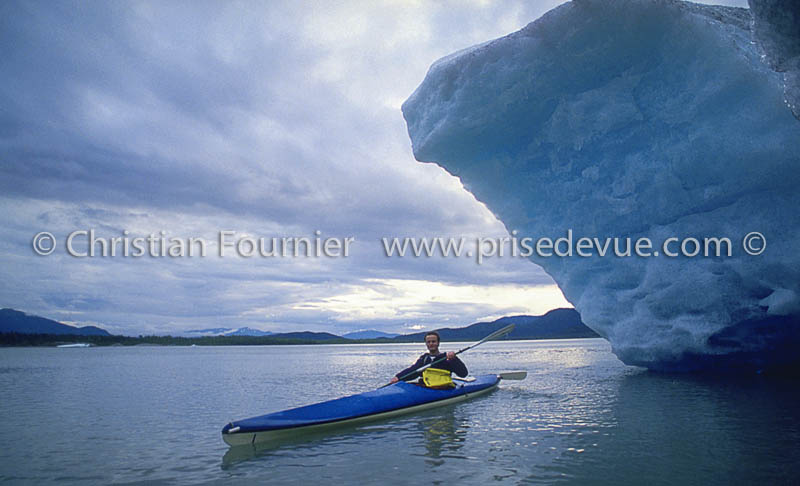
|
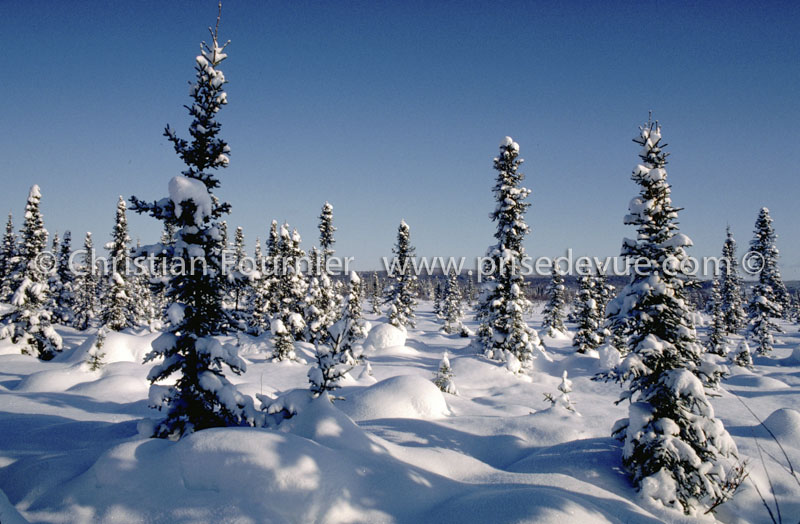

With Nicole by the Mendenhall Glacier
|
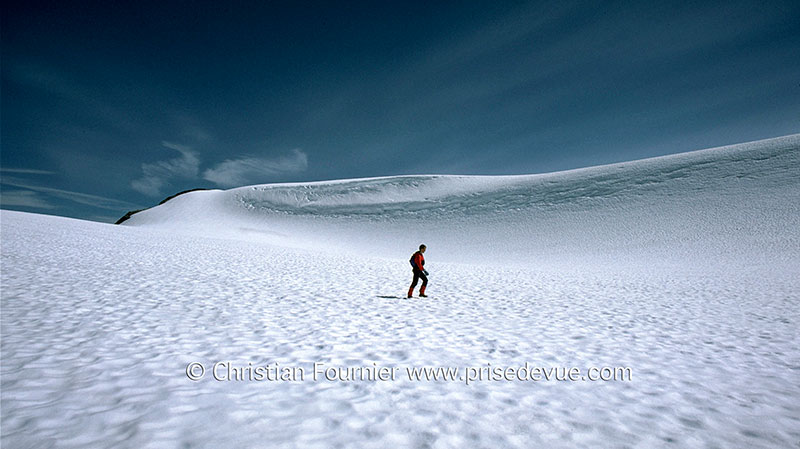
|
Shannon Templeton in the crevasse. I say so because it is difficult to spot her.

|
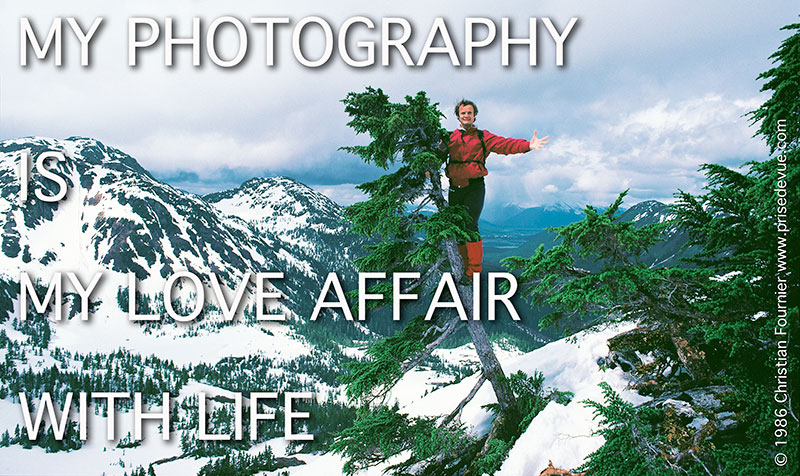
|
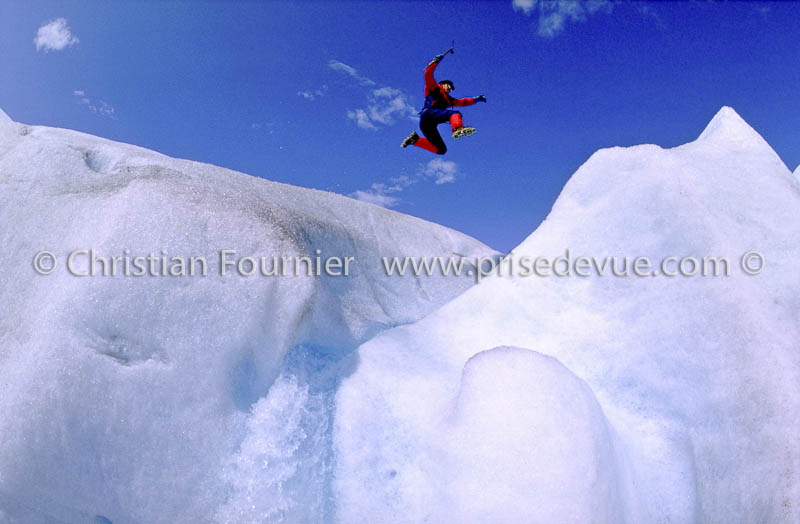
Allen Jolley leaping again
|

|
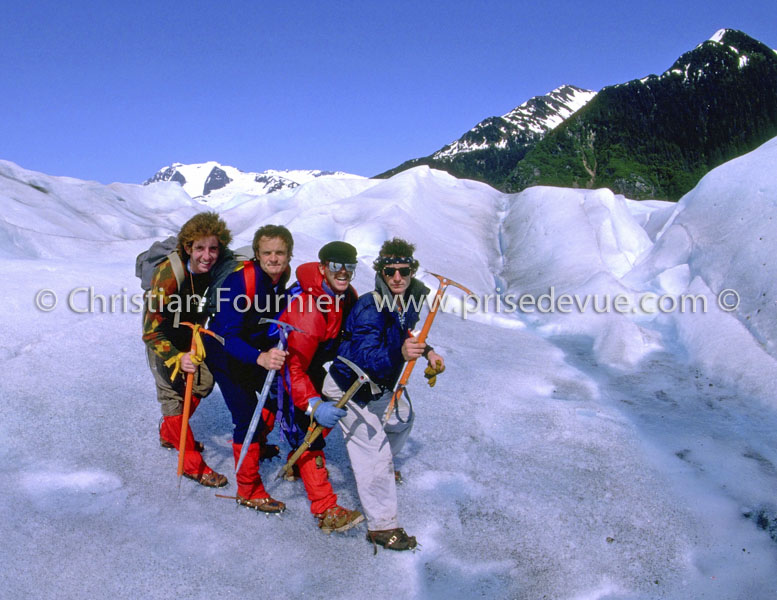
Choreography by Barry S Moss |

|
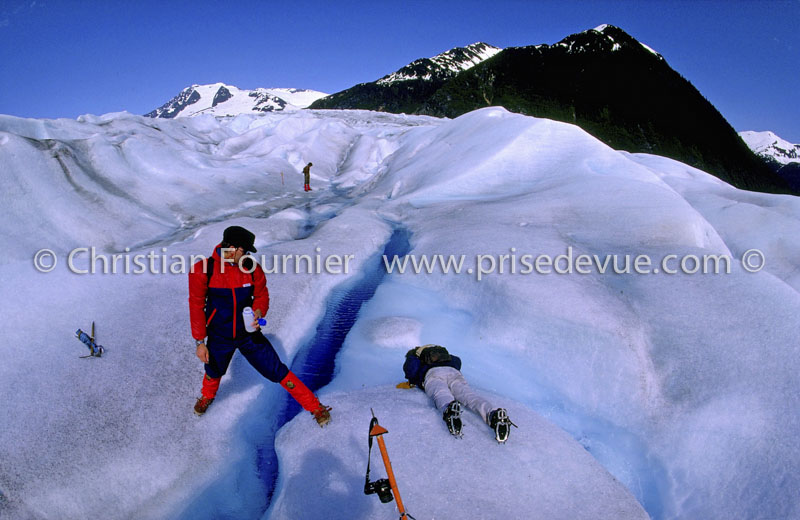
|

|
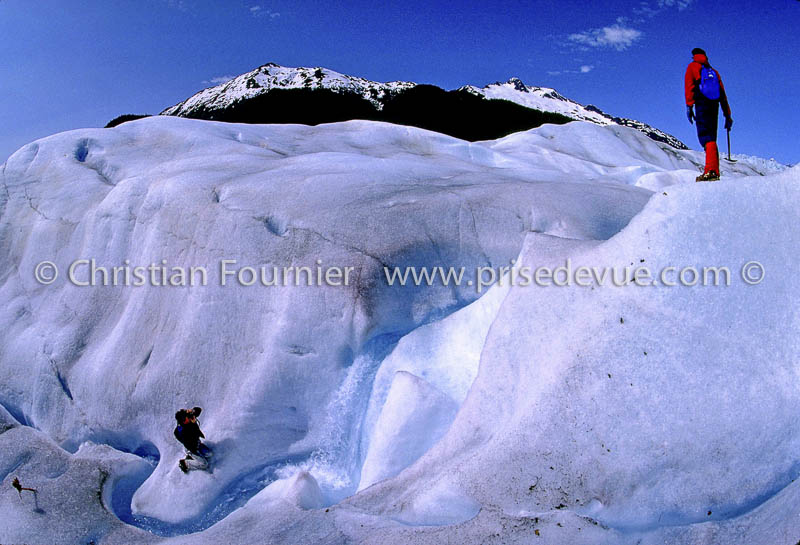
|
 |
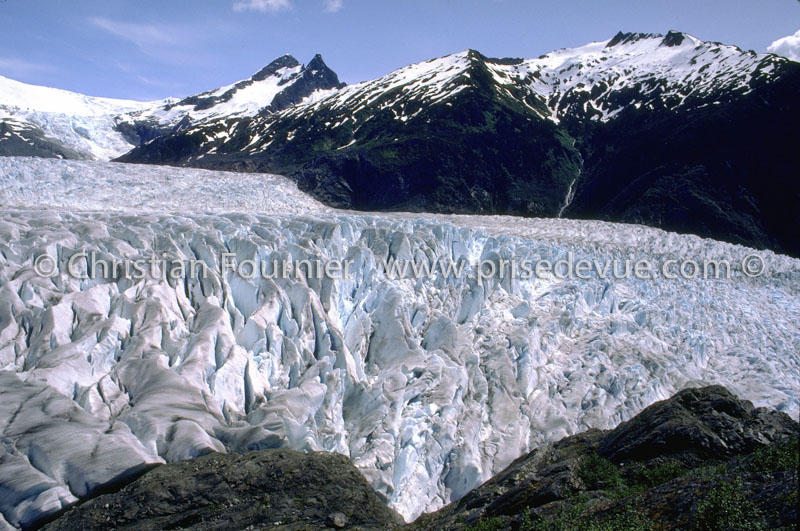
|
|
|
Barry once again.
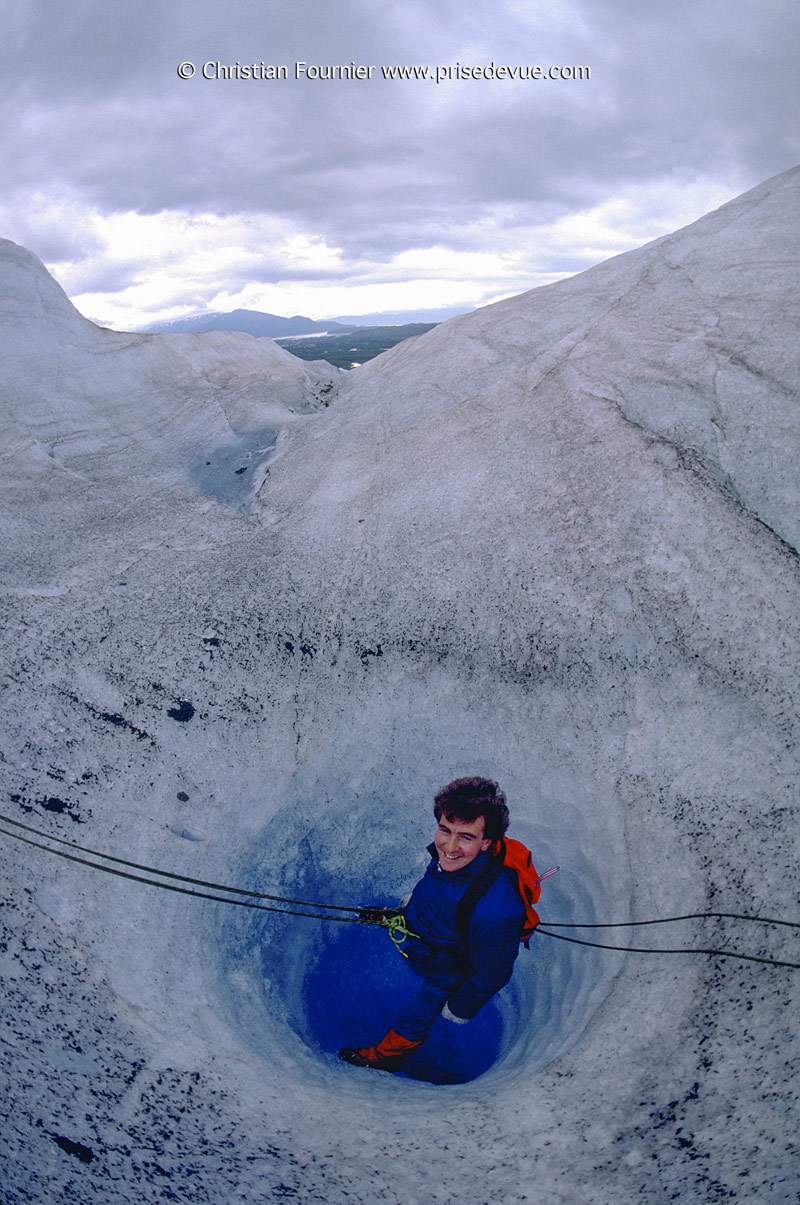
|
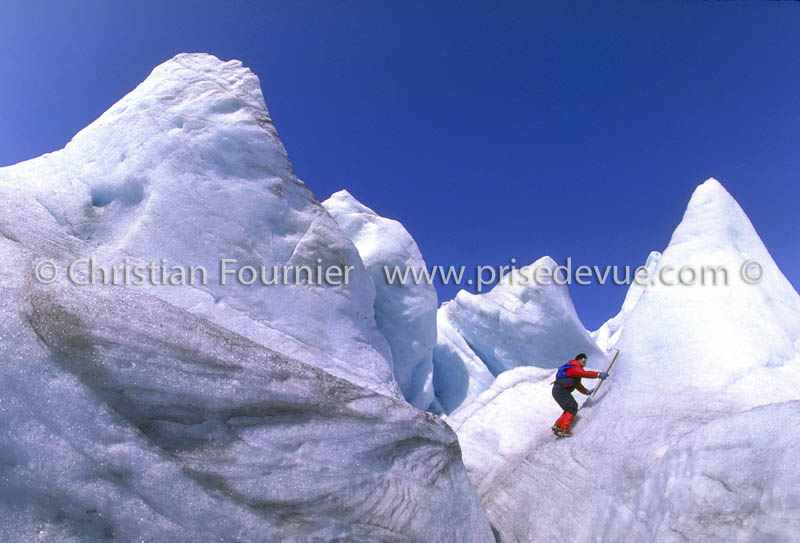
|
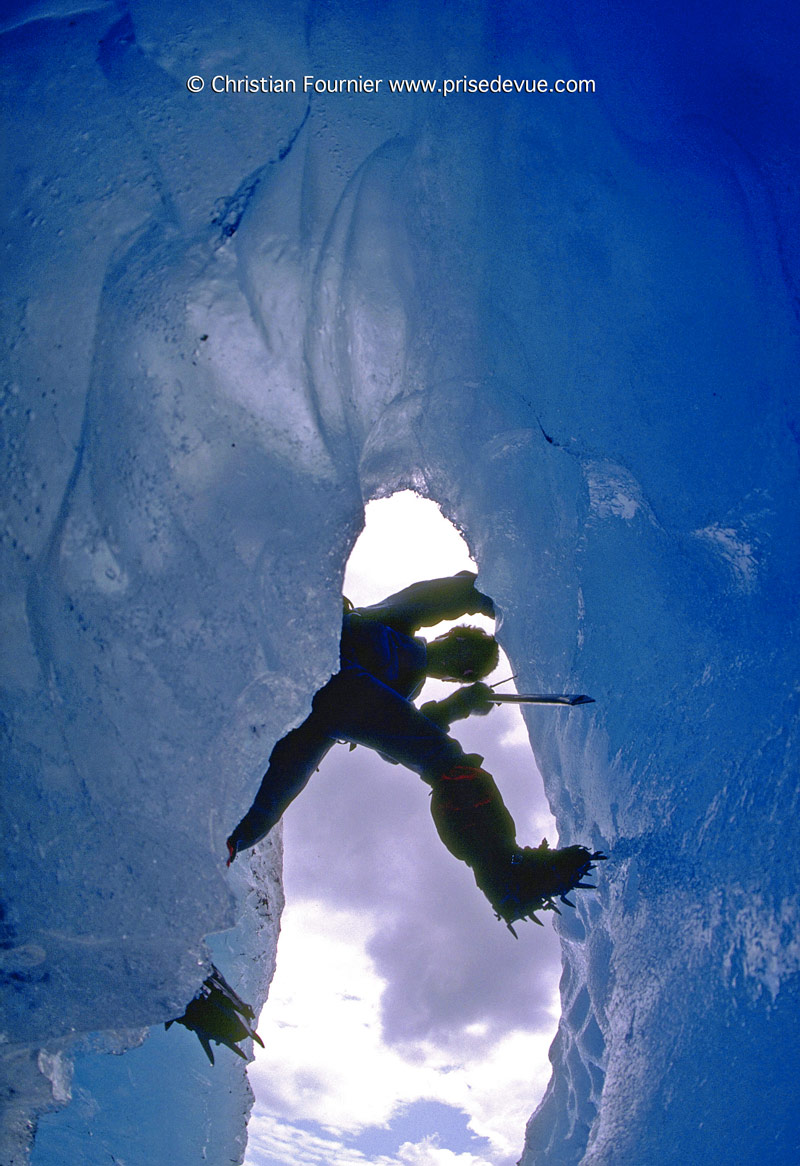 |
|
Encounter with a Bear
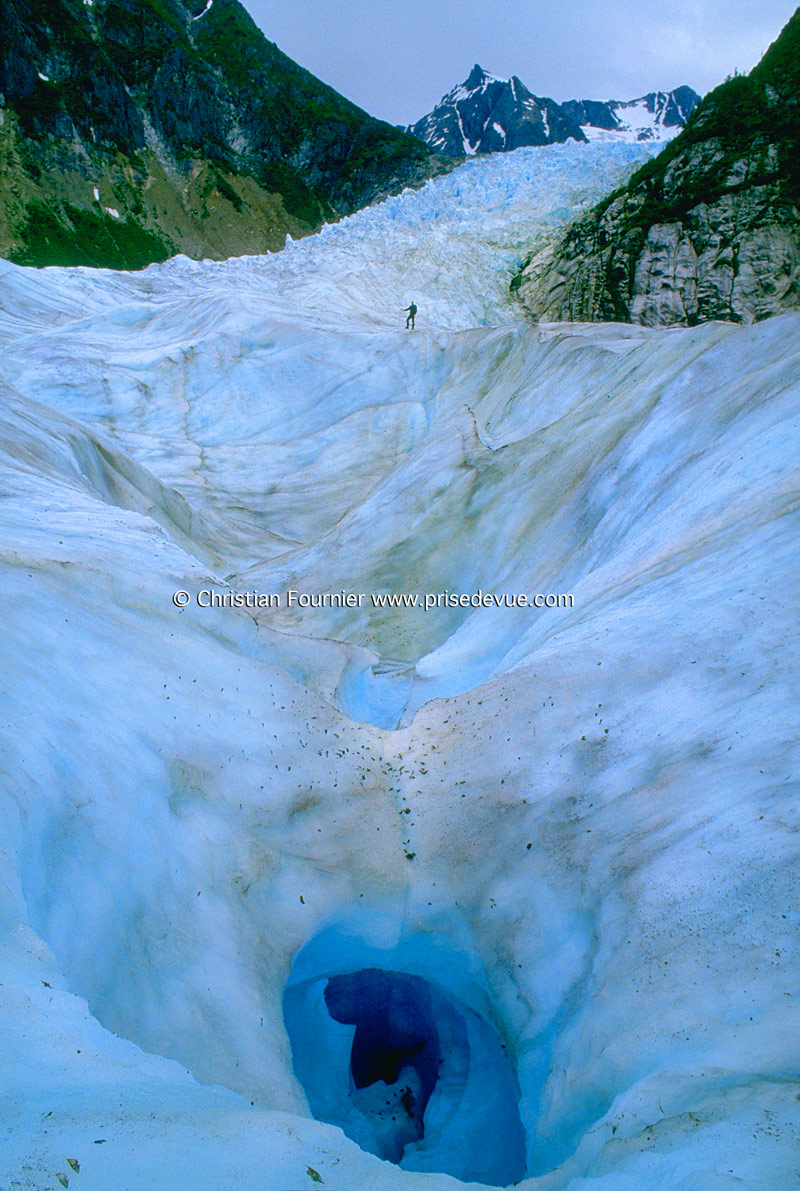
|
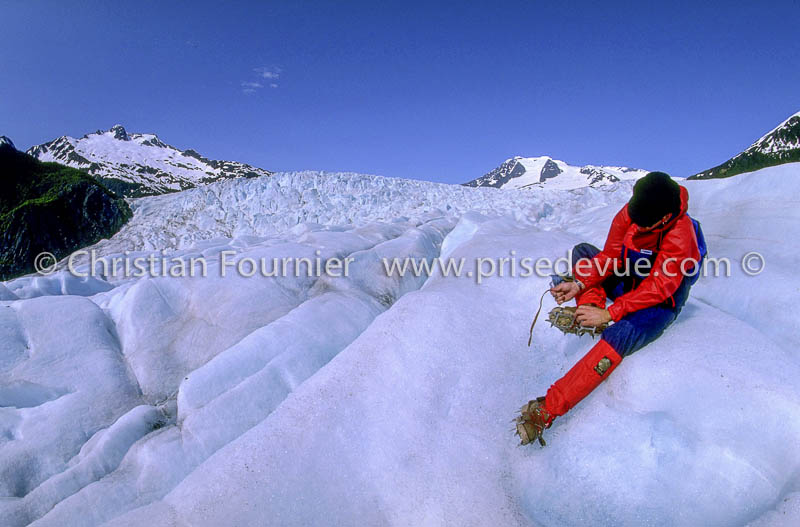
Broken ice crampon.
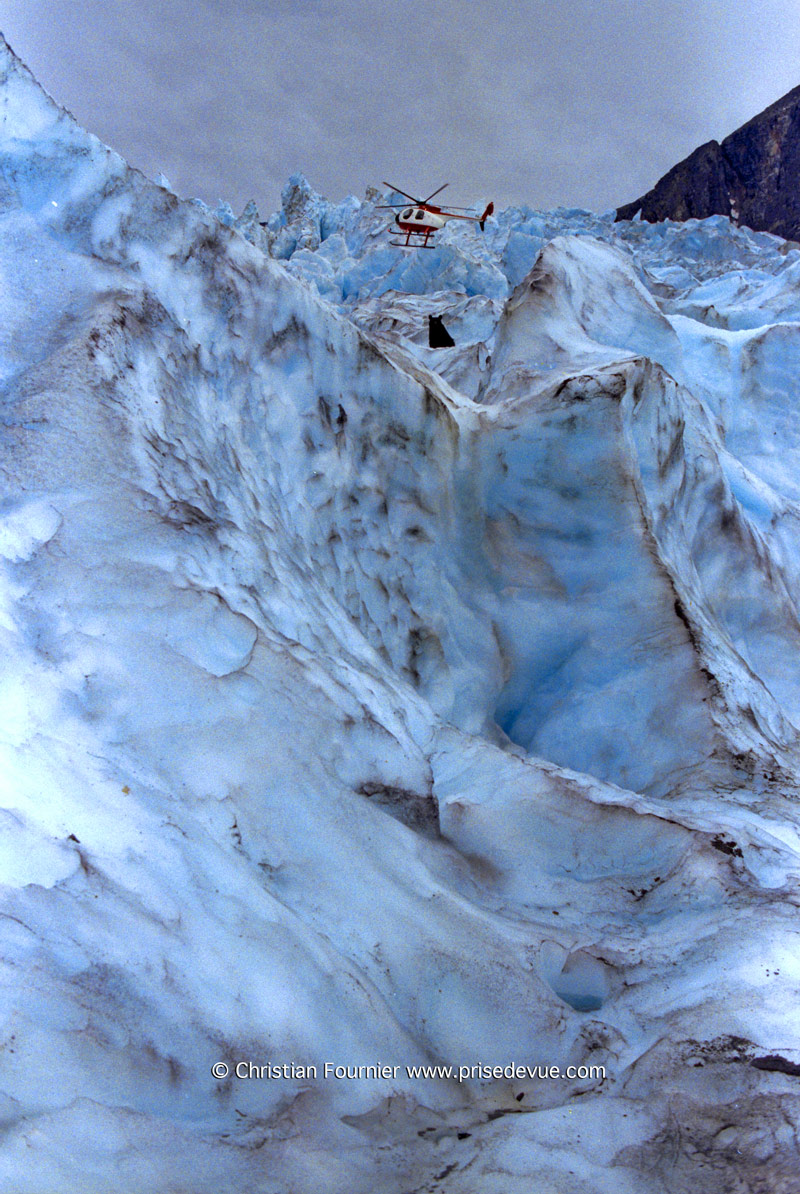
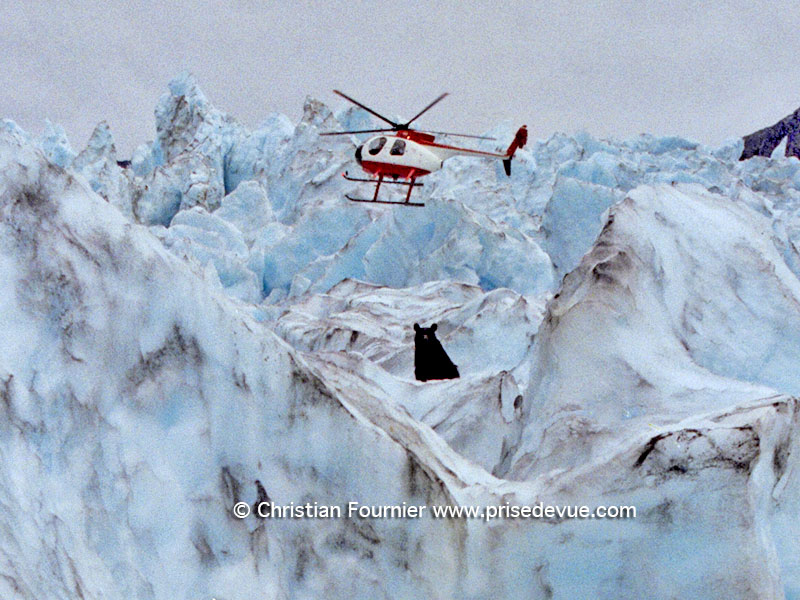
|
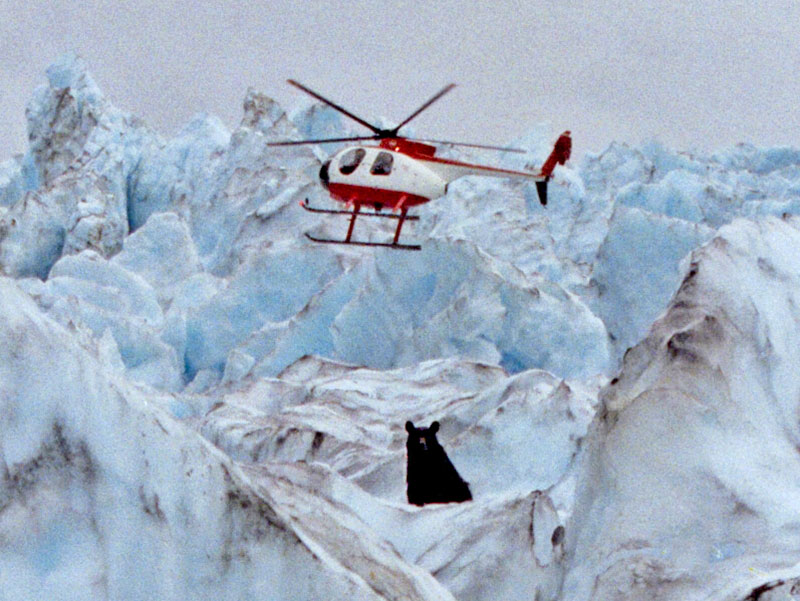
|
An encounter with a bear, circa 1986.
I was climbing the Skagway glacier in Alaska with Doug Plews. Not a soul within 50 km in any direction. Nought but ice in any direction. Sublime.
One of the studs on Doug’s shoe broke. I decided to continue on along until the next cliff, which looked fabulous, before meeting back up with Doug on the way down.
I made it to the summit, rather out of breath, and took out my Nikon with its new extremely wide-angled 14mm lens. I look through the viewfinder and see a bear running straight at me.
I still remember the thought which raced through my mind at that moment: if I can see that bear so well in my 14mm, he must be practically on top of me.
I threw my camera aside and frantically rummaged through my backpack for my emergency flares, which can also be used to scare off bears. I was just about to fire one when suddenly from out of nowhere a helicopter zooms around the cliff and flies over me, frightening the bear.
That helicopter was showing the glacier to a couple of American tourists. Luckily for me, the pilot had seen my distress and had decided to come to my rescue. He then landed the helicopter a little further on, on a flat section. I went up to meet him and to thank him, and was able to get the contact information for the helicopter company as well as that of the elderly gentleman who had taken a video of the harrowing scene.
I then returned to help Doug back down the glacier. Later I made a huge colour blow-up of the photo of the bear looking at me. I offered the print to the helicopter company, who hung it up in the client reception room. I also eventually received the VHS from the old gentleman who admitted that he had been so enthralled by the sight of the two bears that he actually hadn’t seen me when he was filming.
Well, for my part, I had only seen one bear from my cliff.
The image quality is somewhat poor and the audio is pretty much entirely that of the helicopter’s engine, but you can still see the two bears, quite a bit more agile than yours truly, and the enthralling beauty and immensity of the glacier. My thanks to both the pilot and the gentleman with the camera.
|
The video in question:
|
“Black bears
rarely attack. But here's the thing. Sometimes they do. All
bears are agile, cunning and immensely strong, and they are
always hungry. If they want to kill you and eat you, they can,
and pretty much whenever they want. That doesn't happen often,
but - and here is the absolutely salient point - once would be
enough.” ― Bill Bryson, A Walk in the Woods: Rediscovering
America on the Appalachian Trail
"One of the great pleasures of my cruise ship days was coming
onboard and getting a peak at your book of new 8X10 prints. I
also can't count the number of times I've recanted the tale of
you in Skagway and the bears, the helicopter and the second
helicopter that taped the whole thing. I'm assuming you still
have the tape :-) BTW, A few years after the fact, I was back
in Skagway and dropped in at the helicopter company's office
and got such a kick out of seeing the picture of the bear with
the helicopter in the background still up on the wall. The guys
working there at the time had no idea of the history, so I had
the pleasure of recanting the tale for them". Ben Decker
|
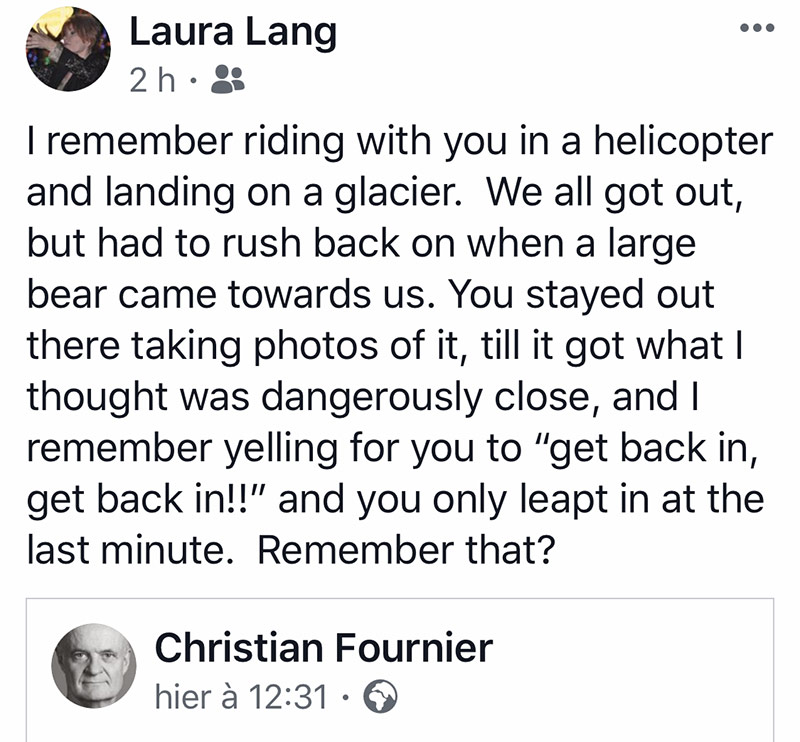
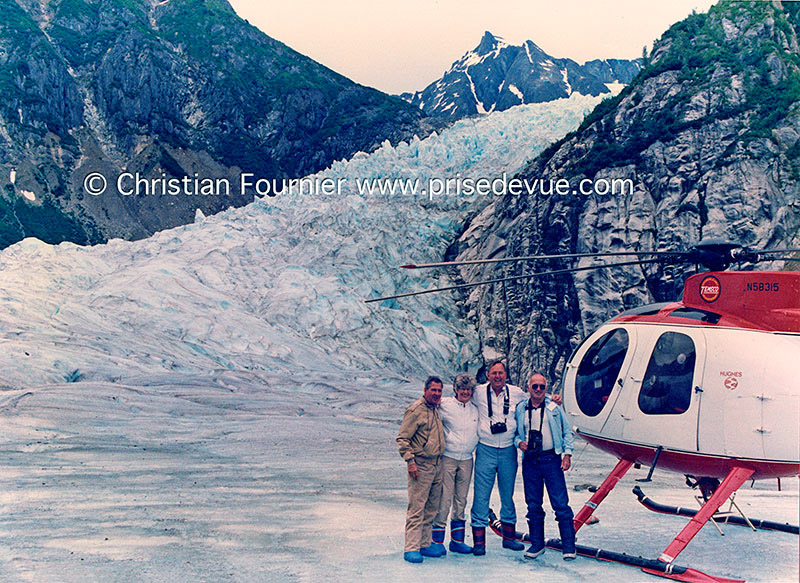
|
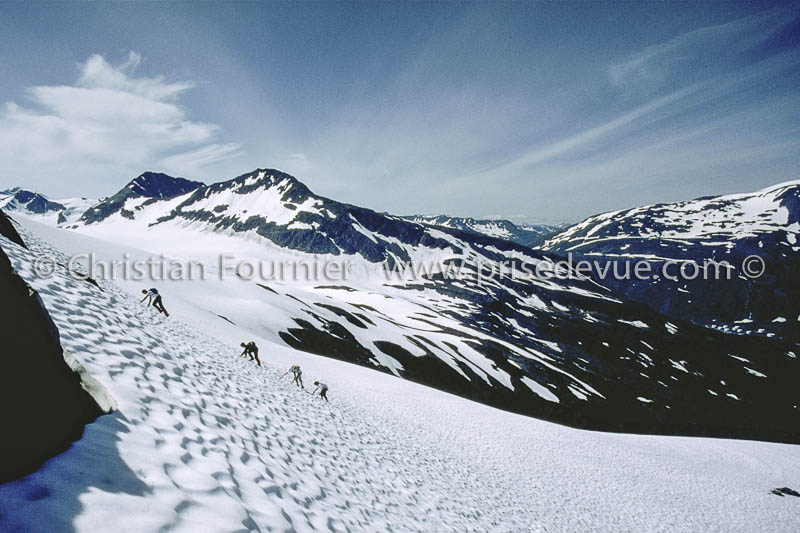
|

|
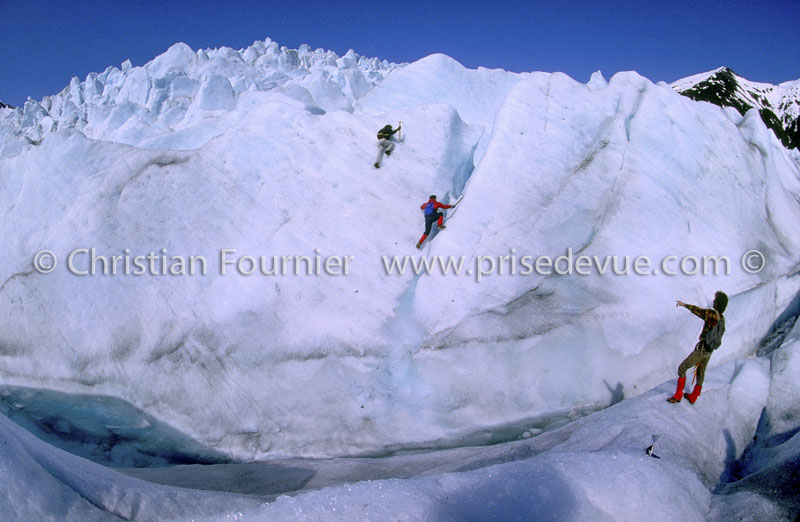
|
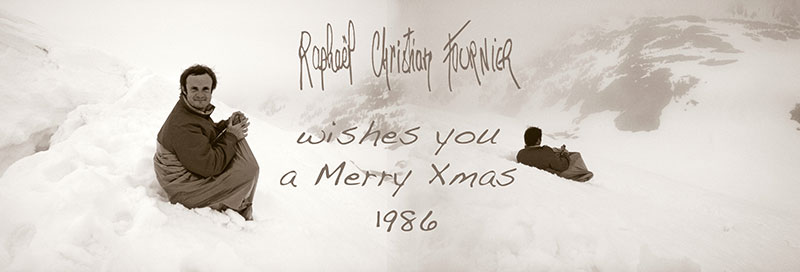
This highbrow exercise is known as 'polybagging'. The idea is to climb to the top of a nice snowy hill and slide down in a garbage bag. Just remember to avoid falling into a crevasse. Better than Space Mountain at Disneyland.
|

The glacier moose really exists.
|

Votre humble photographe et narrateur
Christian Fournier
|
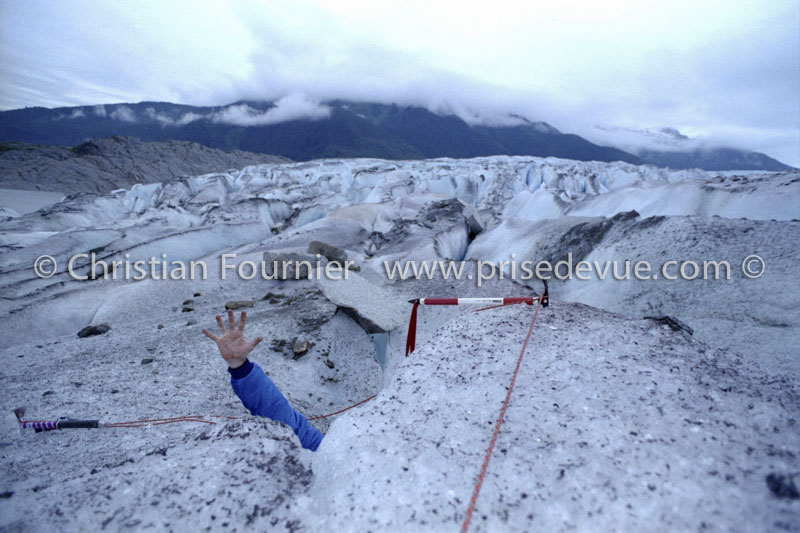
Votre humble photographe et narrateur
Christian Fournier
|
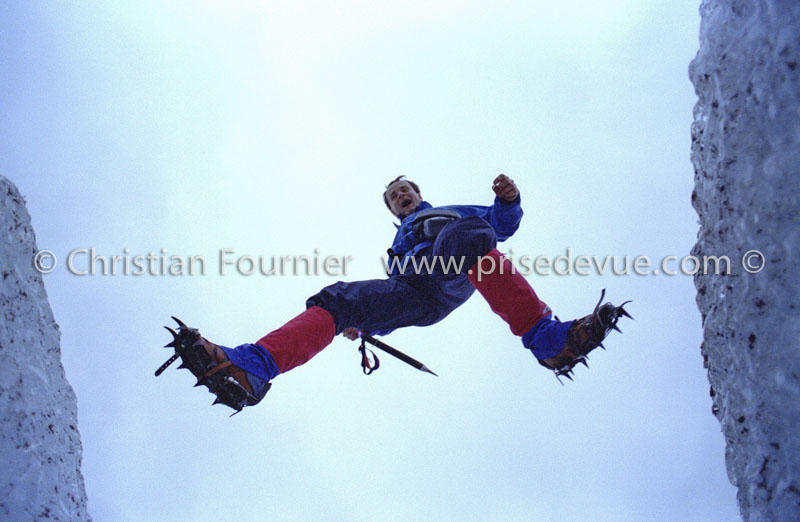
Votre humble photographe et narrateur
Christian Fournier
|
 |
Votre humble photographe et narrateur
Christian Fournier
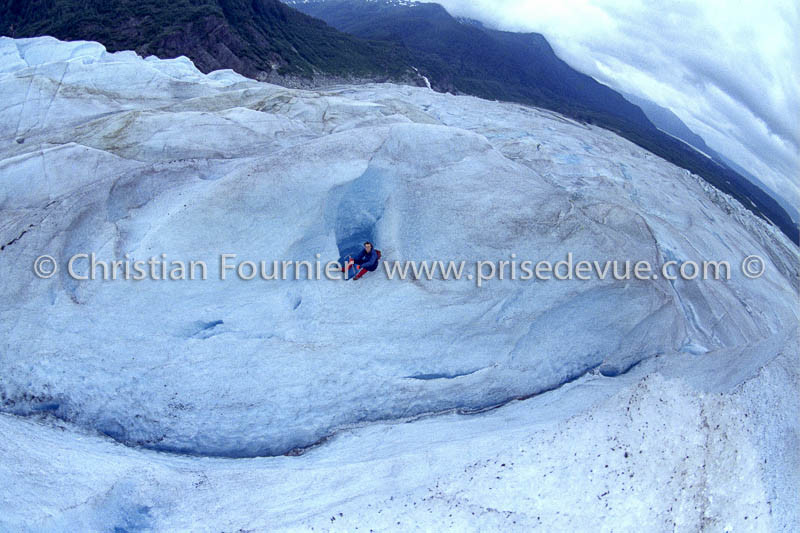
|

|

|
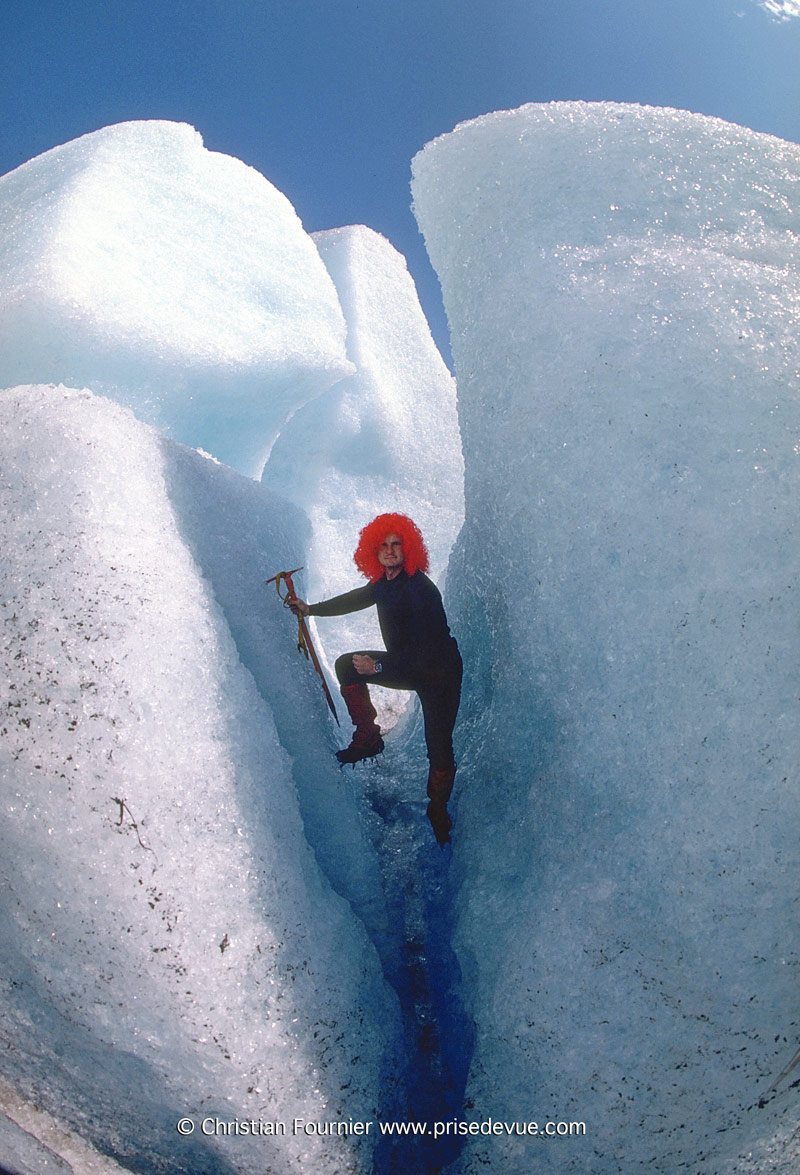
Red is the colour that is easiest to see in the bottom of crevasses.
|
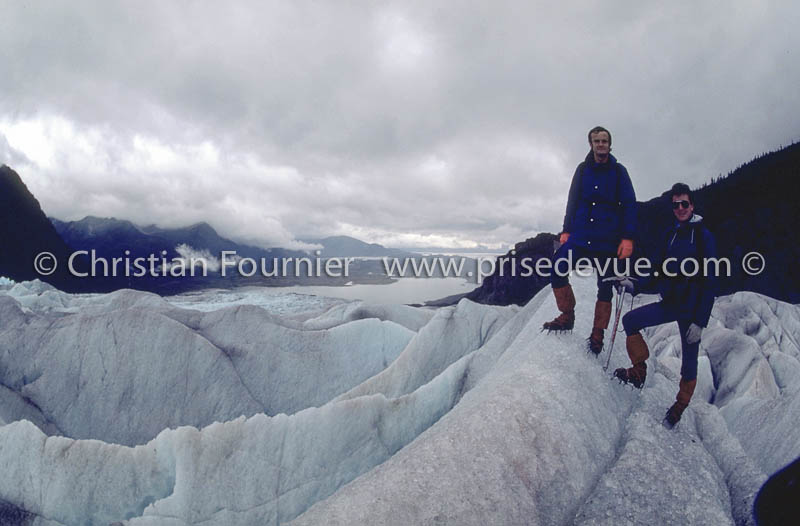
|
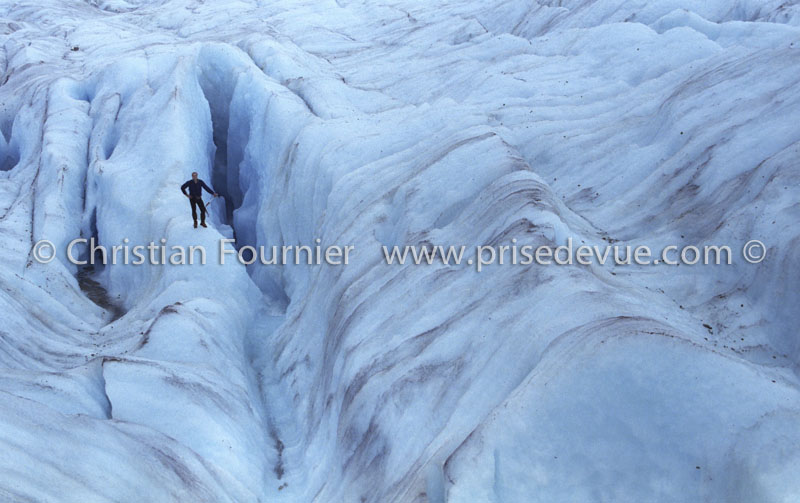
Doug Plews was there, too. |
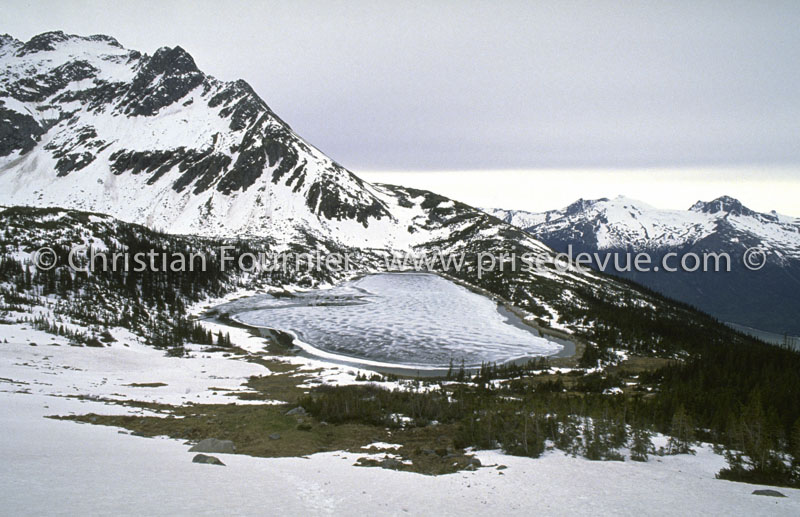
|
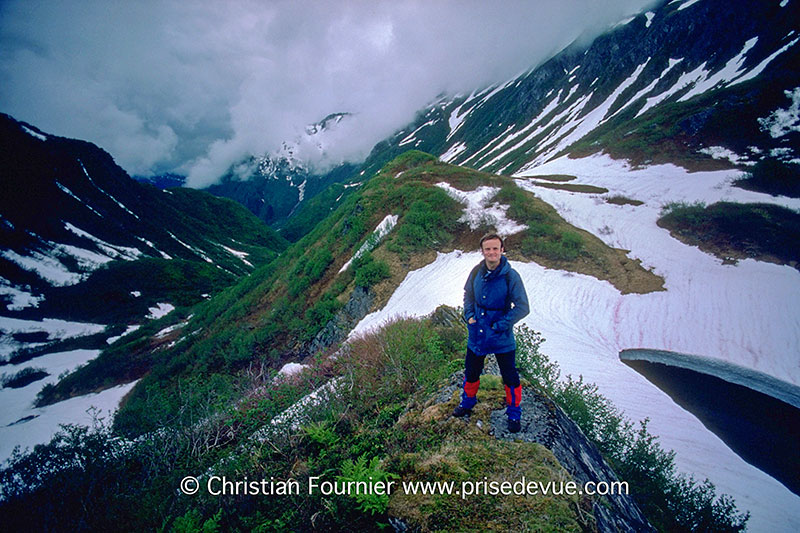
|

|
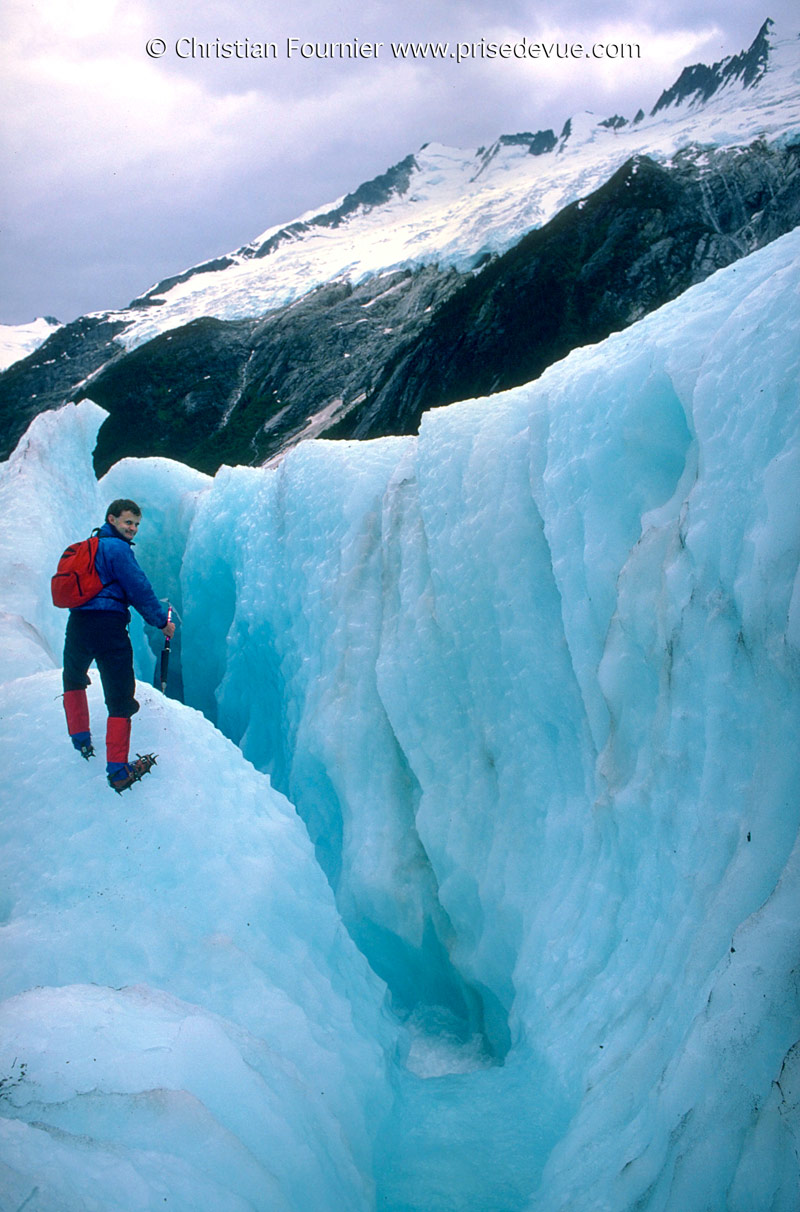 |
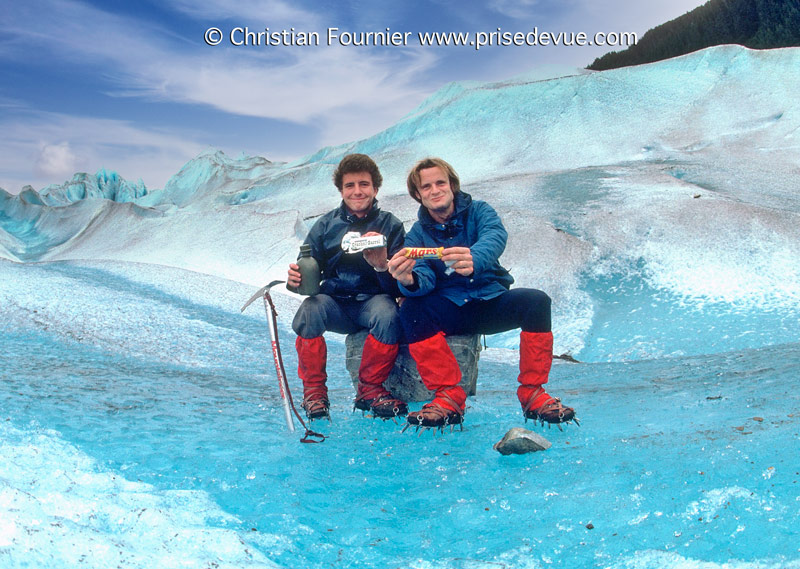
Barry S. Moss and myself on Mendenhall.
|
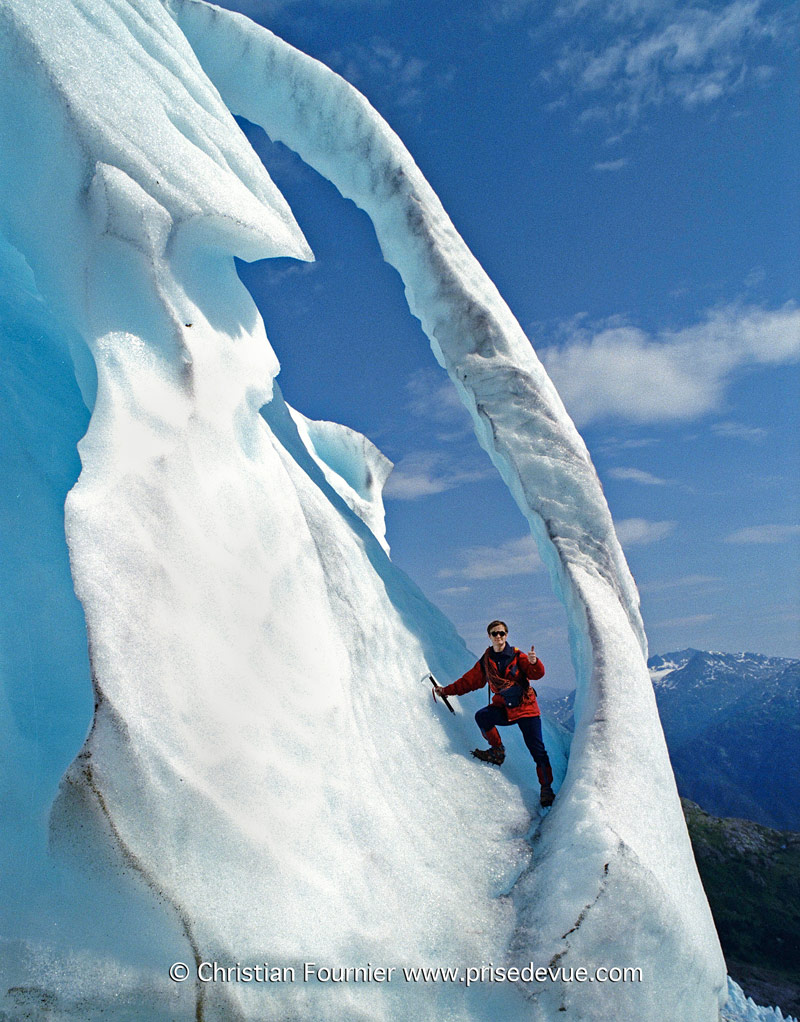
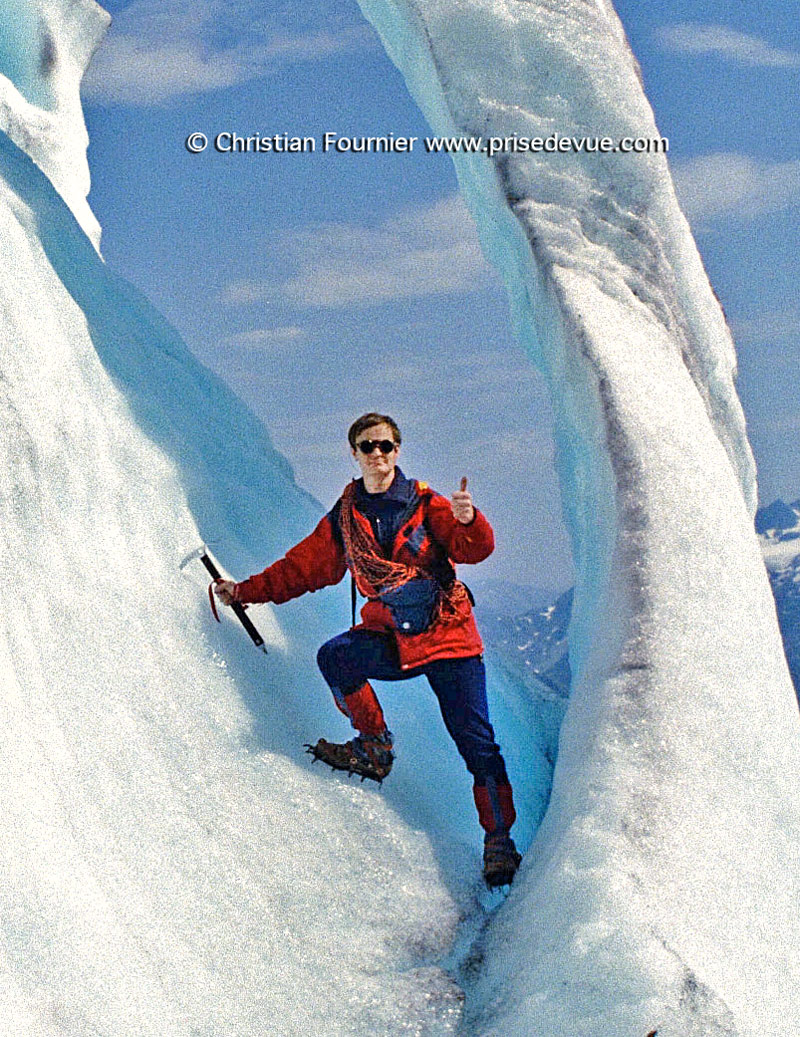
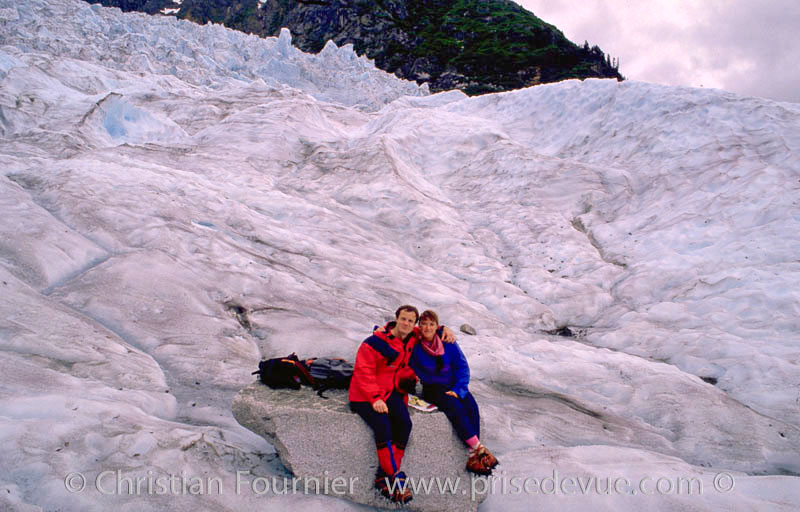
With Dede Tabor
|
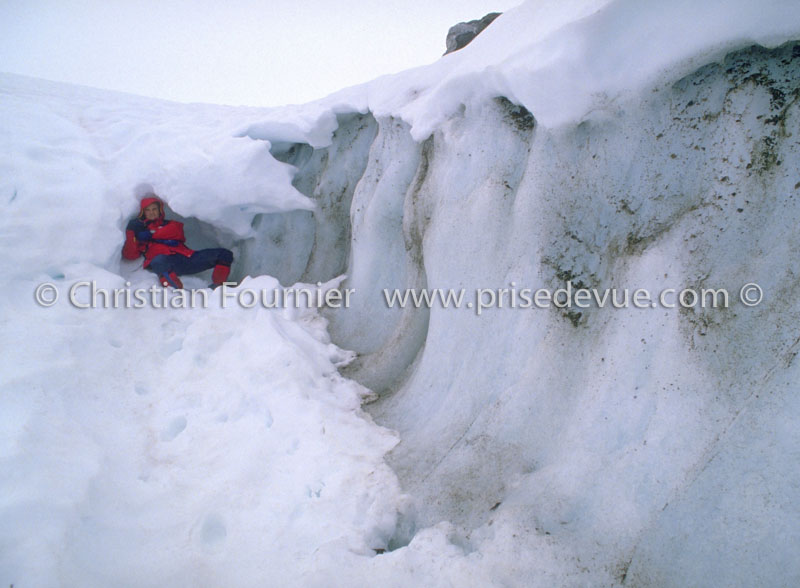
|
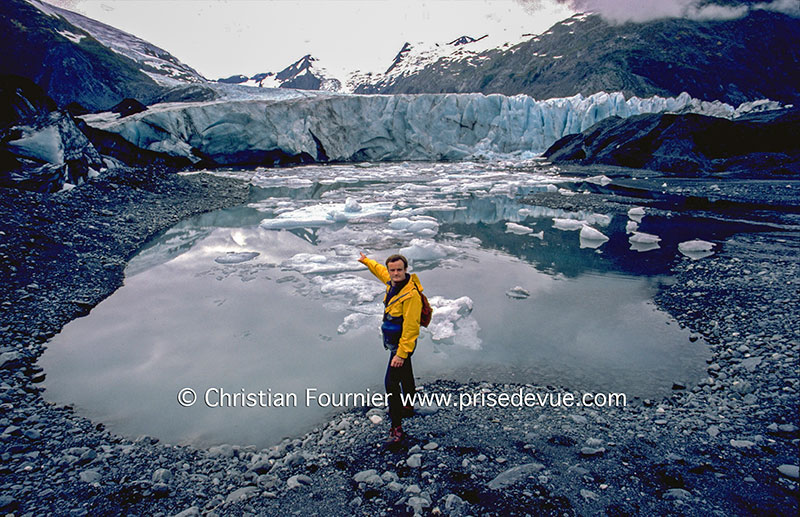
|
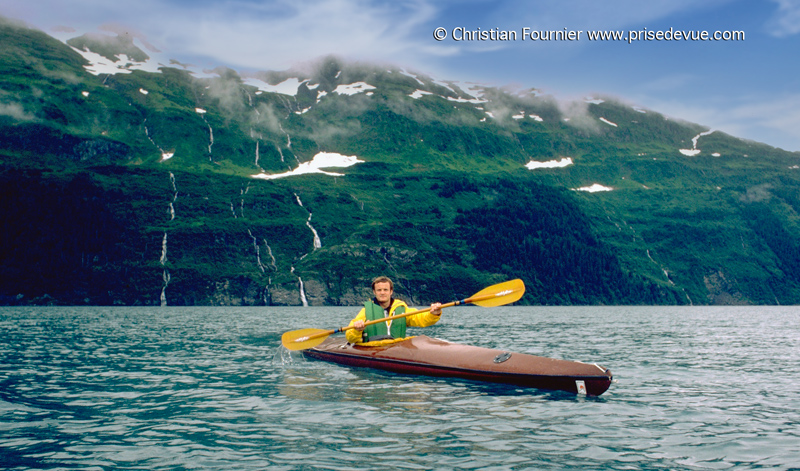 Whittier, Alaska Whittier, Alaska
Barry Moss handing over the camera very very carefully.
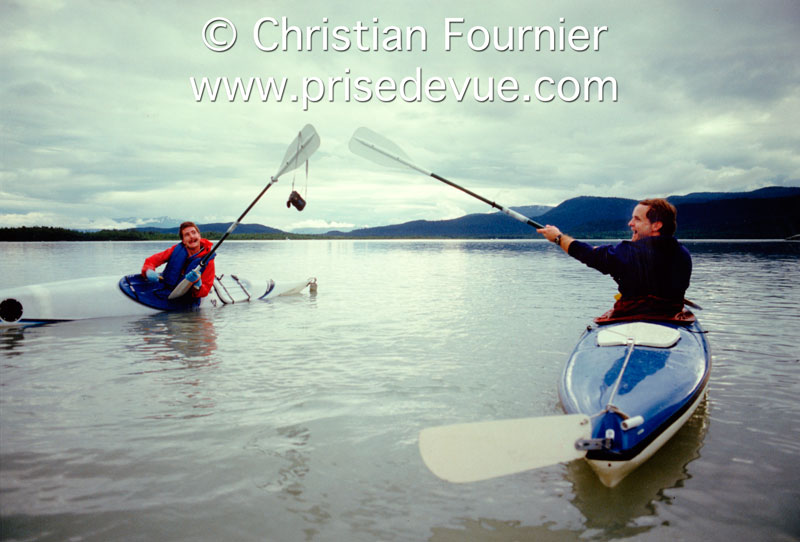
Here, a dangerous exchange. It failed and Barry fell into the
icy water. But, it's OK the camera was waterproof, a Nikon
AWAF)
|
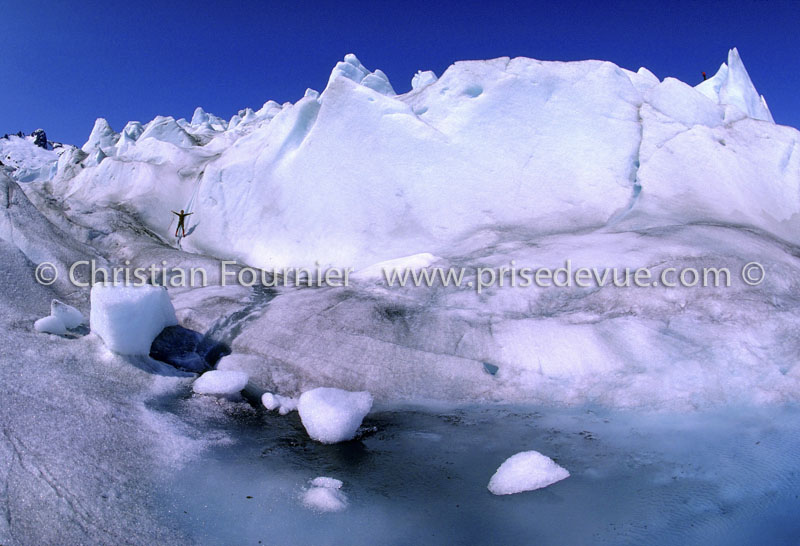
|
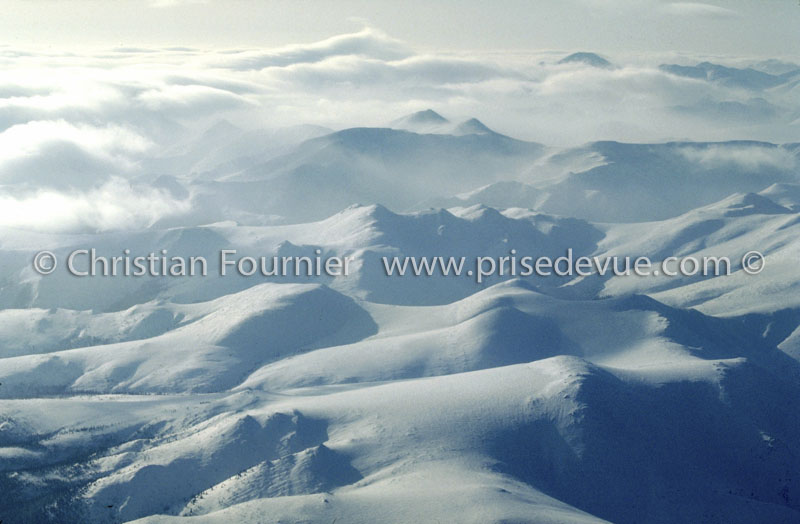
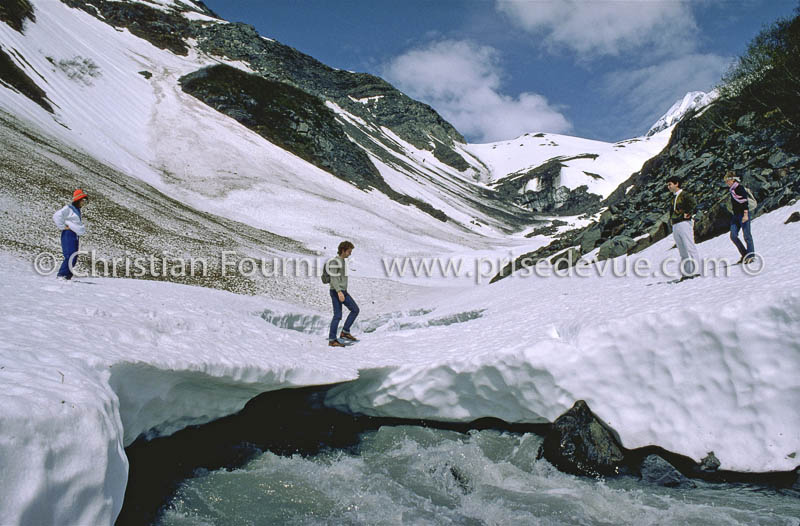
|
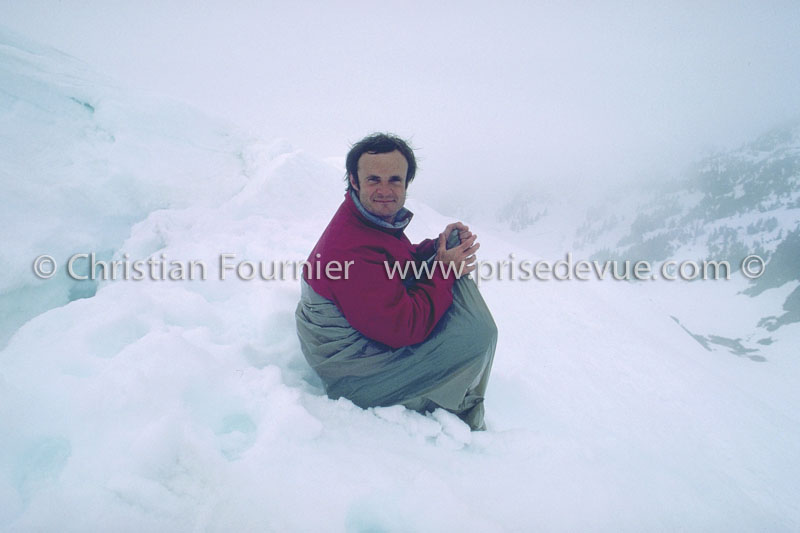
This super-intelligent practice is known as 'polybagging'. The
idea is to climb to the top of a nice snowy slope and slide
back down on a garbage bag, avoiding any crevaces on the way
down. Better than Disney’s Space Mountain ride!
|
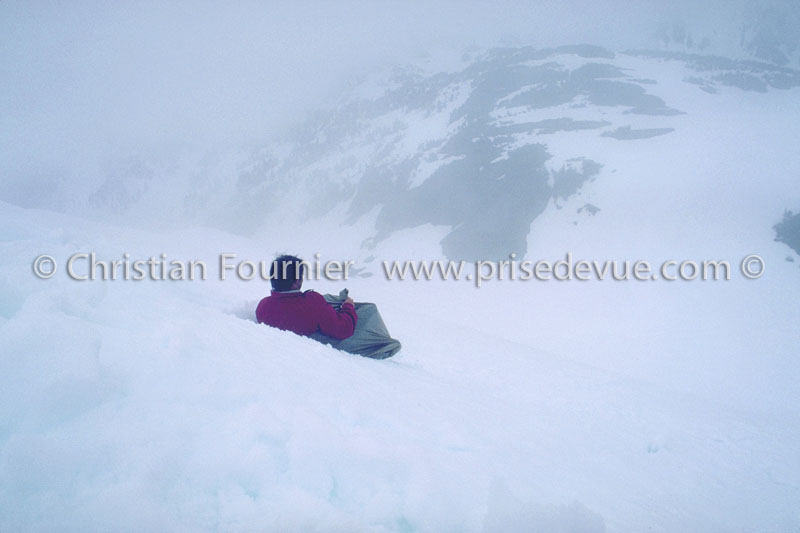
|
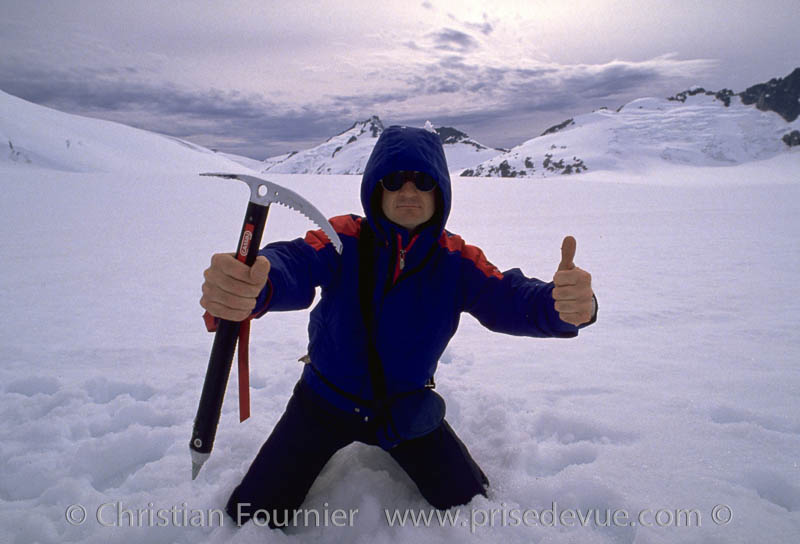

|
Shannon Templeton on the ice in only a swimsuit. I’ve mastered the art of persuasion, as you can
see.
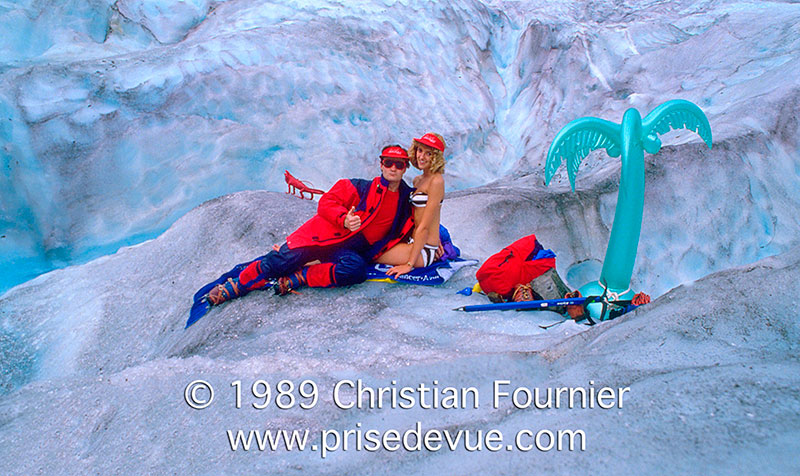
Tribute to Shannon Templeton
I meet Shannon around 1989 on board the cruiseship M/V
Standancer.
I took her glacier climbing on Mendenhall Glacier in Alaska. I
brought along an inflatable palm tree and a red painted stuffed
iguana.
Shannon Templeton; "And thank you for taking me on my
first glacier experience! Those are memories I will never
forget.
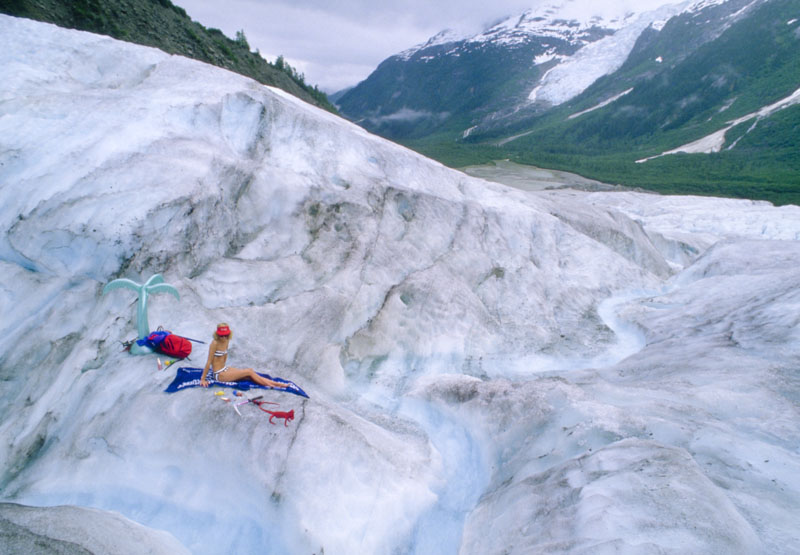
Shannon Templeton: "I was part of a group of about 8 people
around the world who studied non-relativistic eclipsing binary
stars. There were binary stars the did not behave the laws of
relativity, their line of apsides precessed at a rate about
1/7th of what Einstein predicted. The funny thing was all the
systems had the same amount of error which was the truly
fascinating part. We checked to make sure gas clouds and dust
weren't slowing them down, we checked for everything. But we
could never find an explanation for why this was happening. To
this day, no one knows why this is happening. Binary stars are
the perfect laboratory for testing relativity since they are
very large massive objects moving at high speeds. And yet,
these systems did not behave correctly. I did not stay working
in astronomy because I would have had to teach and I tried it
for a while and really did not like it. I actually hated it.
Teaching is not for me. I do miss astronomy every day, though."
I had no idea you have a PhD in math! But I am not surprised, I
always knew you were a very smart person. That is one of the
reasons I enjoyed spending time with you; plus, you were always
so very nice to everyone.
 Shannon Templeton: "That's one of the things I've always
loved about you, Christian, your sense of humor. Who else would
take an inflatable palm tree and a stuffed red iguana out onto
a glacier in Alaska?! In a few hundred years someone will be
wondering how those got there ... Shannon Templeton: "That's one of the things I've always
loved about you, Christian, your sense of humor. Who else would
take an inflatable palm tree and a stuffed red iguana out onto
a glacier in Alaska?! In a few hundred years someone will be
wondering how those got there ...

|
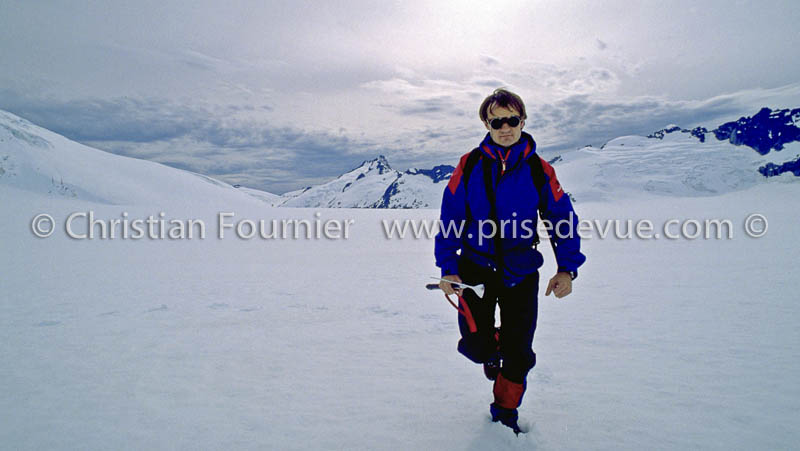
|
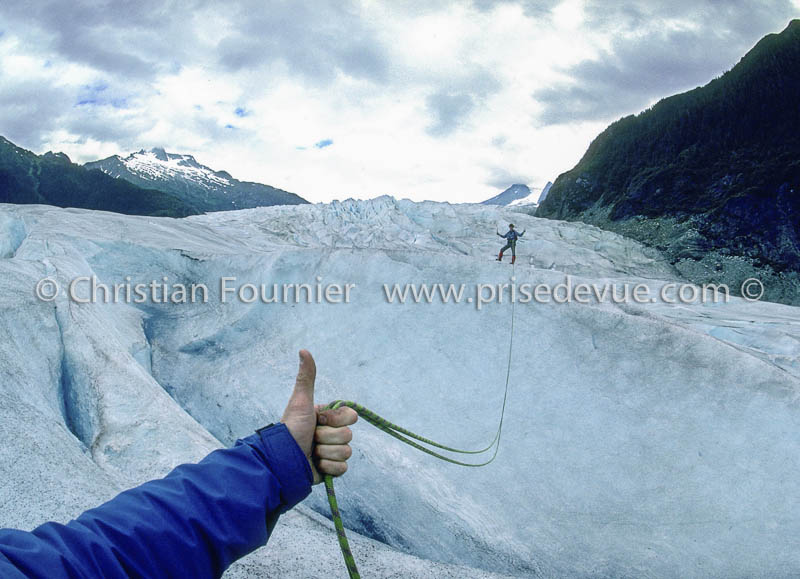
|
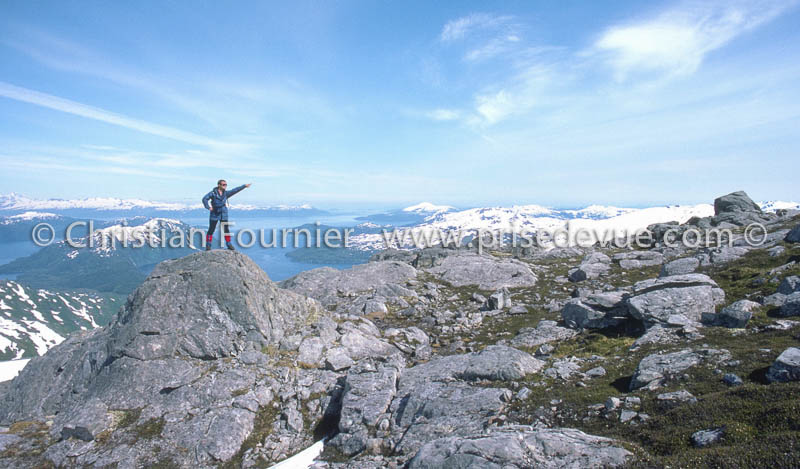
|
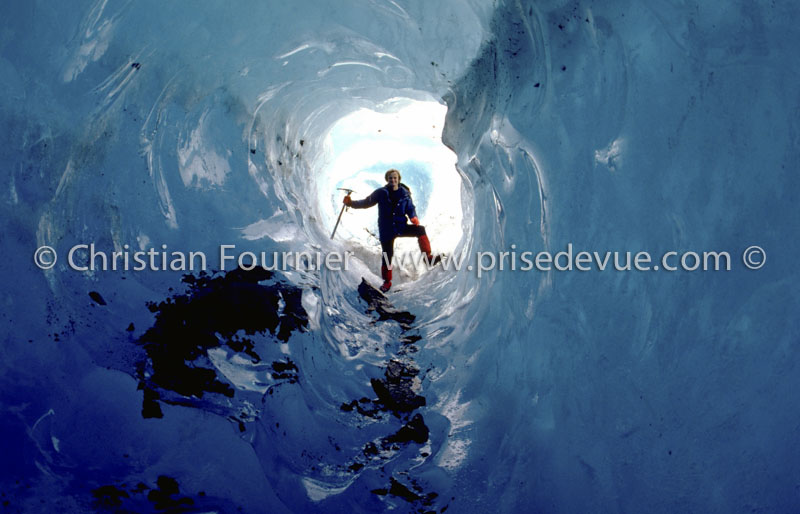
Swimming across a lake
surrounded by ice in Alaska. |
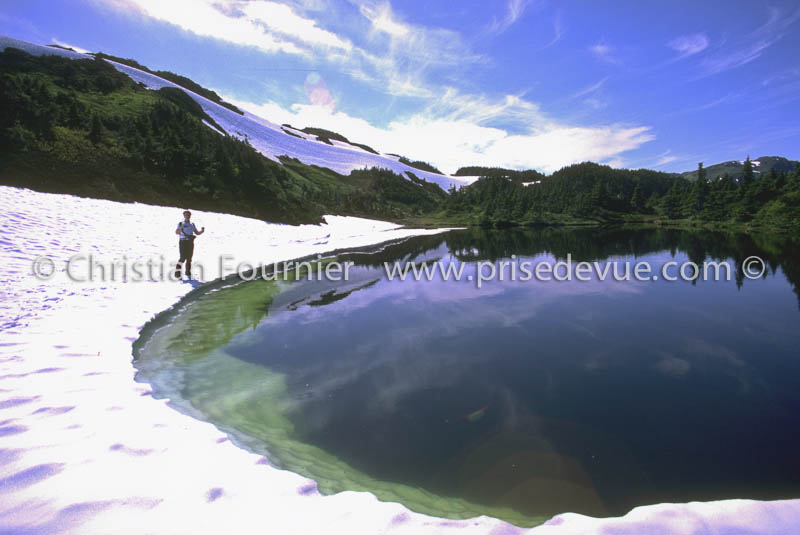
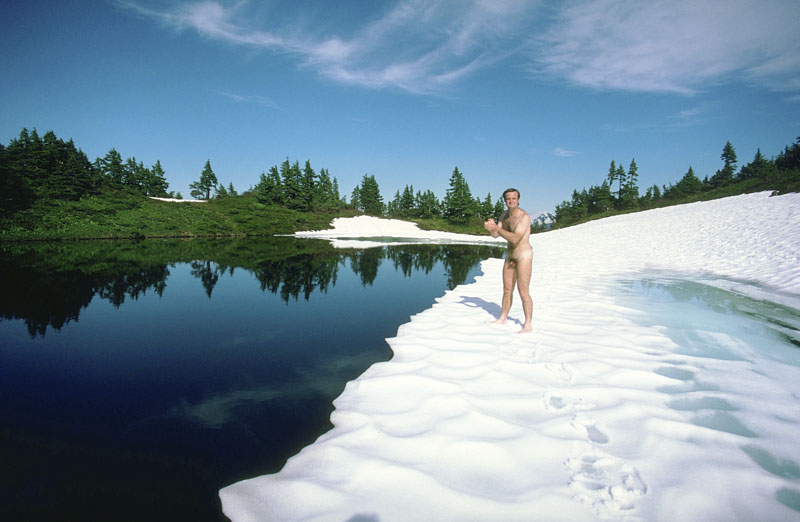
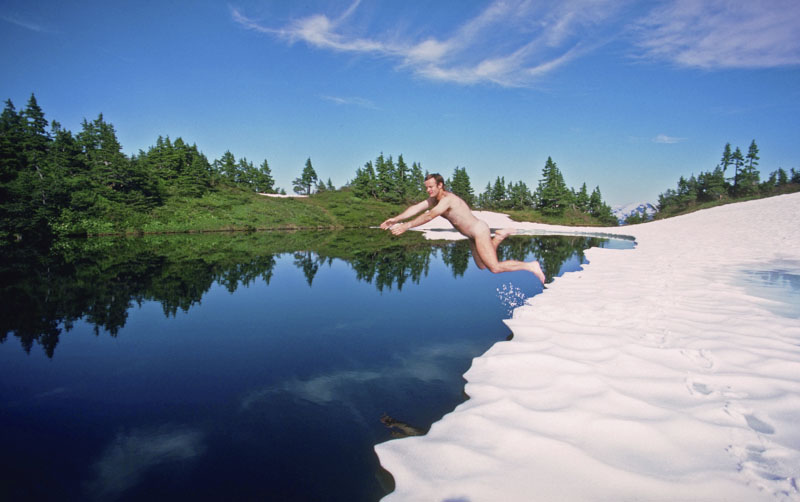
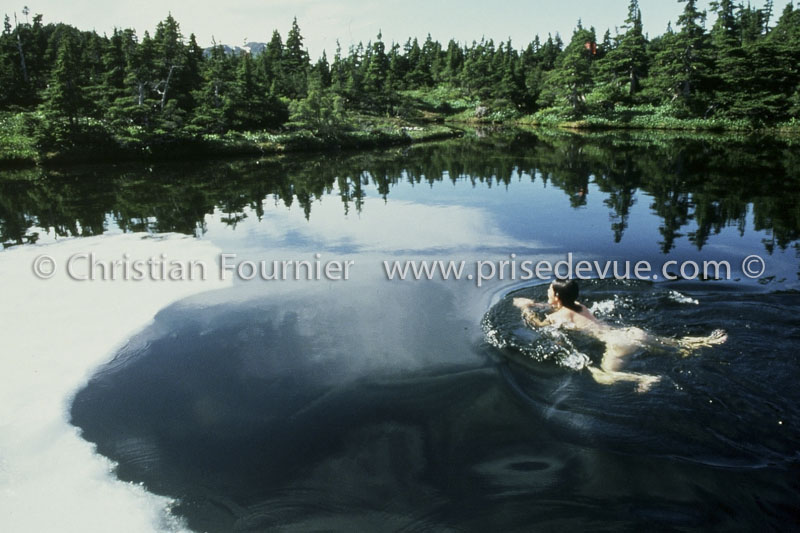
The result of a dare between Laura and me. This magnificent
lake appeared to us along a long hike we made from Juneau.
We put our clothes on the shore to keep them dry, then we
swam across the lake, then we ran (among other things) on
the snow to warm back up. An immaculate and deserted lake,
ice all around, and a beautiful girl. An unforgettable
moment.
Thank you Laurie.
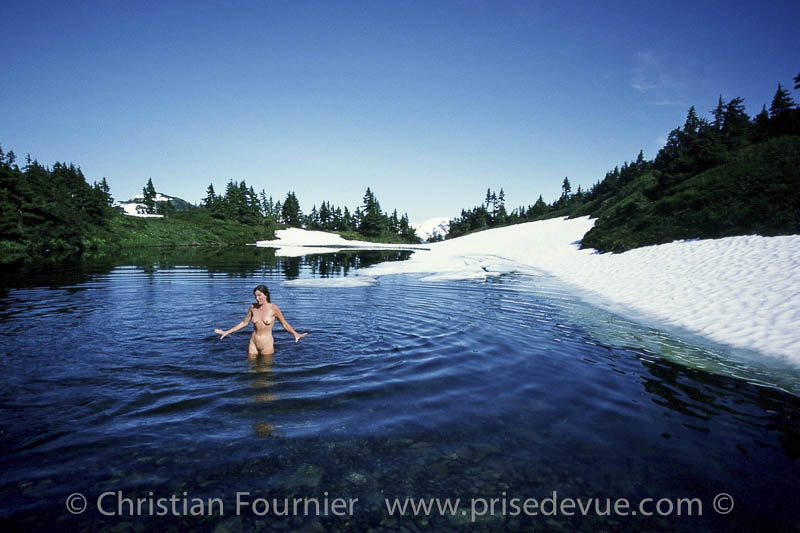
I liked it so much I came back to do it again another day with someone else.
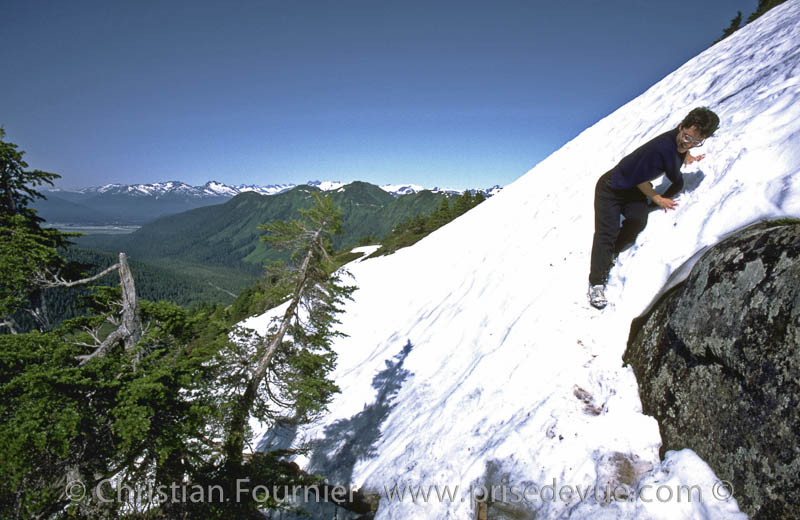
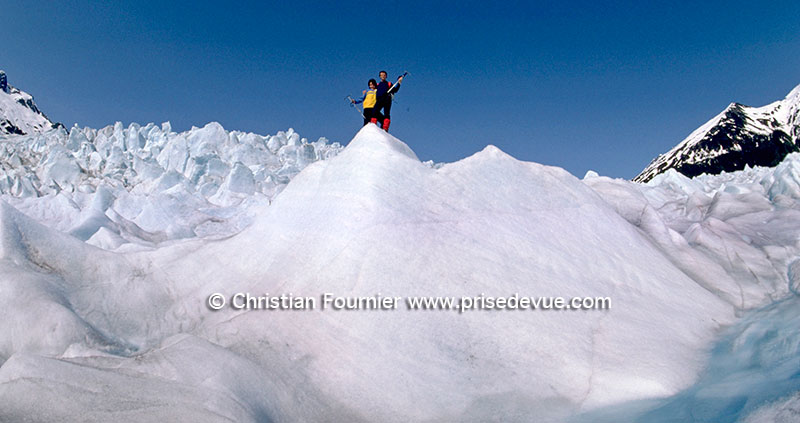
Lorie
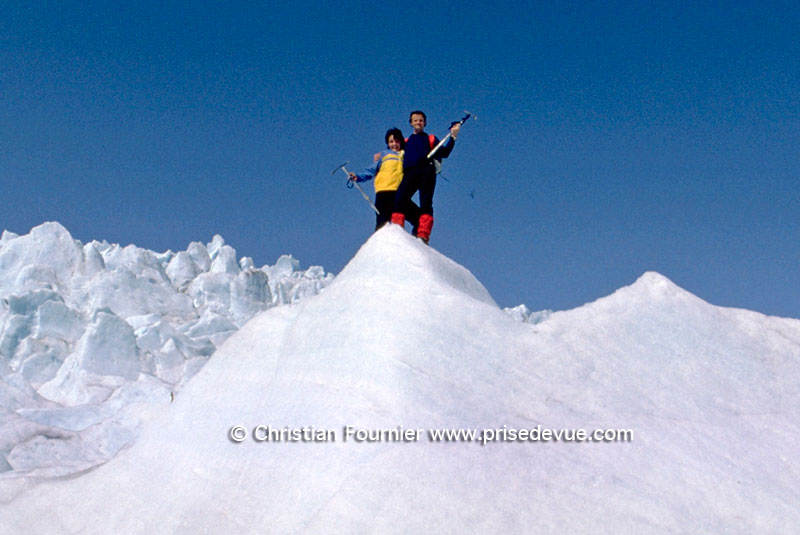
|
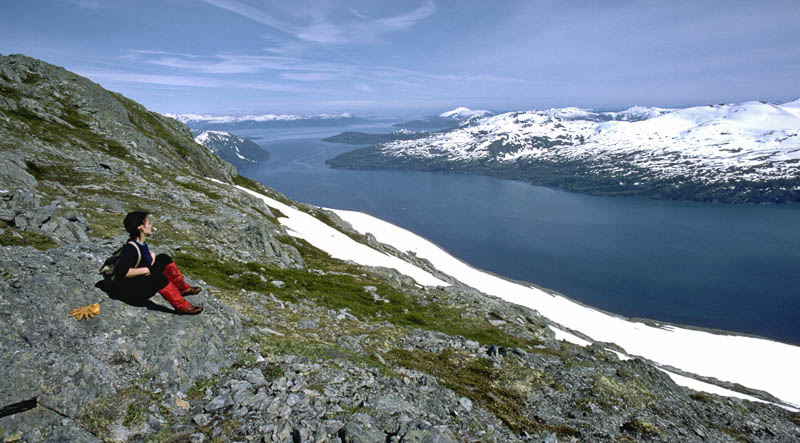
|
How did I get there?
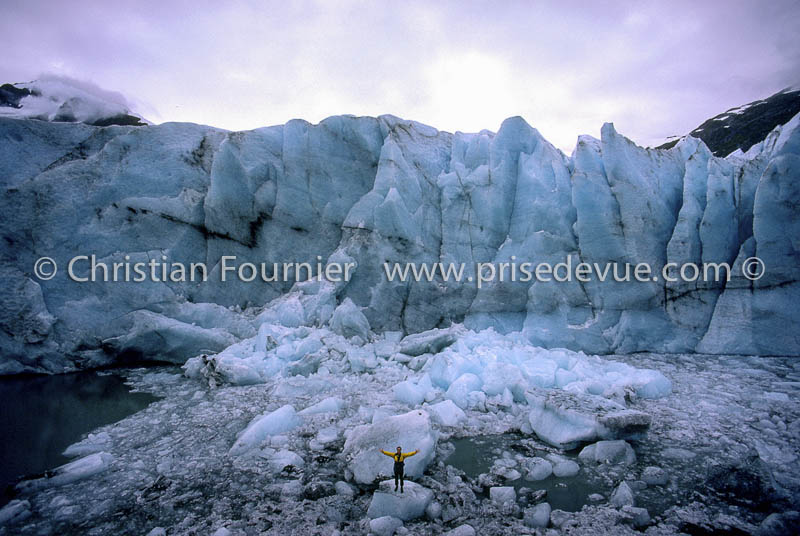
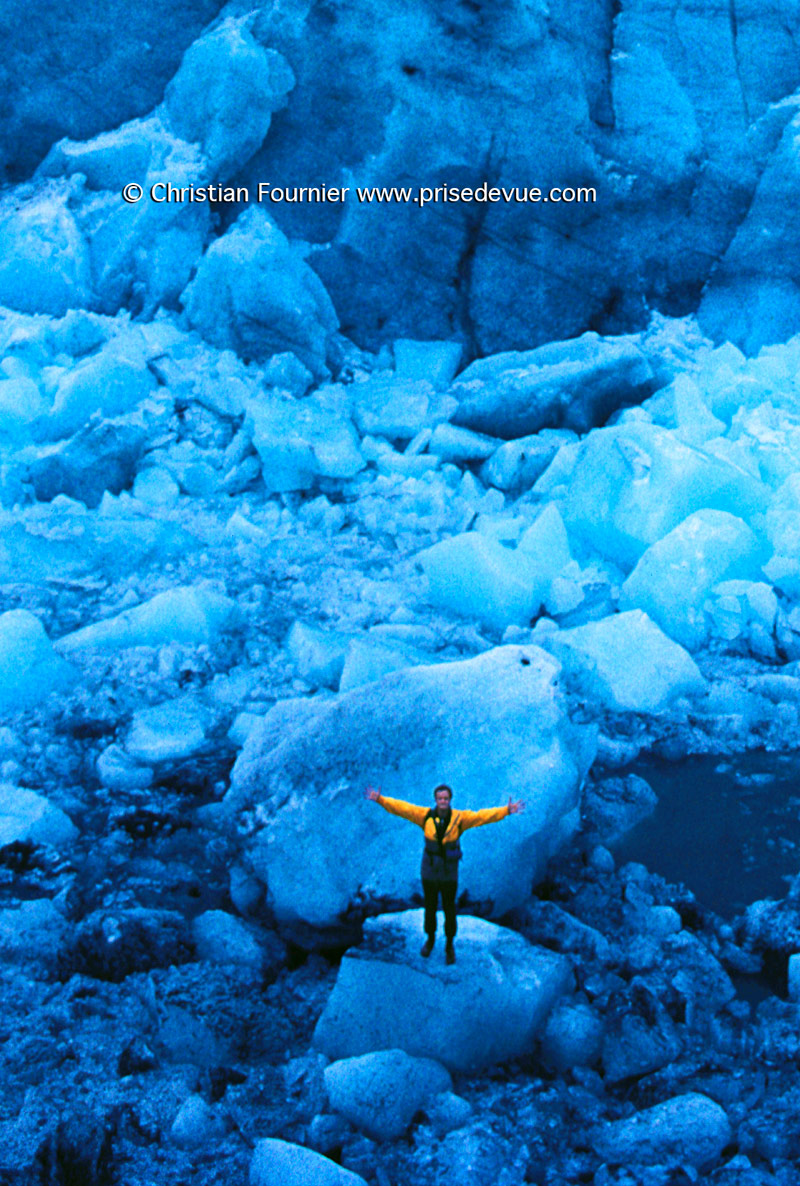
TEXT AND PHOTOS: CHRISTIAN FOURNIER
All of the photos were taken in Alaska, on the famous
Mendenhall Glacier.
Mendenhall Glacier is large glacier in southeast Alaska, about
10 km from Juneau, the capital city.
The season is, of course summer. It is often nice out and
sweaters are often stowed back into backpacks.
The special aspect of this glacier is that the Americans built
an asphalt road that brings tourists right in front. A visitor
center has also been built on the edge of the lake beside the
glacier. This makes it the easiest to visit glacier in the
world.
For climbers like us, it is also much easier: we park our car
at the visitor centre, then we walk an hour or two along the
small mountain trail which follows alongside the glacier. When
the glacier becomes accessible, that is to say without two many
crevasses or frequent landslides, as is the case on the
shredded end of a glacier, we lace up our crampons beneath our
mountain shoes and jump onto the ice.
And it becomes fantastic: we discover crevaces, streams (the
surface ice melts), waterfalls, small blue lakes, tunnels
(formed by the flowing surface water), and caves with crystal
walls. We each have crampons, a pick, and a rope. This allows
us to climb even very steep slopes with relative ease, even
vertical walls. We also like to jump across small walls,
sticking ourselves to the opposite sides like flies. And I, the
photographer, descend to the bottom to immortalize my
companions who seem to fly above my head.
The only danger along our hikes across the glacier is that the
surface on which we are walking can collapse. So it is
important to listen for the sounds of flowing water so as to
avoid walking upon the roof of an underground river, and to
“tap” the terrain with our pick.
I love the silence of the glacier: only the sounds of trickling
water and the crackling of the ice. I love the different blues
that the sun creates through the ice. I love the silences
shared between climbers. I love sharing, through my photos, the
beauty of what I’ve seen.
|
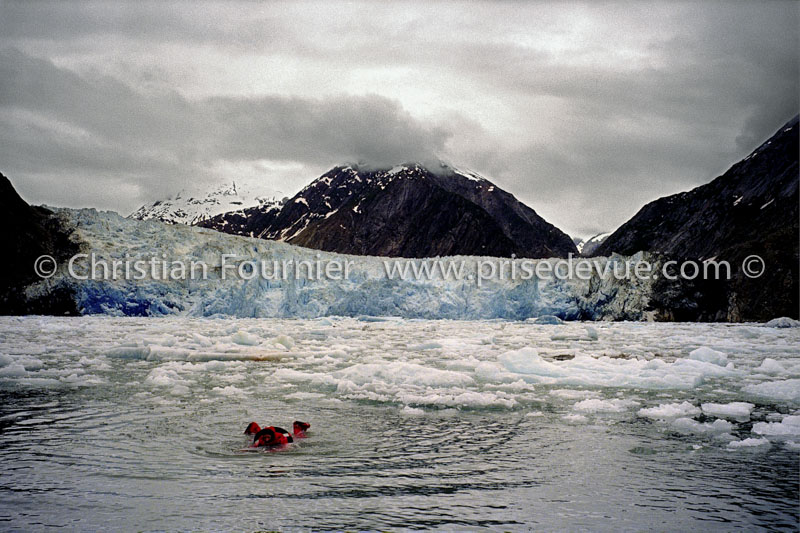
Survival suits in Tracy Arms, Alaska, July 1990. Combinaisons
de survie à Tracy Arms, Alaska, juillet 1990
This strange orange object floating on the
water is not a new breed of seal but a human being wearing a
survival suit. These suits are mainly made for people like
fishermen, who navigate on cold waters. In low temperature
waters (less than 45 °F), one could not survive more than ten
minutes without special equipment. Based on the principles of a
dry suit, a survival suit will allow a person immersed in cold
water to survive for several hours (this length of time depends
on many factors such as the water and the outside temperatures,
the resistance against cold of the person... ) However, unlike
dry suits, these suits are not designed for diving purposes but
for survival only. They are about 1/4 inch thick. Boots and
gloves are attached for better protection, as well as a hood. A
front zipper closes the suit up to the chin, the front seal and
a piece of neoprene placed over the mouth and the nose provide
a relative waterproofing. Buoyancy is achieved by two different
ways. As mentioned above, the survival suit is made out of
neoprene rubber that contains millions of tiny insulating cells
filled with air, making the suit very buoyant. In addition, a
balloon-like ring attached to the suit under the arms can be
inflated by mouth using a hose included in the suit. Apart from
buoyancy, this ring provides a support to the neck and allows
the person to float without effort, head out of water. Thermal
insulation is not achieved, as commonly thought, by the suit
itself, but by the air trapped in the suit : this air is warmed
by the body and provides an effective insulation.
Unfortunately, in cold water, the heat loss is high and the
human body must continually compensate for this loss. At a
certain point, it becomes impossible for the body to keep up
and the body temperature drops ; eventually, the person will
die from hypothermia. Hopefully, rescuers will be there before
this happens. The color orange of the suit has not been chosen
for fashion reasons but because this is the color the most
easily detectable on the sea. These pictures were taken in
Tracy Arm (Alaska) during a safety drill, demonstrating the
efficiency of the suits. Six volunteers jumped from a lifeboat
into the ice cold water of Sawyer glacier, under the
indifferent eyes of harbor seals. After some paddling around,
these special bathers were given a flare used to draw
attention. Wet or even immersed, these flares continue to glow
with a bright orange "flame" signaling the position
to the rescuers. This drill has been conducted every week, for
more than three years now, on board the M/V VIKING SERENADE,
formerly M/V STARDANCER, during the Alaskan season, for the
delight of the passengers. Many crew members are looking
forward to this "icecapade", but the waiting list is
very long and only six suits are available on board ! Text by
Dr Nicole Bordes and Christian Fournier
Shannon Templeton: That's a memory I will never forget. The
suit I was wearing had a tiny pin hole near my ankle and a
little jet of icy water numbed the lower half of my leg really
quick. I still have my "official suit tester"
certificate somewhere written up in beautiful calligraphy.
Thank you for this memory!
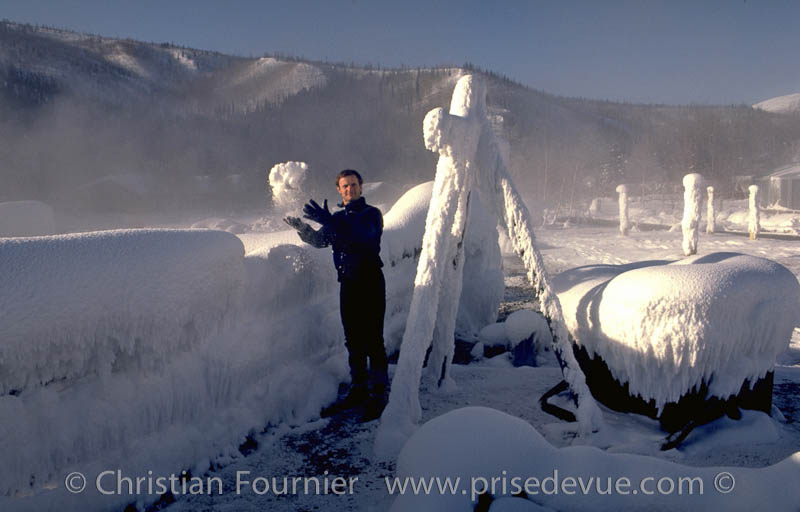
|
Arctic 1984: leaving from Bettles, Alaska, population 12, close to the North Pole, with the intrepid Barry Moss who now lives in Seffner, Florida.
It was Barry who initiated me, earlier, to glacier-climbing. We left together from Florida and we took planes which became smaller and smaller, and it became colder and colder.
Coming straight from Florida, it took me a week to start feeling well at - 40° (interestingly, this is where the Celsius and Fahrenheit scales meet up, -40° C = - 40° F)
At 40 degrees Celsius below zero, photography becomes very difficult: the films become brittle, the batteries stop working, the cold metal rips off your eyebrows, the frost created by your breath obstructs the viewfinder, you have 20 seconds max without gloves to change the film roll by pulling off your external glove (there is another, thinner polyprolene glove underneath). |
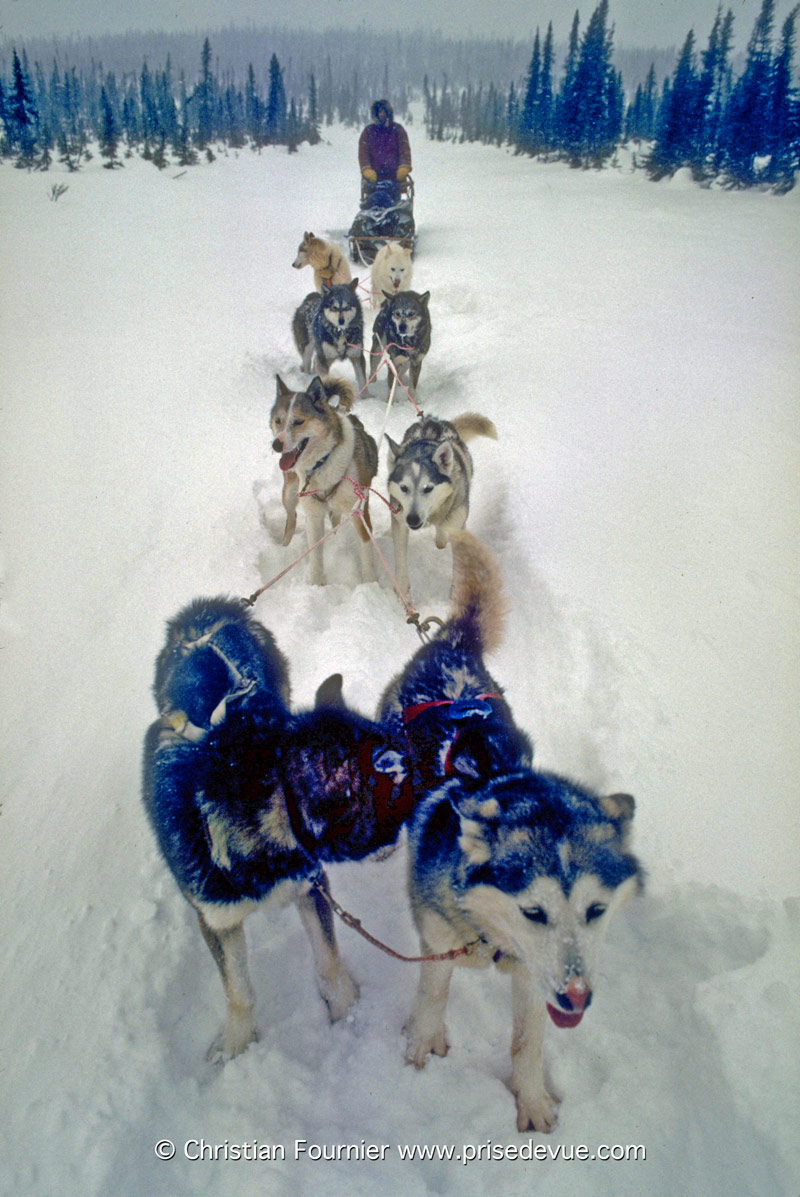
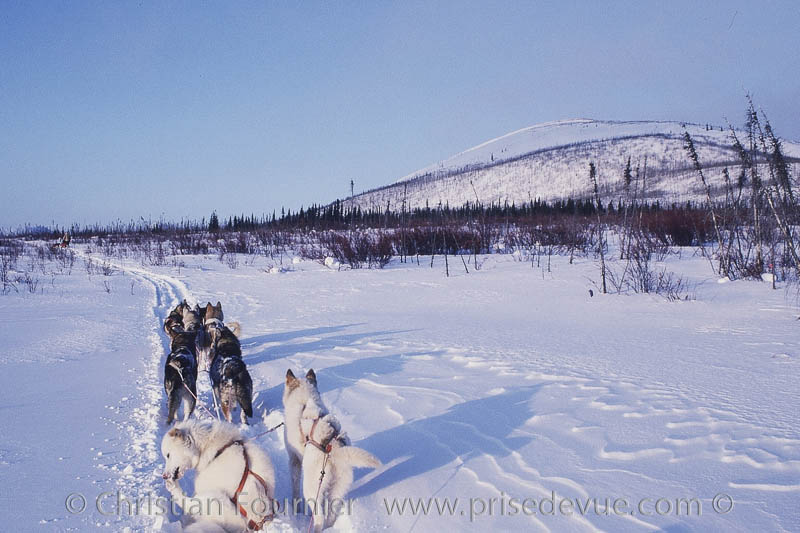
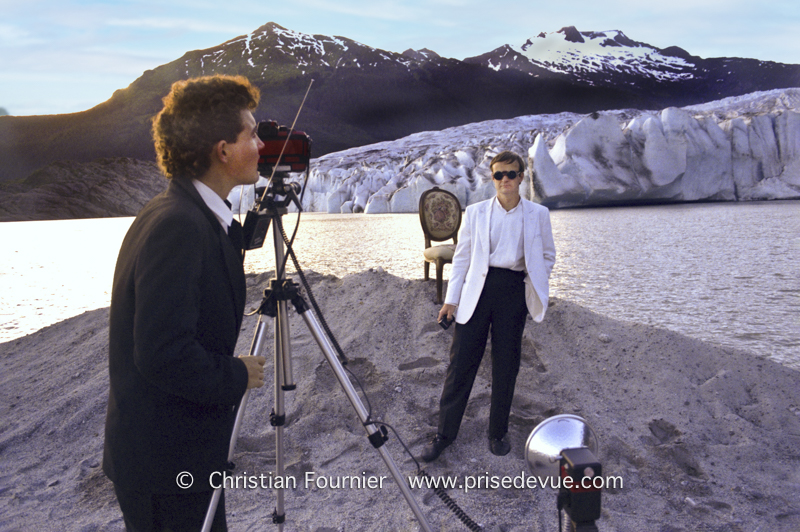
Victorian chair and tuxedos, Norman flash, not bad attire for a glacier. Nick Llellelyn in the foreground.
|
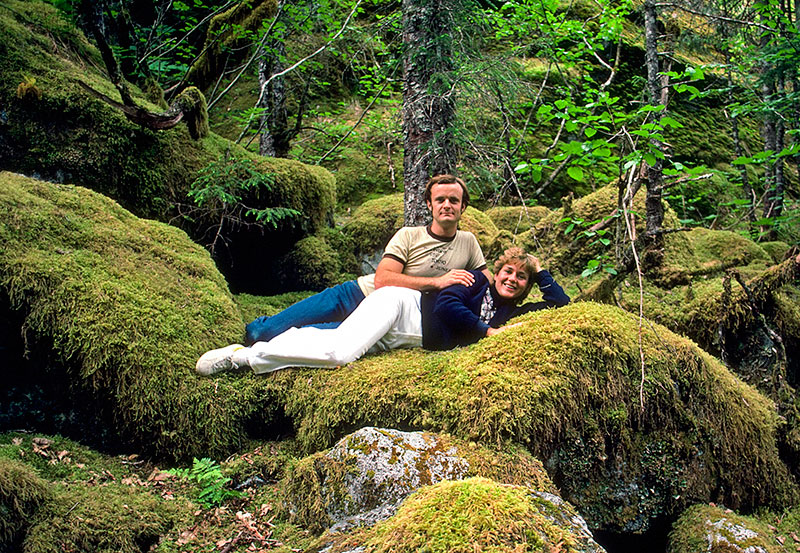
With Monique Chevillon, from Canada.
|
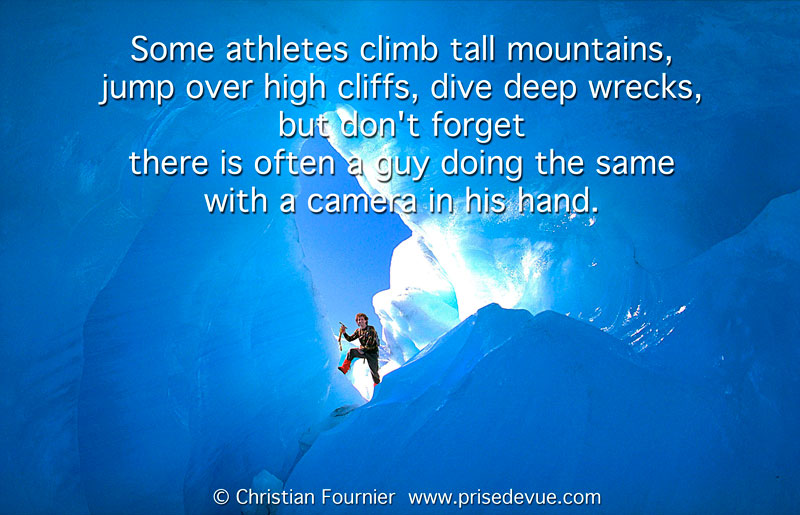
Athletes climb up high mountains, they jump from impressive cliffs, dive down deep to sunken wrecks, but let’s not forget there’s often someone else doing the same things with a camera.
|
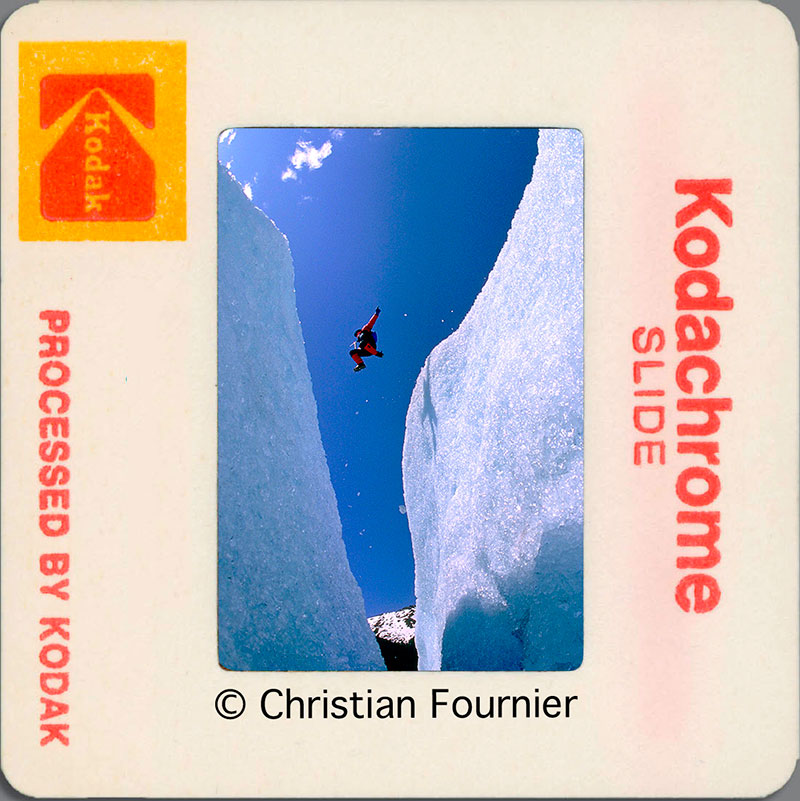
|
One of my photos was used to support the ad campaign for the launch of Windows 95. I’m more of a Mac-user, but the “client is king”, the customer is always right.

|
TEXT AND PHOTOS : CHRISTIAN FOURNIER
All of the photos were taken in Alaska, on the famous Mendenhall Glacier. Mendenhall Glacier is large glacier in southeast Alaska, about 10 km from Juneau, the capital city.
The season is, of course summer. It is often nice out and sweaters are often stowed back into backpacks.
The special aspect of this glacier is that the Americans built an asphalt road that brings tourists before its terminal wall. A visitor center has also been built on the edge of the lake beside the glacier. This makes it the glacier which is the easiest to visit in the world.
For climbers like us, it is also much easier: we park our car at the visitor centre, then we walk an hour or two along the small mountain trail which follows alongside the glacier. When the glacier becomes accessible, that is to say without too many crevasses or frequent landslides, as is the case on the shredded end of the glacier, we lace up our spikes under our mountain shoes and jump onto the ice.
And it becomes fantastical : we discover crevasses, streams (the surface ice melts), waterfalls, small blue lakes, tunnels (formed by the flowing surface water), and caves with crystal walls. We each have spikes, a pick, and a rope. This allows us to climb even very steep slopes with relative ease, even vertical walls. We also like to jump across small walls, sticking ourselves to the opposite sides like flies. And I, the photographer, I descend to the bottom to immortalize my companions who seem to fly above my head.
The only danger along our hike across the glacier is that the surface on which we are walking can collapse. So it is important to listen for the sounds of flowing water so as to avoid walking upon the roof of an underground river, and to “tap” the terrain with your pick.
I love the silence of the glacier: only the sounds of trickling water and the crackling of the ice. I love the different blues that the sun creates through the ice. I love the silences shared between climbers. I love sharing, through my photos, the beauty of what I’ve seen.
|
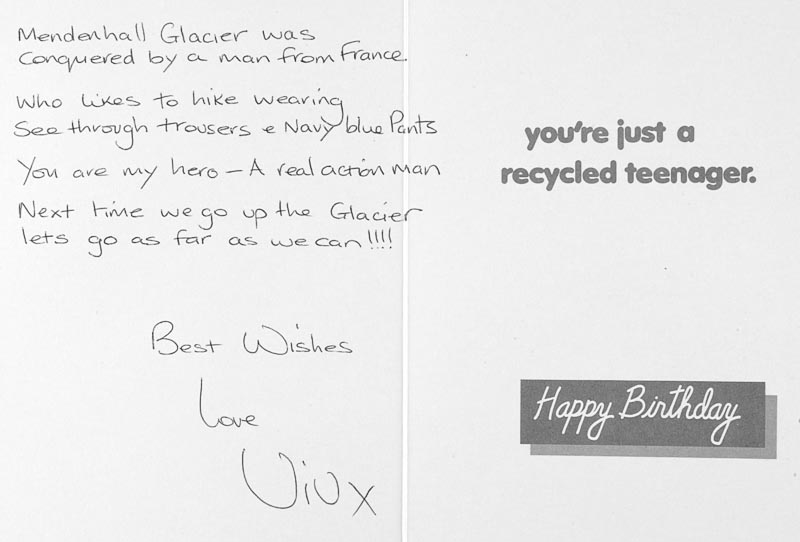
Mendenhall Glacier was conquered by a man
from France who likes to hikes wearing seethrough trousers and
navy blue pants.
You are my hero, a real action man. Next time we go up the
glacier, let's go as far as we can. Viv.
|
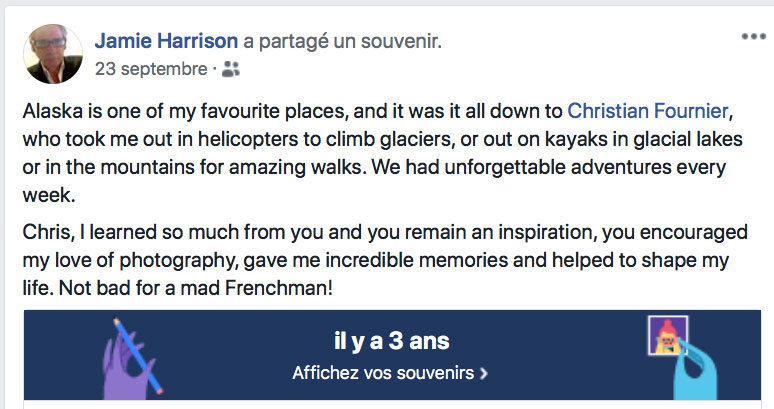 |
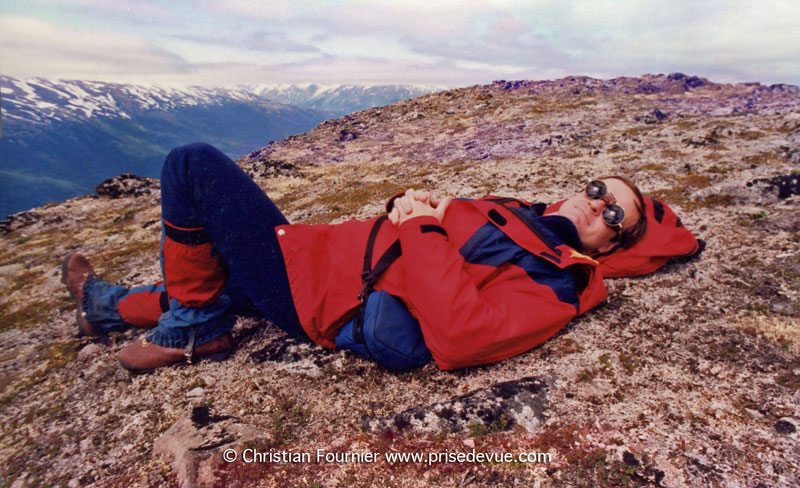
Charlie Dawson: "A view from the mountains surrounding Skagway, Alaska. Thanks to Christian Fournier (a world class photographer who now is FAMOUS in Paris) for giving me the push to go on these weekly expeditions... My friend Chris, the inspiration and leader of all our 'adventures' into the wilderness. A world class photographer from Paris, France."
|
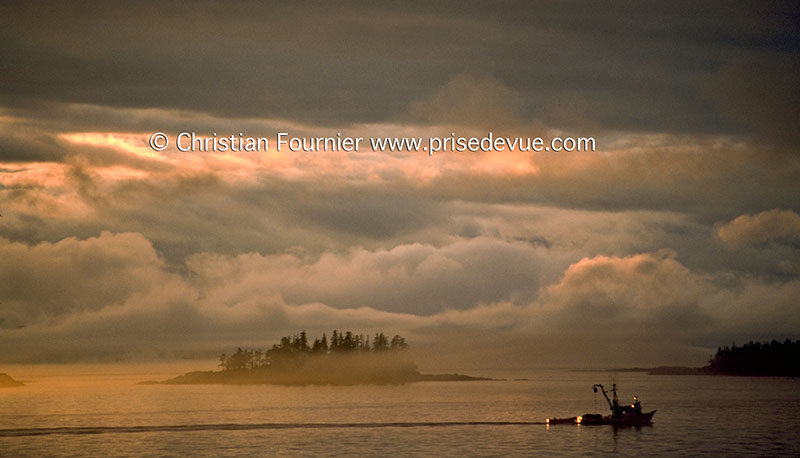
|
Glacier climbing is an exciting but
inherently dangerous sport.
1- Be in good shape. Glacier climbing is a strenuous activity
and demands a high level of fitness.
2- Take a safety course to learn the best methods of glacier
climbing. The knowledge is essential; glaciers are not your
average hike up a hill. There are many dangers present, as well
as techniques that you need to be aware of to ease the travel
on a glacier. ◦ Glaciers change over the day as the sun impacts
them; flows change, strength of ice changes, etc., and it is
important to have a solid understanding of these realities. ◦
It is also crucial to know how to use crampons, ice axes,
harnesses, and safety ropes.
3 - Understand glacial terrain. Glaciers generally consist of
both ice and rocky material. You will need to be proficient at
scrambling over the rocky material as well as climbing the ice.
This necessitates carrying gear, putting it on, and removing it
at various stages. ◦ Understand different types of moraine
(i.e., the messed up debris part of the glacier): lateral,
medial, and terminal. The moraine can impact your experience
quite dramatically. For example, if the moraine contains sand
and silt as well as rocks, this can make the surface slippery,
and when there has been ice melt and refreeze, there can be a
lot of mud as well. ◦ Some countries rate the glaciers
according to terrain and difficulty; consult tourist centers or
guide books for more information.
4 -Learn about glacier hazards. As part of your initial
learning on climbing a glacier, be sure to learn glacier rescue
techniques. Some important things to understand about glacier
hazards include:
5- Glaciers have crevasses (i.e., large cracks) and falling
down one often means death. Learning to avoid crevasses is the
first step; learning to arrest yourself or to help another
person when fallen down a crevasse is the next crucial
step.
6 - Crevasses are often very difficult to spot because they are
hidden under snow.
......
... 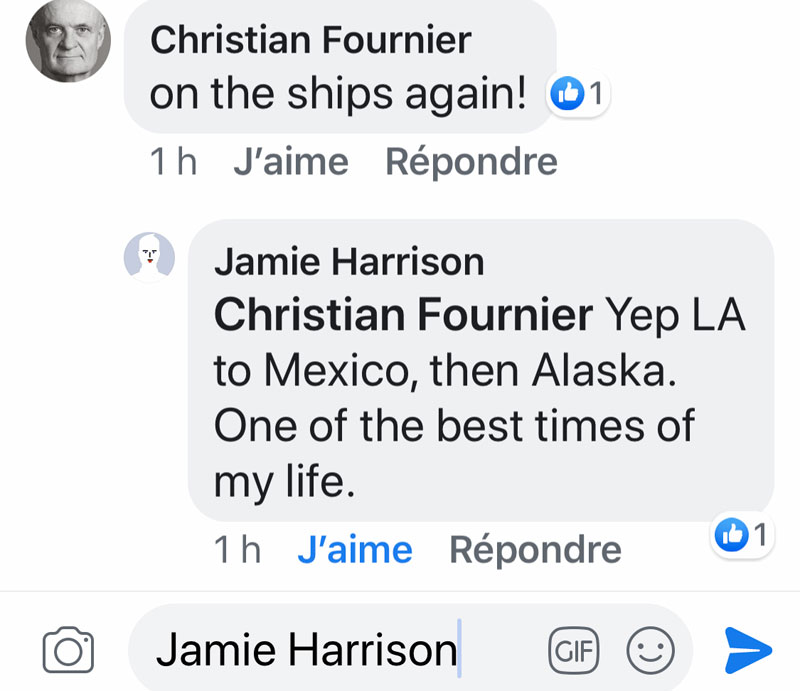
Jamie Harrison (ancien assistant) : Oui, De Los Angeles au Mexique, puis l'Alaska.
Un des meilleurs moments de ma vie.

|


























































































































 Shannon Templeton: "That's one of the things I've always
loved about you, Christian, your sense of humor. Who else would
take an inflatable palm tree and a stuffed red iguana out onto
a glacier in Alaska?! In a few hundred years someone will be
wondering how those got there ...
Shannon Templeton: "That's one of the things I've always
loved about you, Christian, your sense of humor. Who else would
take an inflatable palm tree and a stuffed red iguana out onto
a glacier in Alaska?! In a few hundred years someone will be
wondering how those got there ...






























